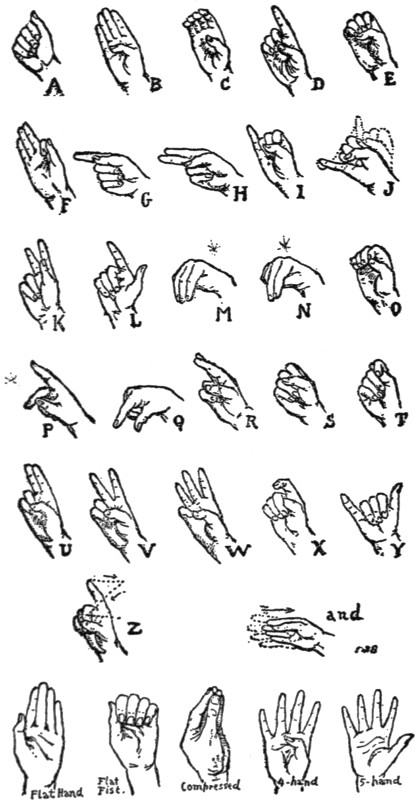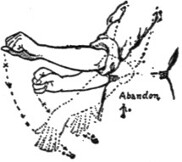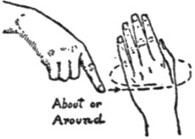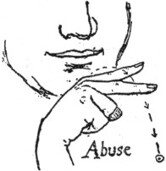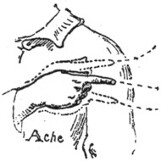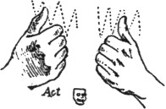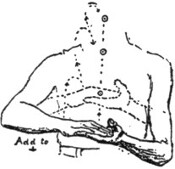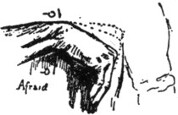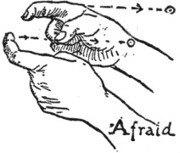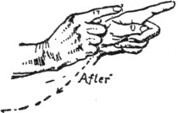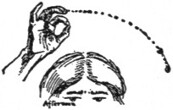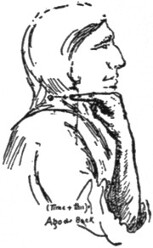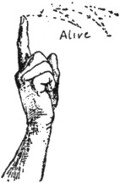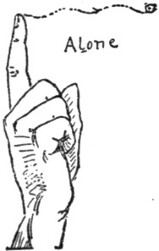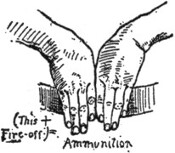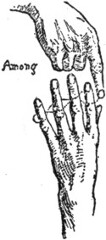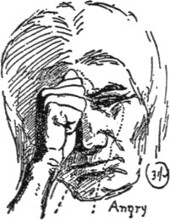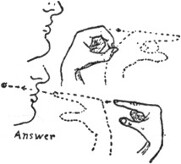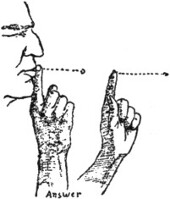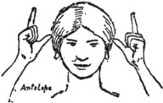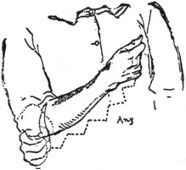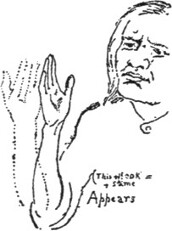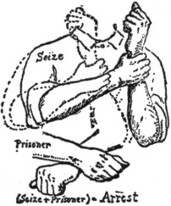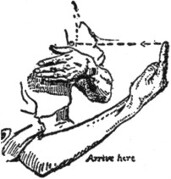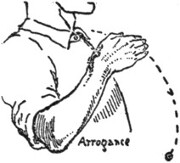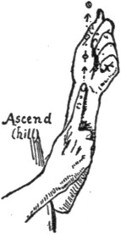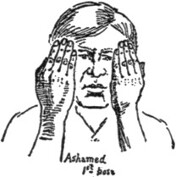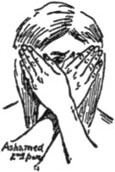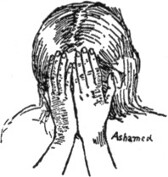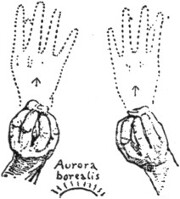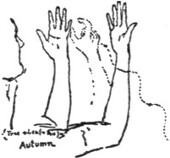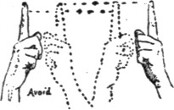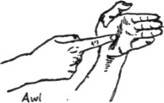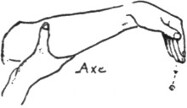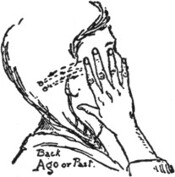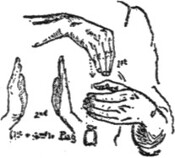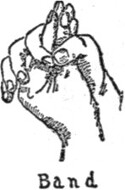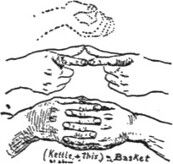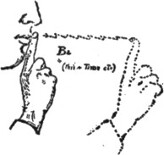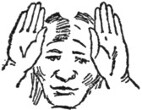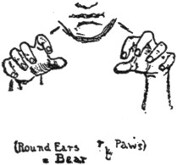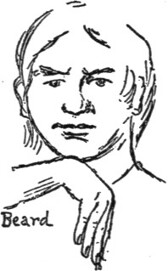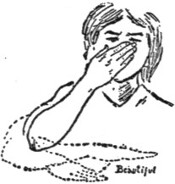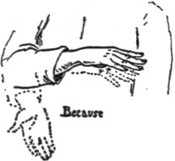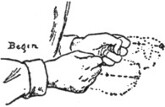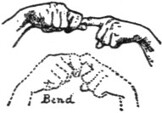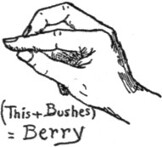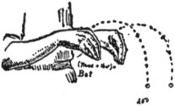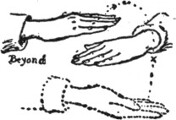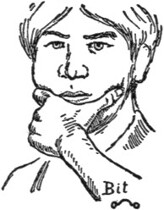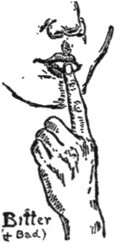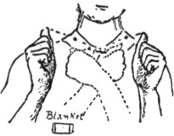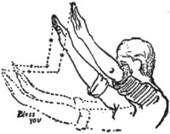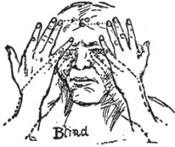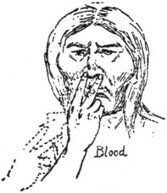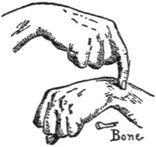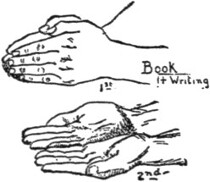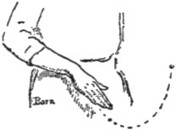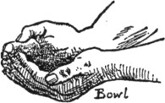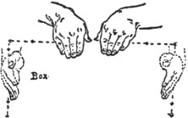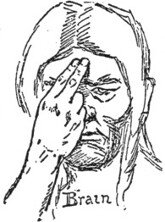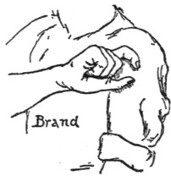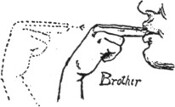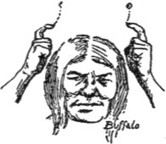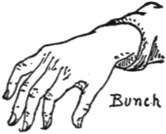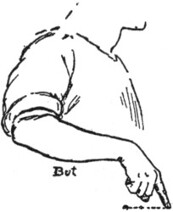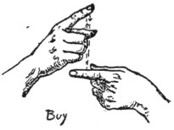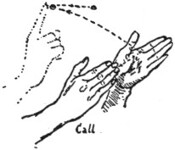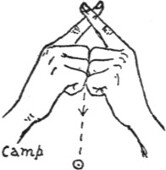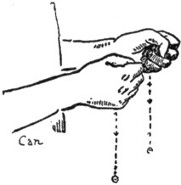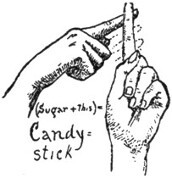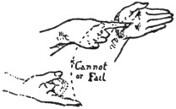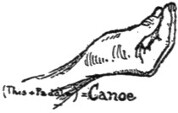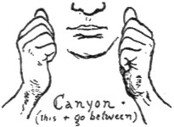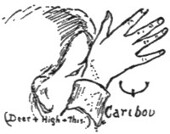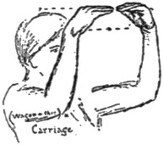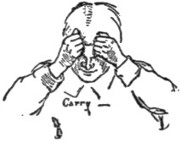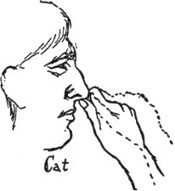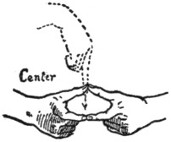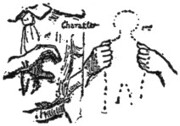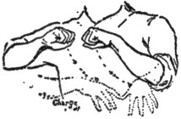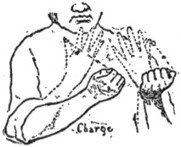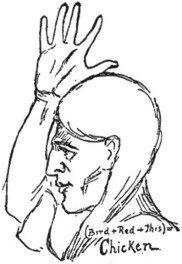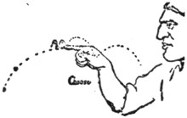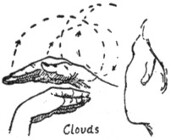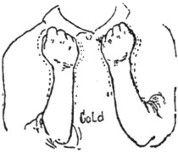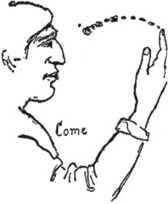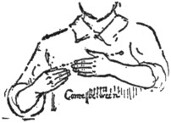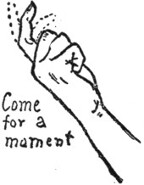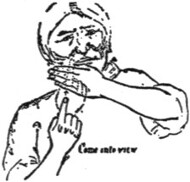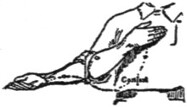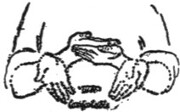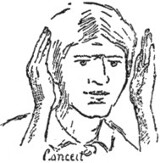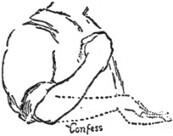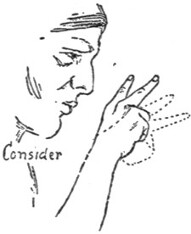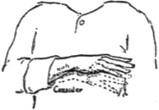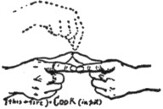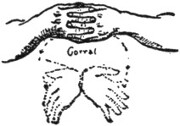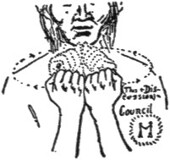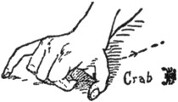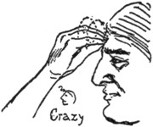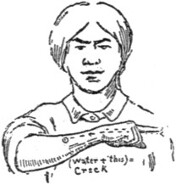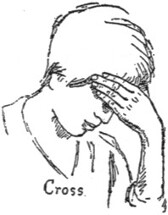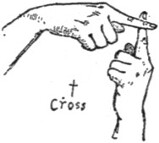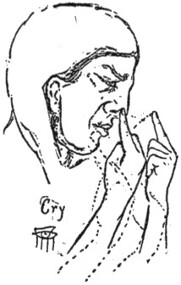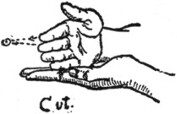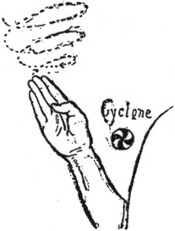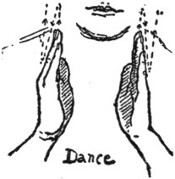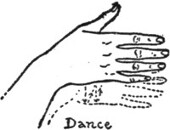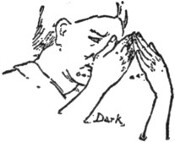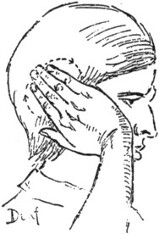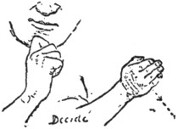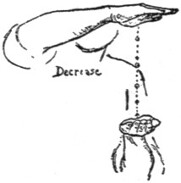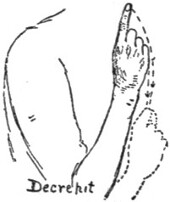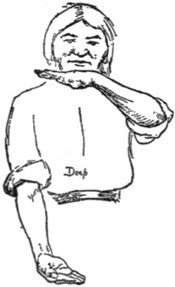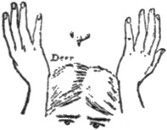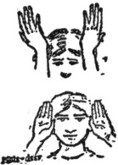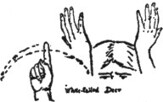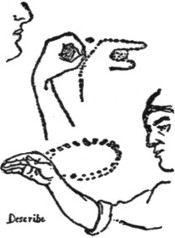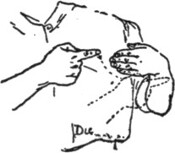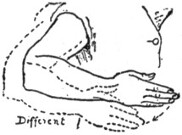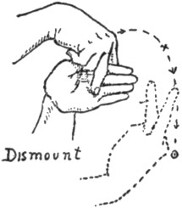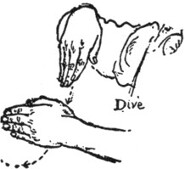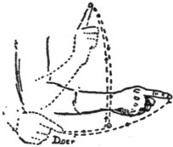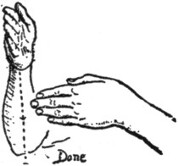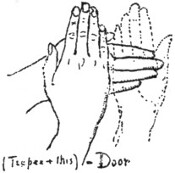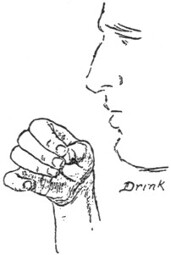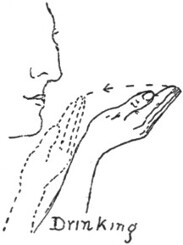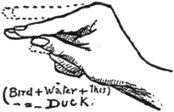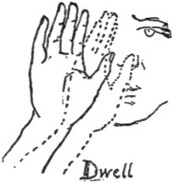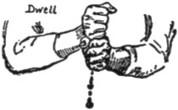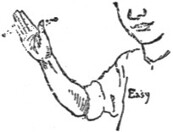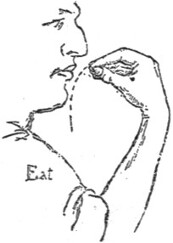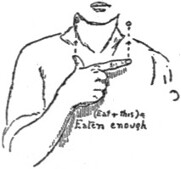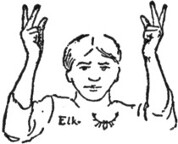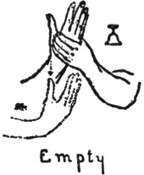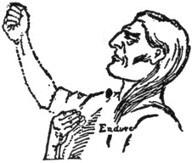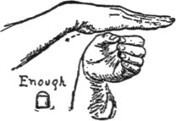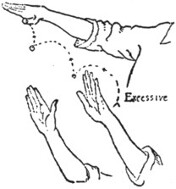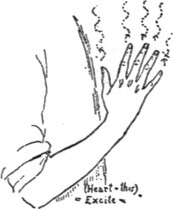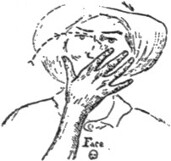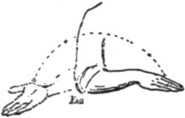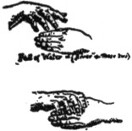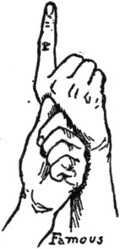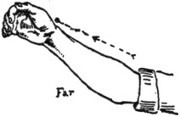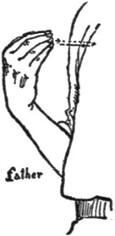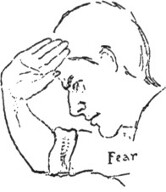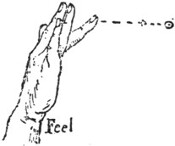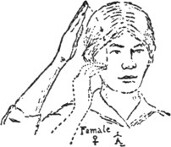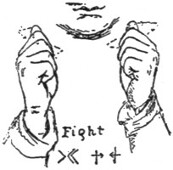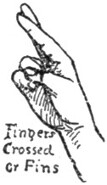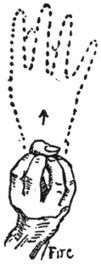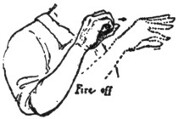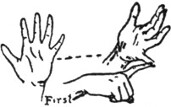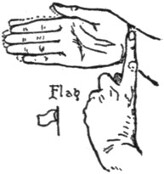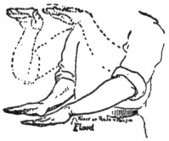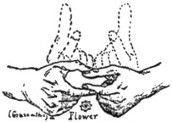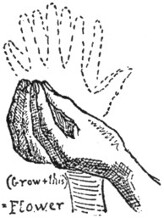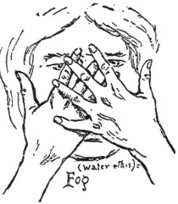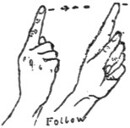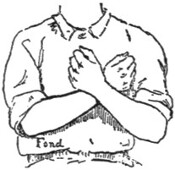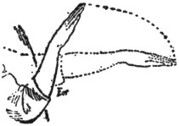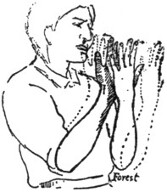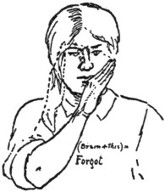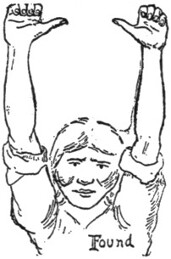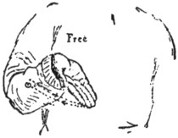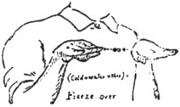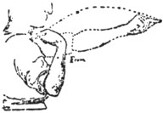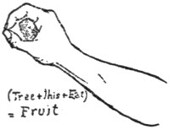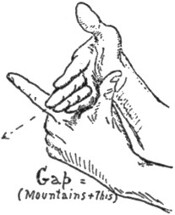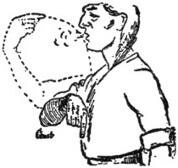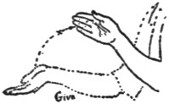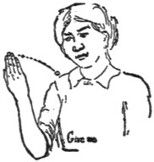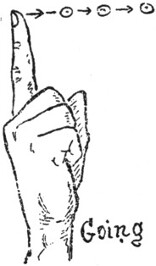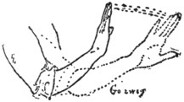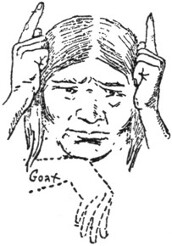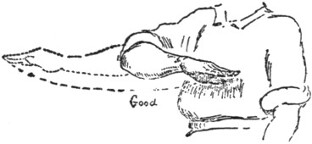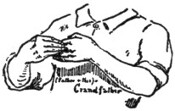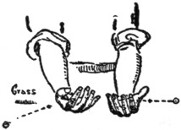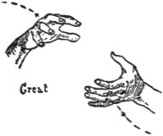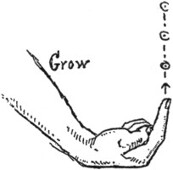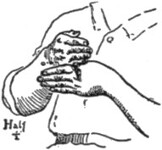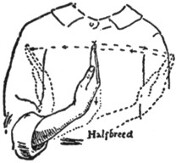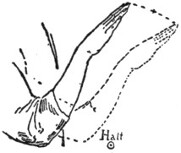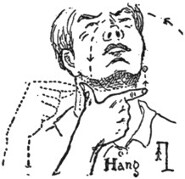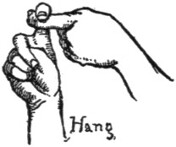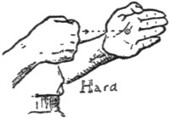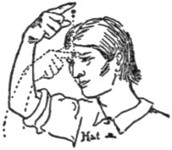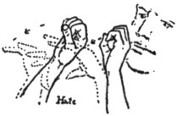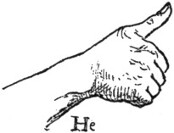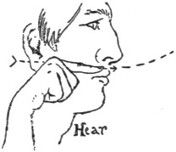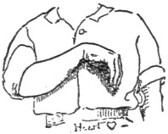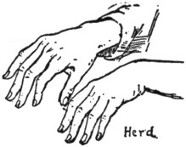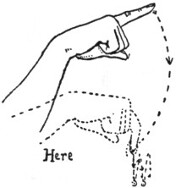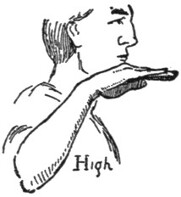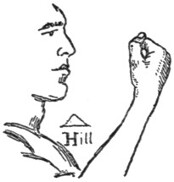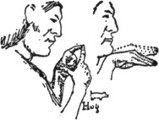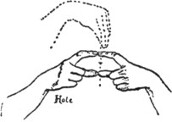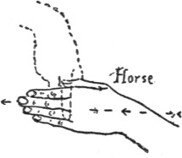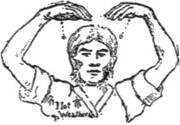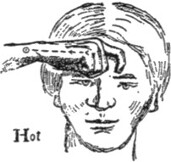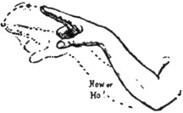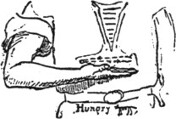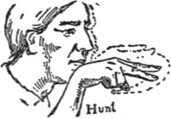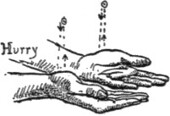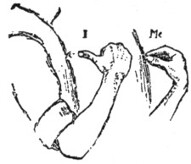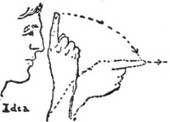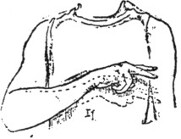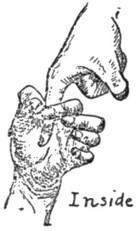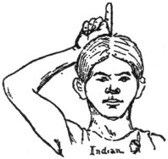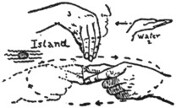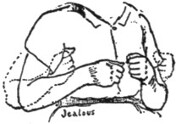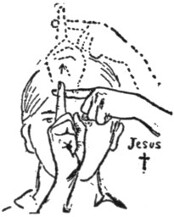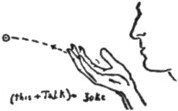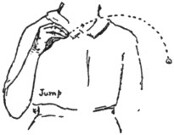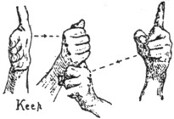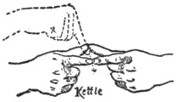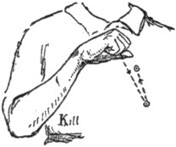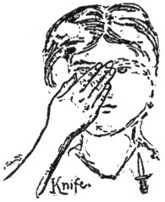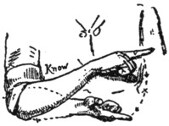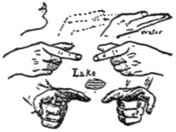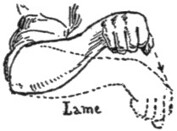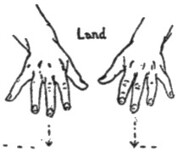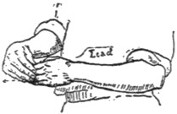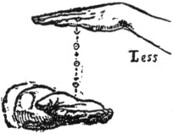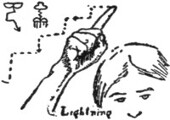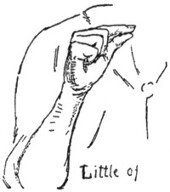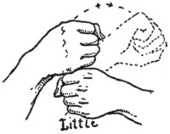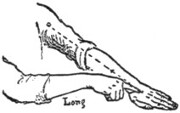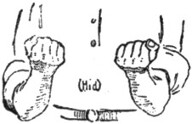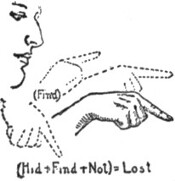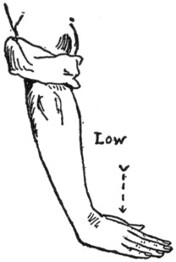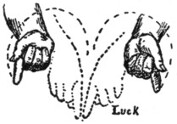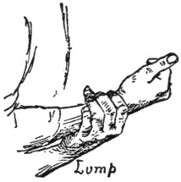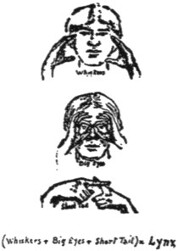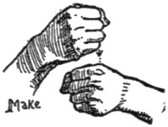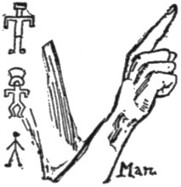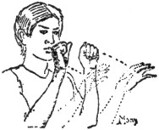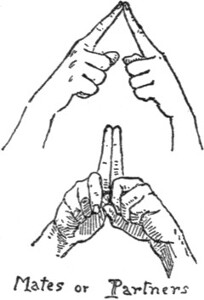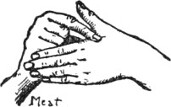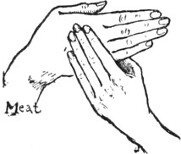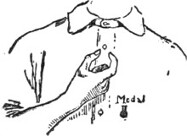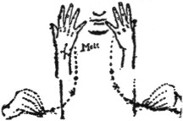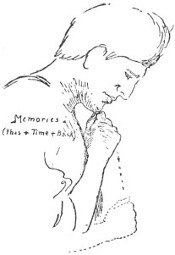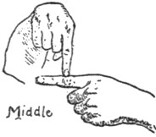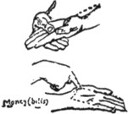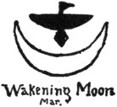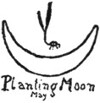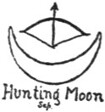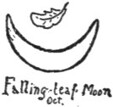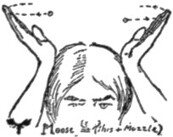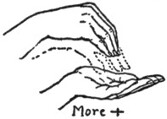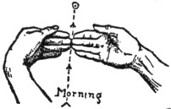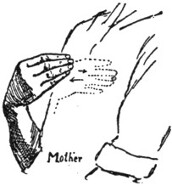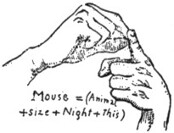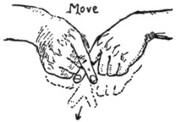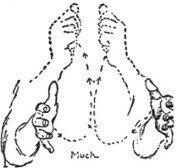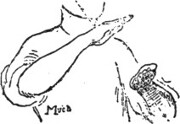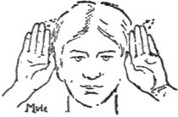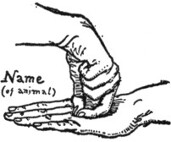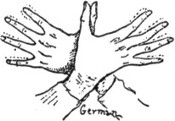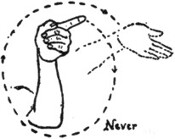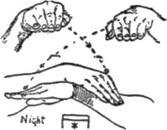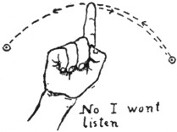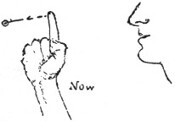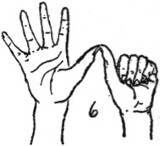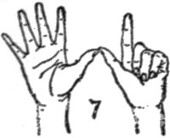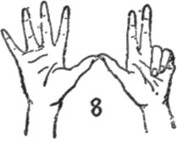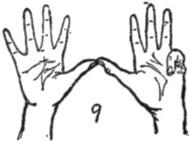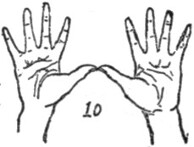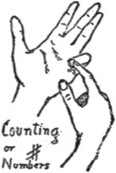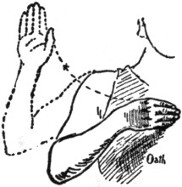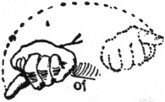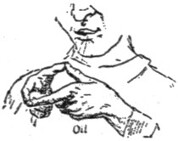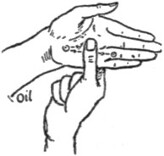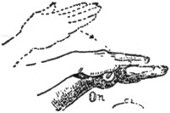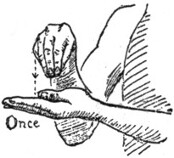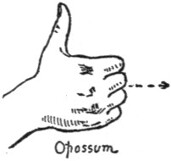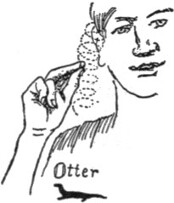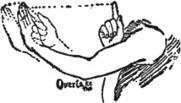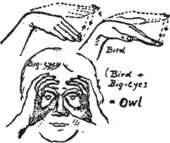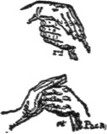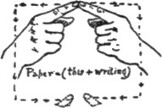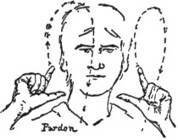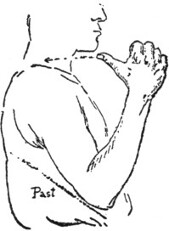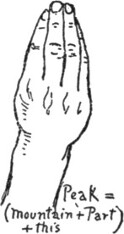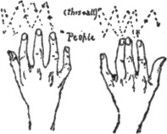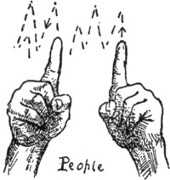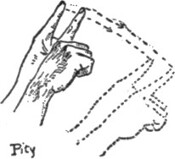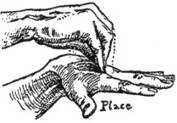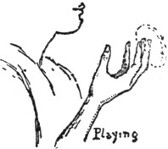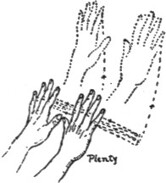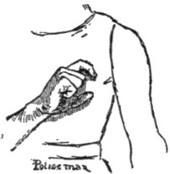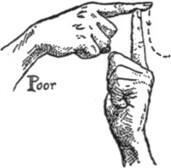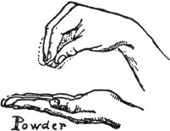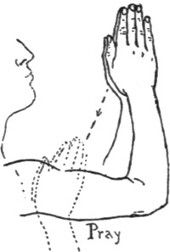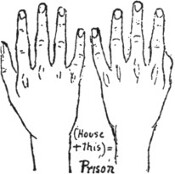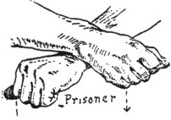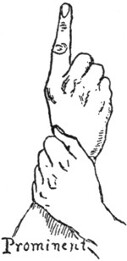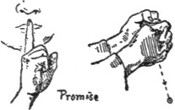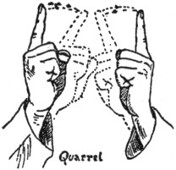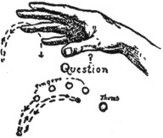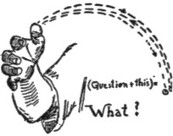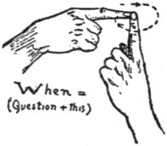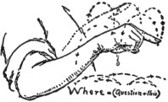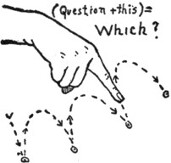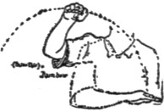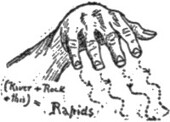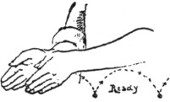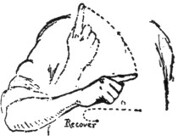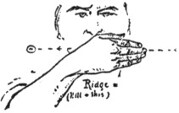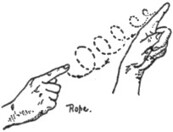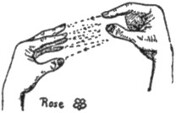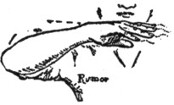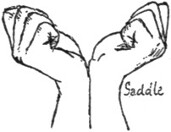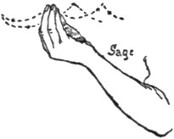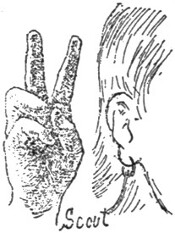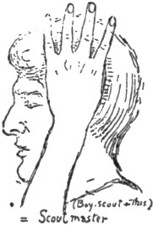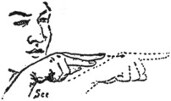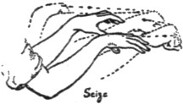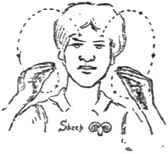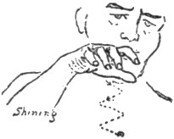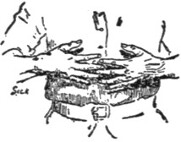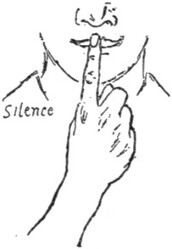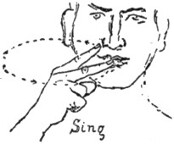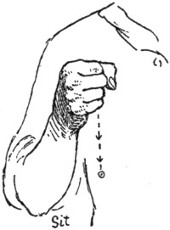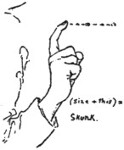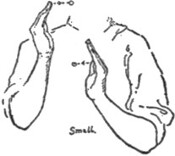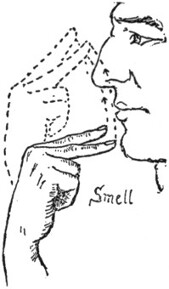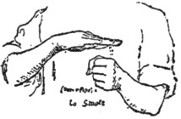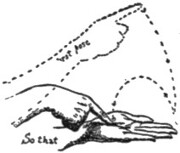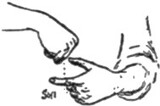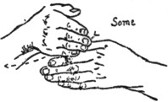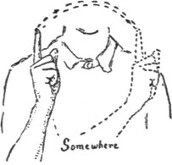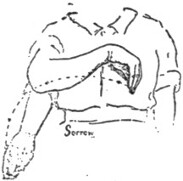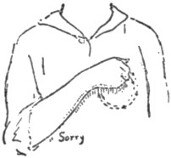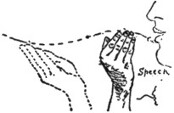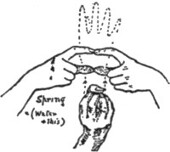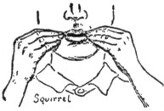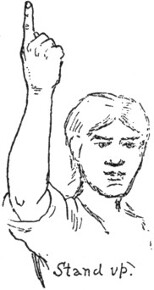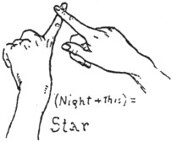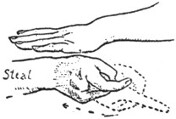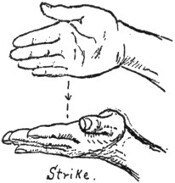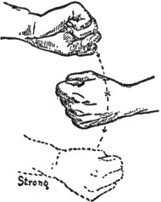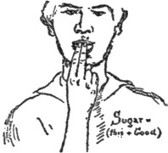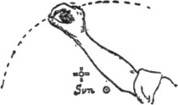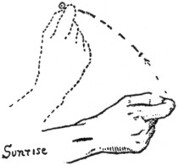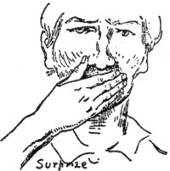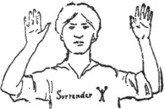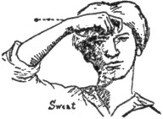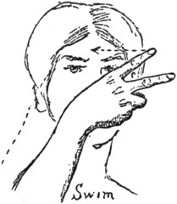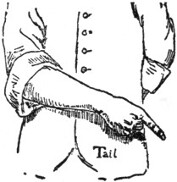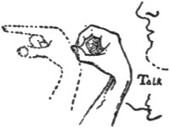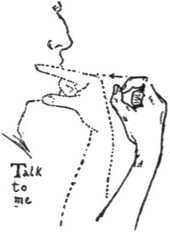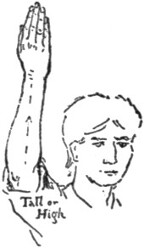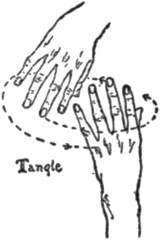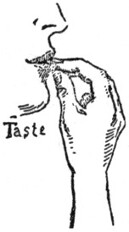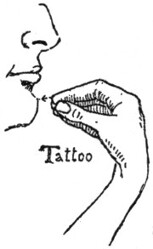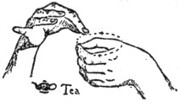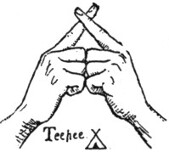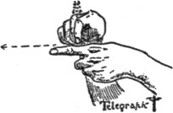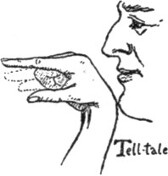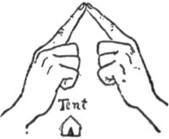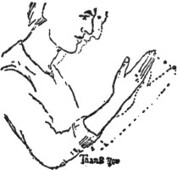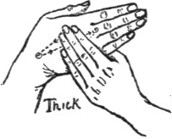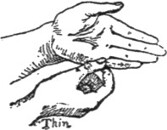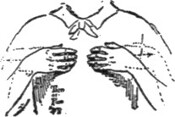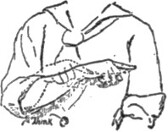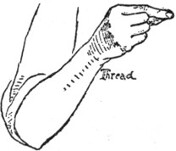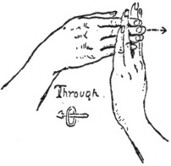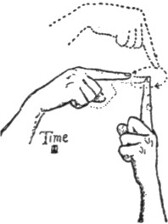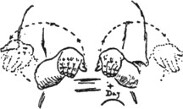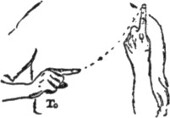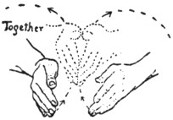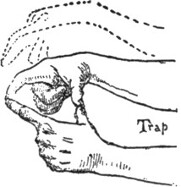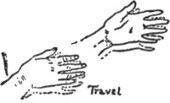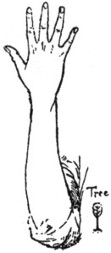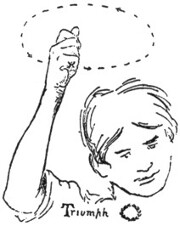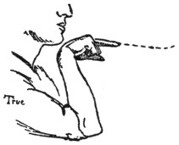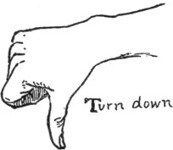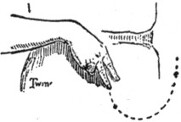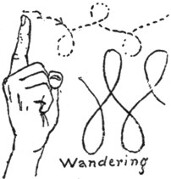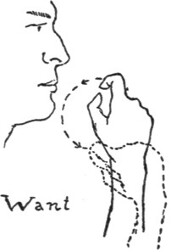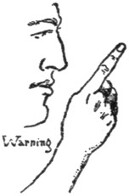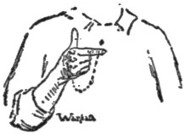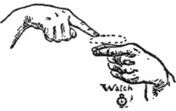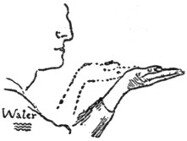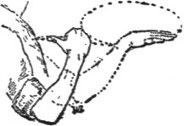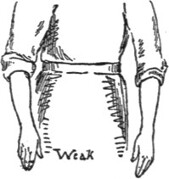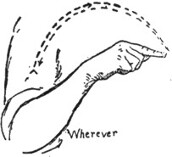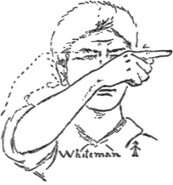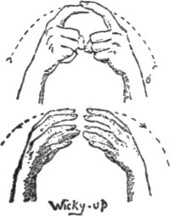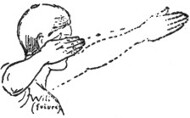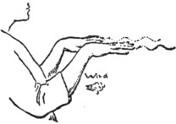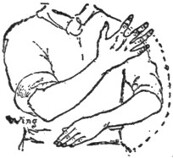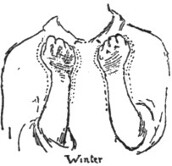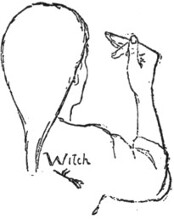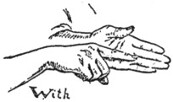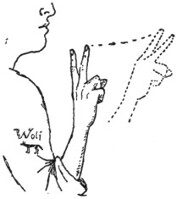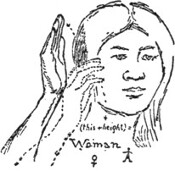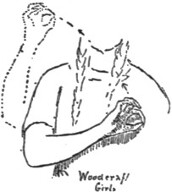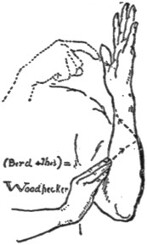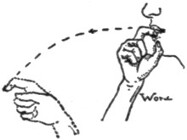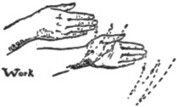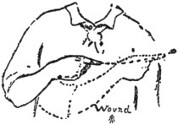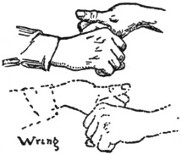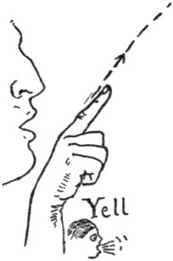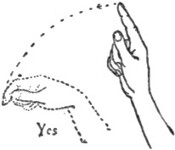The Project Gutenberg EBook of Sign Talk, by Ernest Thompson Seaton
This eBook is for the use of anyone anywhere in the United States and most
other parts of the world at no cost and with almost no restrictions
whatsoever. You may copy it, give it away or re-use it under the terms of
the Project Gutenberg License included with this eBook or online at
www.gutenberg.org. If you are not located in the United States, you'll have
to check the laws of the country where you are located before using this ebook.
Title: Sign Talk
A Universal Signal Code, Without Apparatus, for Use in the
Army, the Navy, Camping, Hunting, and Daily Life
Author: Ernest Thompson Seaton
Translator: Lillian Delger Powers
Other: Huge L. Scott
Release Date: January 16, 2016 [EBook #50938]
Language: English
Character set encoding: UTF-8
*** START OF THIS PROJECT GUTENBERG EBOOK SIGN TALK ***
Produced by Chris Curnow, Jennifer Linklater, and the
Online Distributed Proofreading Team at http://www.pgdp.net
(This file was produced from images generously made
available by The Internet Archive)
SIGN TALK
A Universal Signal Code, Without Apparatus,
for Use in the Army, the Navy,
Camping, Hunting, and Daily Life
By
Ernest Thompson Seton
Author of “Wild Animals I Have Known,” “Life Histories of Northern
Animals,” “The Book of Woodcraft,” etc., etc.
Chief of the Woodcraft League of America
THE GESTURE LANGUAGE OF THE
CHEYENNE INDIANS
With additional Signs used by other tribes,
also a few necessary Signs from the code
of the Deaf in Europe and America, and
others that are established among
our Policemen, Firemen,
Railroad Men, and
School Children
IN ALL 1,725
Prepared with assistance from
General Hugh L. Scott, U. S. A.
The French and German equivalent words added by
Lillian Delger Powers, M. D.
700 ILLUSTRATIONS BY THE AUTHOR
GARDEN CITY NEW YORK
DOUBLEDAY, PAGE & COMPANY
1918
Copyright, 1918, by
Ernest Thompson Seton
All rights reserved, including that of
translation into foreign languages,
including the Scandinavian
PREFACE
In offering this book to the public after having had
the manuscript actually on my desk for more than nine
years, let me say frankly that no one realizes better than
myself, now, the magnitude of the subject and the many
faults of my attempt to handle it.
My attention was first directed to the Sign Language
in 1882 when I went to live in Western Manitoba.
There I found it used among the various Indian tribes
as a common language, whenever they were unable
to understand each other’s speech. In later years I
found it a daily necessity when traveling among the
natives of New Mexico and Montana, and in 1897, while
living among the Crow Indians at their agency near
Fort Custer, I met White Swan, who had served under
General George A. Custer as a Scout. He had been sent
across country with a message to Major Reno, so escaped
the fatal battle; but fell in with a party of Sioux, by whom
he was severely wounded, clubbed on the head, and left
for dead. He recovered and escaped, but ever after was
deaf and practically dumb. However, sign-talk was
familiar to his people and he was at little disadvantage
in daytime. Always skilled in the gesture code, he now
became very expert; I was glad indeed to be his pupil,
and thus in 1897 began seriously to study the Sign
Language.
In 1900 I included a chapter on Sign Language in my
projected Woodcraft Dictionary, and began by collecting
all the literature. There was much more than I expected,
for almost all early travellers in our Western
Country have had something to say about this lingua
franca of the Plains.
As the material continued to accumulate, the chapter
grew into a Dictionary, and the work, of course, turned
out manifold greater than was expected. The Deaf,
our School children, and various European nations, as
well as the Indians, had large sign vocabularies needing
consideration. With all important print on the
subject I am fairly well conversant, besides which I have
had large opportunities in the field and have tried to
avail myself of them to the fullest extent, carrying my
manuscript from one Indian tribe to another, seeking
out always the best sign-talkers among them, collecting
and revising, aiming to add all the best signs in use to
those already on record.
The following are the chief printed works on Sign
Language:
1823. The Indian Language of Signs by Major
Stephen H. Long, published in his Expedition to the
Rocky Mts., 1823, Vol. I, pp. 378–394. Gives 104 signs.
The earliest extensive vocabulary on record.
1880. Gesture Signs and Signals of the North
American Indians by Lieut. Col. Garrick Mallery. An
elaborate and valuable 330 page quarto compilation
from many contributors; published by the Bureau
of American Ethnology of the Smithsonian Institution,
1880.
It was preliminary to the much more extended work
published the year following, and combines in itself
all the important vocabularies published up to that
time, including: Wm. Dunbar’s List pub. Trans. Am. Phil.
Soc., January 16, 1801; about 60 signs; Prince Maximilian
von Wied-Neuwied’s List, Reise, Nord. Am.,
1832–34, 1837; Capt. R. F. Burton’s List pub. in “The
City of the Saints,” 1862; Dr. D. G. MacGowan’s List
pub. in Historical Magazine, Vol. X, 1866, pp. 86–97;
also Manuscript Lists supplied by Col. R. I. Dodge,
Dr. William H. Corbusier, U. S. A., and about forty other
contributors.
1881. Sign Language Among the North American
Indians compared with that among other peoples and
Deaf Mutes, by Col. Garrick Mallery; 290 page quarto,
286 illustrations, an elaborate examination of the history,
origin, and nature of the Sign Language, with extensive
vocabularies. Published in 1st Annual Report, Bureau
of American Ethnology, 1881.
1885. The Indian Sign Language by Capt. William
Philo Clark, U. S. A., 244 pp. octavo, quite the best book
on the subject, giving over 1,000 signs with photographic
exactness; it is also one of the best early encyclopedic
books on Indians in general; unfortunately, it is without
illustrations and is out of print. Published by Hamersly
& Co., of Philadelphia, 1885.
This is practically the only publication quoted in preparing
this work. I have referred to it continually as a
standard—as the highest available authority. (W. P.
Clark was born July 27, 1845, at Deer River, Lewis Co.,
New York. Graduated from West Point June 15, 1868.
Served on the Plains in 2d Cavalry during the Indian
wars of 1876 to 1880. Died at Washington, D. C.,
September 23, 1884.)
HADLEY INDIAN SIGN PRINTS
About twenty-five years ago there lived in Anadarko,
Indian Territory, an enthusiastic missionary worker
named Lewis F. Hadley, known to the Indians as Ingonompashi.
He made a study of Sign Language in order to furnish
the Indians with a pictographic writing, based on diagrams
of the signs, and meant to be read by all Indians,
without regard to their speech. Pointing to the Chinese
writing as a model and parallel, he made a Sign Language
font of 4,000 pictographic types for use in his projected
works. He maintained that 110,793 Indians were at
that time sign-talkers and he proposed to reach them by
Sign-Language publications.
In pursuance of his plan, he issued the following:
1887. List of the Primary Gestures in Indian Sign
Talk. “Only 19 copies were printed.” It was intended
as a prodrome to “extended works and a magazine in
Hands-tal[k]ing.”
It consists of 63 pages with 684 crude woodblocks of
white lines on black ground, illustrating signs, alphabetically
arranged, but without captions or text of any kind,
except the explanation on the title page, abridged as above.
1890. A Lesson in Sign Talk, designed to show the
use of the line showing the movement of the hands in the
Indian Gesture Language, by In-go-nom-pa-shi, Fort
Smith, Ark., 1890. Copyrighted by Lewis F. Hadley,
12 pp. A portrait of him by himself is on p. 11, inscribed
“In-go-nom-pa-shi, drawn by himself at 60 years.”
It devotes 3 pages to general discussion of Sign Talk, 1½
pages to reform of our spelling, the rest is given to general
remarks with 12 poor illustrations in white line, also a
Scripture text with 15 signs drawn, the Lord’s Prayer
with 55 drawn signs, and on p. 12, The Indian Little Star,
a novel version of “Twinkle, Twinkle,” rendered in 97
drawn signs.
1893. Indian Sign Talk. Being a Book of Proofs of
the matter printed or equivalent cards designed for teaching
sign-talking Indians as much English as can be explained
through the medium of their “Universal” Gesture
Language, by Ingonompashi, copyrighted May 15,
1893, “only 75 copies are saved.”
This is Hadley’s most extended work. It is a dictionary
of the Sign Language, in 268 large octavo leaves
printed on one side only of each sheet.
It consists of 9 pages of Preface and general matter,
192 pp. of dictionary alphabetically arranged, each page
having three gestures figured and beside each the equivalent
in English. A total of 577 signs (including a double).
Pages 193 to 205 are given to small reproductions of the
sign drawings to illustrate “measurements of type”—his
font—about 800 illustrations, two pages of appendix
with compound sign words, and 14 illustrations, 1 page
of black type, 18 in number, 53 pages of reading matter
in signs, the above cited version of “Twinkle, Twinkle,
Little Star” and the story of “Wolf and the White Man”
in signs; the rest being Scripture texts and exhortations
and the 19th Psalm, ending with the Lord’s Prayer.
The cards referred to I have. They consist of 571 separate
cards with an illustrated sign on each and additional
matter on the back. Besides which there are
about 100 separate cards each with a scripture text,
chapter, or sermonette on it, about 1,000 illustrations
in all. The same being the matter of the dictionary
proper reproduced on separate cards, the diagram on one
side and the text on the other. The front matter and the
type measurements do not, however, appear on the cards.
Though poor as art, the drawings are of some value to
the student.
This is the most ambitious work extant on the subject
of Sign Language, but seems to be quite unknown to most
ethnologists, and is not in any library, so far as I can learn,
except the Library of Congress, the Smithsonian Institution,
the New York Public Library, the Library of
Prof. J. C. Elsom of Wisconsin State University, and my
own collection.
Of the 75 copies issued, only these 5 have been accounted
for, but cards comprising the dictionary part
were issued to the extent of 100,000 in sets of 571 each,
and the reading matter on cards to the number of over
27,000.
1910. The Sign Language, by Prof. J. Schuyler Long,
State School for the Deaf, Council Bluffs, Iowa, published
at Washington, D. C., 1910. A valuable dictionary
of about 1,500 signs used by the deaf, with 500
admirable photographic illustrations. Of these signs a
large number seem to be arbitrary, but many are evidently
of good construction and quite acceptable to
Indian sign-talkers.
To these should be added:
1832. La Mimica, by Andrea de Jorio. “La mimica
degli antichi investigata nel Gestire Napoletano.” Napoli,
1832, 8vo, 372 pp., 21 plates.
This interesting Italian work on Sign Language was
written to show that the gestures figured on antique vases,
etc., may be explained by their modern parallels, especially
as observed in Naples. The 21 plates illustrate
about one hundred of these gestures—about half of these
are reproduced in Mallery’s 1881 publication.
1854. Dactylologie by Louis de Mas-Latrie. “Dictionnaire
de Paleographie.” Tome Quarante-septième,
pp. 179 to 366.
An extended study of Finger-talking as used by the
deaf, the savages, etc. About 30 American Indian
signs are described and compared with those of the deaf.
No illustrations.
1878. The Gesture Language, by E. B. Tyler, in his
studies in “Early History of Mankind,” third edition,
1878, pp. 14–81.
An interesting but not very important dissertation
on the Gesture Language in use among the deaf, the
Cistercian Monks, and the American Indians. No illustrations.
1883. Sign Language, Remarks on, by Wilfred
Powells in his “Wanderings in a Wild Country.” An
account of a three years’ residence in New Britain (to
the north of New Guinea), 1883, pp. 254–261, with 14
good figures, showing the digital origin of numbers.
1896. Arunta Sign Language, E. C. Stirling. Rep.
Horn Scientific Exped. to Central Australia; IV, pp.
111–125.
A considerable discourse on the Sign Language as used
by the very primitive races. Many figures.
My thanks are due to General Hugh Lenox Scott,
U. S. A., one of the best living sign-talkers, for a general
review of the text, with new signs and explanations as
indicated.
To John Homer Seger of Colony, Oklahoma, for much
assistance. He was for 45 years in official control of the
Indians at Darlington and Colony, Oklahoma. They
were of the Southern Cheyenne, Kiowa, and Arapaho
tribes chiefly. All his communications with them were
in the Sign Language, so that he became one of our best
experts. We have corresponded much, and during a
prolonged visit to his home in August, 1915, we together
went over every sign in this Manual. His signs were of
the Cheyenne dialect.
To the Reverend Walter C. Roe (since dead) of Colony,
Oklahoma, for many notes and comments. He
was so expert that he preached every Sunday in the Sign
Language.
To Sheeaka, or Cyiaka (The Mudhen), a Yanktonnais
Sioux living at Standing Rock. He worked over my
entire manuscript with me in 1912, endorsing most of
the signs given by Clark, as well as adding those that are
accredited to him. He was considered the best sign-talker
on the reservation. His familiarity with the Sign
Language was largely due to the fact that a member of
his family was a deaf-mute, so that he has kept up the
method while others of his generation are forgetting it.
Frank Zahn, an intelligent and educated half-breed,
acted as interpreter and helped with many suggestions.
In the autumn of 1916 I took my manuscript to Montana
and received valuable help from the following
Blackfoot Indians:
Bearhead, an old-time, full-blooded Piegan Indian,
with a pronounced contempt for modern ways and modern
signs; George Starr or Bull Calf, a half-blood, who
acted as interpreter for Bearhead; Medicine Owl, Eagle
Child, Three Bears, Two-Guns Whitecalf; all full-blooded
Piegans and excellent sign-talkers.
Heavy Breast, a half-blood, acted as interpreter, with
assistance from James C. Grant.
I am also indebted to Chasing Bear (Ma-to Hu-wa-pi),
a Santee, and to Chief Tom Frosted, a Yanktonnais;
both of Standing Rock. About a dozen good signs were
given me by C. B. Ruggles, of Taos, New Mexico; and
helpful information was received from Thomas La Forge,
official interpreter for the Crow Nation, and Clitzo Dead-man,
an educated Navaho at Ganado, Arizona.
In the spring of 1917 I spent some time among the
Cheyennes at Concho, Oklahoma, checking up my lists.
My chief source of information was Robert Burns, an
intelligent and educated Cheyenne, who spoke excellent
English and was also a good sign-talker. At the same
time I got much valuable assistance from Cheyenne
Fanny (Mrs. Hamilton), Deafy Fletcher, and numerous
old Cheyennes and Arapahoes about the Post. Father
Isadore, of the St. Patrick’s Mission, Anadarko, Oklahoma,
and the Reverend Sherman Coolidge (Arapahoe),
of Sheridan, Wyoming, also contributed.
In the case of special or unusual signs, I give the name
of the best of my authorities; but when, according to my
own observation, the sign is in general use and indorsed
by practically all, no authority is cited.
I have to thank my friends James Mooney and F. W.
Hodge of the Smithsonian Institution, and Professor
J. Schuyler Long, of Council Bluffs, Iowa, for much helpful
criticism; Professor Elmer D. Read, of the Pennsylvania
School for the Deaf, for a review of the Introduction;
also, Doctor Charles A. Eastman (Ohiyesa), Colonel
W. F. Cody (Buffalo Bill), Hamlin Garland, Miss
Frances Densmore, and Mrs. Mary Austin for contributions
or criticism.
For the French and German equivalent words I am
chiefly indebted to Doctor Lillian Delger Powers, of
Mt. Kisco, New York. Some assistance was given by
Miss Dorothy Dwenger, of Greenwich, Connecticut, and
Harry G. Seides, Professor of German, Jersey City High
School, New Jersey.
The drawings throughout are by myself.
Ernest Thompson Seton.
INTRODUCTION
ITS ANTIQUITY
Many thoughtful men have been trying for a century,
at least, to give mankind a world-speech which would
overstep all linguistic barriers, and one cannot help
wondering why they have overlooked the Sign Language,
the one mode common to all mankind, already established
and as old as Babel. Yes, more ancient than the hills.
As far back as the records go, we find the Sign Language
in use. General Hugh L. Scott has pointed out
nineteen examples in Homer. Greek vases, Japanese
bronzes, ancient Hindu statuary, as well as songs and
legends older than history, give testimony in like tenor.
While Egyptologists remind us that the oldest records
show, not only that the Sign Language was then used,
but that the one original code was much like that in use
to-day. The fact that it is yet found all over the world
wherever man is man, is proof of its being built on human
nature in the beginnings. We might even argue that it is
more ancient than speech.
Ideas certainly came before the words that express
them. The idea of “hunger” must be a thousand times
as old as any existing “word” for “hunger.” When it
became necessary to communicate to another the idea of
hunger, it certainly was easier and more direct to communicate
it by gesture than by word. The word had,
perforce, to be more or less arbitrary, but the gesture was
logical, and could at once indicate the pain, its place, and
even hint at the cause.
The possible variations of a mere squeak in a concealed
pipe are obviously less in number and far less
graphic and logical than the various movements of two
active, free-moving, compound, visible parts of the body
that utilize all the dimensions of space, all the suggestions
of speed, motion, physical form and action, juxtaposition,
yes, even a measure of sound, and that could in a multitude
of cases reproduce the very idea itself.
Animals have far more gestures to express thoughts and
emotions than they have sounds, and children instinctively
use gestures for various ideas long before they
acquire the sound for them. In all races as a rule the
very young children’s gestures are the same, but the
different words imposed by the different mothers have
little or nothing in common, and no obvious basis in
logic. All of which goes to prove the greater antiquity of
eye-talk over ear-talk. To which conclusion we are
forced also by the superiority of sight over hearing as a
sense. “Seeing is believing,” is convincement: hearing
is more open to challenge.
Nor can the sign-talk have changed radically, for it is
founded on the basic elements of human make-up, and on
mathematics, and is so perfectly ideographic that no
amount of bad presentation can completely divert attention
from the essential thought to the vehicle; while
punning is an impossibility.
It had all the inherent possibilities of speech, was indeed
capable of even greater subtleties, as we have noted,
and had a far greater distance range, three or four times
that of spoken words.
In view of the greater antiquity and many advantages
that hand gestures have over spoken language, one is
prompted to ask: Why did it not develop and continue
man’s chief mode of inter-communication? The answer
is, doubtless, partly because it was useless in the dark or
when the person was out of sight or partly hidden by
intervening things. Diagrammatically expressed it was
thus:
Speech therefore covers all directions night and day.
Gesture covers one-third of the circle in hours of light.
Therefore speech serves six times as many occasions as
gesture.
But the chief reason for the triumph of the appeal to
the ear is doubtless because the hands were in constant
use for other things; the tongue was not; was indeed practically
free to specialize for this end.
ITS UNIVERSALITY
Being so fundamental, ancient, and persistent, Sign
Language is, perforce, universal. In some measure it is
used by every race on earth to-day. Eskimo and Zulu,
Japanese and Frenchman, Turk and Aztec, Greek and
Patagonian. And whenever two men of hopelessly diverse
speech have met, they have found a medium of
thought exchange in the old Sign Language—the pantomimic
suggestion of ideas.
Latin races are proverbially hand-talkers, so that the
Sign Language is more widely used among them than
with Anglo-Saxons.
But the American Plains Indian is undoubtedly the
best sign-talker the world knows to-day. There are, or
were, some thirty different tribes with a peculiar speech
of their own, and each of these communicated with the
others by use of the simple and convenient sign-talk of the
plains. It is, or was, the language of Western trade and
diplomacy as far back as the records go. Every traveller
who visited the Buffalo Plains had need to study and
practise this Western Volapuk, and all attest its simplicity,
its picturesqueness, its grace, and its practical utility.
Many of the best observers among these have left us
long lists of signs in use, Alexander Henry in his gossipy
journal among the Mandans of the Missouri in 1806 tells
us of the surprise and interest he felt in watching two
Indian chiefs of different tribes who conversed freely for
hours on all subjects of common interest, conveying their
ideas accurately by nothing but simple gestures.
The European races are much less gifted as sign-talkers.
But we all have a measure of it that is a surprise
to most persons when first confronted with the facts.
Our school children especially make daily use of the
ancient signals.
AMONG SCHOOL CHILDREN
In taking observations among school-boys and girls, I
had this uniform experience: All denied any knowledge
of the Sign Language, at first, but were themselves surprised
on discovering how much of it they had in established
use.
One very shy little girl—so shy that she dared not
speak—furnished a good illustration:
“Do you use the Sign Language in your school?” I
asked.
She shook her head.
“Do you learn any language but English?”
She nodded.
“What is the use of learning any other than English?”
She raised her right shoulder in the faintest possible
shrug and at the same time turned her right palm slightly
up.
“Now,” was my reply, “don’t you see you have answered
all my three questions in signs which you said you
did not use?”
Following the subject, I said: “What does this mean?”
and held up my right hand with the first and second
fingers crossed.
“Pax,” she whispered; and then, after further trials, I
learned that at least thirty signs were in daily use in that
local school.
This was in England. In America the sign “Pax,” or
“King’s cross,” is called “King’s X,” “Fines” or “Fins”
or “Fends,” “Bars up” or “Truce,” meaning always,
“I claim immunity.”
This is a very ancient sign and seems to refer to the
right of sanctuary. The name “King’s cross,” used
occasionally in England, means probably the sanctuary in
the King’s palace.
In general I found about 150 gesture signals in
established use among American school children,
namely:
- Me (Tap one’s own chest).
- You (Pointing to you).
- Yes (Nod).
- No (Shake head).
- Good (Nod and clap hands).
- Bad (Shake head and grimace).
- Go (Pushing flat hand forward, palm forward).
- Come (Drawing in flat hand, palm toward one).
- Hurry (The same repeated vigorously several times).
- Come for a moment (Beckon with forefinger, hand
unmoved).
- Stop (Flat hand held up, palm forward).
- Gently (Flat hand held low, palm down, gently
waved).
- Good-bye (Flat hand held high, palm down and forward,
fingers quickly waved up and down).
- Up (Point up).
- High (Flat hand, palm down, held up at arm’s length).
- Deep (Left flat hand palm down at level of mouth,
right palm up, as low as possible).
- Heaven (Point up very high and look up).
- Down (Point down).
- Forward (Swing index forward and down in a curve).
- Backward (Jerk thumb over shoulder).
- Across (Hold left hand out flat, palm down, run right
index across it).
- Over or Above (Hold out flat left, palm down, and
above it hold ditto right).
- Under (Reverse of foregoing).
- Hush (Index finger on lips).
- Listen (Curved hand behind ear).
- Look (Flat hand over eyes).
- Look there (Point and look in same direction).
- Touch (Reach out and touch with index).
- Taste (Lay finger on tongue).
- Smell (Hold palm to nose).
- Friendship (Hand shake).
- Warning (Index finger held up).
- Threatening (Fist held up).
- Weeping (With index finger at each eye, trace course
of tears).
- Shame on you (Point one index at the person and
draw the other along it several times in same direction).
- You make me ashamed (Cover eyes and face with
hands).
- Mockery (Stick tongue out at person).
- Disdain (Snap fingers toward person).
- Scorn (Throw an imaginary pinch of sand at person).
- Insolent defiance (Thumb to nose, hand spread).
- Arrogant (Indicate swelled head).
- Pompous (Indicate big chest).
- Incredulity (Expose white of eye with finger, as
though proving “No green there”).
- I am no fool (Tap one side of the nose).
- Joke (Rub side of nose with index).
- Connivance (Winking one eye).
- Puzzled (Scratch the head).
- Crazy (Tap forehead with index then describe a circle
with it).
- Despair (Pulling the hair).
- Sleepy (Put a fist in each eye).
- Bellyache (Hands clasped across the belly).
- Sick (A grimace and a limp dropping of the hands).
- Applause (Clap hands).
- Victory (Swing an imaginary flag over head).
- Upon my honor (Draw a cross over heart or cross the
hands over breast).
- I am seeking (Looking about and pointing finger in
same directions).
- I am thinking (Lay index on brow, lower head and
look out under brows).
- I have my doubts (Slowly swing head from side to
side).
- I will not listen (Hold flat hands on ears).
- I will not look (Cover eyes with hands).
- I forget (Slowly shake head, and brush away something
in air, near the forehead).
- I claim exemption, or “Fins” or “Bar up” (Middle
finger crossed on index).
- I beg of you (Flat hand palm to palm, pointing to
the person).
- I pray (Clasped hands held up).
- I am afraid, or surrender (Hold up both flat hands,
palm forward).
- I wind him around my finger (Make the action with
right thumb and index around left index).
- I have him under my thumb (Press firmly down
with top of right thumb).
- You surprise me (Flat hand on open mouth).
- I send you a kiss (Kiss the finger tips of right hand
and throw it forward).
- Search me (Hold the coat flaps open, one in each
hand).
- Swim (Strike out with flat hands).
- Dive (Flat hands together, moved in a curve, forward
and down).
- Will you come swimming? (Two fingers in V shape
held up level).
- Will you? or Is it so? (Look, nod and raise brows).
- Fool or Ass (A thumb in each ear, flat hands up).
- Cut-throat (Draw index across throat).
- Indifference (A shoulder shrug).
- Ignorance (A shrug and a head shake).
- Pay (Hold out closed hand, palm up, rubbing thumb
and index tips together).
- Jew (Flat hands waved near shoulders, palms up).
- Bribe (Hold hollow hand, palm up, behind one).
- It is in my pocket (Slap pocket with flat hand).
- Give me my bill (Beckon, then write on air).
- Match (Make the sign of striking a match on the
thigh).
- Set it afire (Sign match, and then thrust it forward).
- Pistol (Making barrel with left index, stock and
hammer with right hooked on; snapping right index
from thumb).
- That tastes good (Smack the lips).
- The food was good (Pat the stomach).
- Bad taste (Grimace and spitting out).
- Bad smell (Hold the nose).
- Bend (With right hand bend left index).
- Break (With fists touching, make as though to
bend a stick, then swing the fists apart).
- Hot (Wet middle finger in mouth, reach it forward
and jerk it back).
- Cold (Fists near shoulder and shaken).
- Paint (Use flat right as a brush to paint flat left).
- Shave (Use finger or thumb on face as a razor).
- Wash (Revolve hands on each other as in washing).
- Knife (With right fist as though holding knife,
whittle left index).
- Revolver (Hold out right fist with index extended
and thumb up).
- Gun or shooting (Hold hands as in aiming a gun).
- Drive horses (Work the two fists, side by side).
- Give me (Hold out flat hand, palm up).
- Write (Make the action with index).
- Strike (Strike down with fist).
- Fighting (Make the fists menace each other).
- Drinking (Lift right hand to mouth as though it
held a glass).
- Smoking (Make as though holding a pipe and
drawing).
- Rub it out (Wet tips of right fingers, and seem to
rub).
- Thank you (Bow and, at the same time, swing flat
right, palm up, a little way down and to one side).
- Church (Hands clasped, fingers in, but index fingers
up and touching).
- Get up (Raise flat right, palm up, from low up high).
- Sit down (Drop flat right, palm down, from high,
down low).
- Here (Pointing down, hand swung in small circle).1
In all, 110; besides the compass points, the features of
the face, the parts of the body, the numerals up to 20 or
30, and a great many half-established signs, such as
book, telephone, ring the bell, etc., which, if allowed,
would bring the number up to nearly 200.
As another line of observation, I have asked New
York boys, “How many signs does the Broadway policeman
use in regulating the traffic?” Any bright child
remembers presently that the officer seldom speaks,
could scarcely be heard if he did. Indeed, he relies
chiefly on Sign Language and hourly uses the established
signs for “Stop,” “Come on,” “Come here,” “Go right,”
“Go left,” “Go back,” “Hurry up,” “Go easy,” “I warn
you,” “I’ll punish you,” “Pass,” “Keep behind me,”
“Scorn,” and, perhaps, one or two others.
While not infrequently the small boy responds with
the sign of “insolent defiance” that is used the world
’round, and was probably invented by Cain and Abel.
Similarly, the car conductor uses the signs for “Do
you want this car?” “Do you want transfer?” “How
many?” “Go on,” as well as most of the above.
Evidently, then, the Sign Language is used of necessity
in much of our life where speech is impossible.
CODES, ETC.
It is inevitable that a world-wide language be split
into variant forms. Besides the fragmentary Sign Code
among our children, the more copious list of signs among
Latins, and the code of the Cistercian or Trappist Monks,
there are the Deaf Code and the Sign Language of the
American Indians. Only the two last are widely established
and at all complete as languages to-day.
DEAF CODE
The Sign Language used by the deaf was originated
in France by Abbé de l’Epée about 1759, with a view to
facilitating the intercommunication of the deaf. His
signs were largely arbitrary or founded on the spelling
of French words, usually in abbreviated form, so that it
was merely a short-hand of French done into finger-spelling.
While this was the case at its beginning, the deaf
themselves had instinctively done so much in the way
of introducing pantomime and expressive gesture, that
they have half redeemed the Code from its unfortunate
original plan, and, in so doing, have made themselves intelligible
to an immensely larger audience.
THE INDIAN CODE
So far as I can learn, no student hitherto has compared
the various methods without being convinced that
the American Indian Sign Language is the best extant.
It is theoretically perfect and practically complete. In
order to make this evident, I must offer a definition and
some comparative details.
A true Sign Language is an established code of logical
gestures to convey ideas; and is designed as an appeal to
the eye, without the assistance of sounds, grimaces, apparatus,
personal contact, written or spoken language, or
reference to words or letters; preferably made by using only
the hands and adjoining parts of the body.
Measured by these standards, there is only one true
Gesture Language in the field to-day; that is the sign-talk
of the American Indians. It is established over
the whole area of the Great Plains; and, though varied
locally, is essentially the same from Saskatchewan to
Rio Grande.
In general, it is claimed that there are two well-marked
dialects of this: the northern, which is a whole hand and a
two-hand dialect; the central and southern, which is a
finger and one-hand dialect.
The former is better for far signalling; the latter
for conversation. There are, however, many exceptions
to these rules; and, in any case, they are so
close akin that Indians from opposite extremes of
the Plains have no difficulty in conversing with each
other.
The Cheyennes originally lived in a central region
where they had intercourse with a dozen tribes whose
spoken language differed from their own; so they became
very expert sign-talkers, perhaps the best. They
have amplified to the number of several thousand signs,
and simplified until theirs has become largely a one-hand
code; therefore, as far as possible, I make the Cheyenne
sign-talk my standard. All signs herein given I have
found in use among the southern Cheyennes and are
understood to be Cheyenne except when another source
is specifically mentioned.
Clark gives first place among gesture talkers to the
Cheyennes and their associates the Arapahoes, whose
sign-talk was the same, though their speech was very
different, so that the signs for which he is authority may
also be considered Cheyenne.
The signs given me as Indian by Sheeaka and his
friend, Tom Frosted, should be cautiously received if
one would study the ancient code. Sheeaka had in his
family a deaf-mute, who probably imported some signs
from the Deaf Code, as indicated.
In cases where there were different signs for the same
idea, I have selected the simplest and clearest, the least
like other signs; or, other things equal, the one most extensively
used, preferring a one-hand to a two-hand sign.
Usually that sign is best from the locality where the
idea is most familiar. Thus the Sioux sign for “tree
squirrel” is poor; the Modoc sign is very good. The
Navaho signs for “domestic sheep” are numerous and
clearly differentiated; those of the north are not, and
refer back to the “bighorn.” Southern signs for “snow”
are descriptive and cumbrous, while those of the northern
tribes are simple and perfect.
A COMPARISON OF THE TWO CODES
A comparison of the Deaf and Indian Codes seems to
emphasize the superiority of the Indian. The Deaf
was intended to convey, word by word, a vocal language;
it assumes that you know the other man’s speech, and can
spell. Whereas, the Indian was invented to over-ride
linguistic barriers and, knowing nothing of spelling,
deals only with ideas.
The next great advantage of Indian style is its picturesqueness.
The two systems can be illustrated and
fairly compared by the signs for the months.
First the Deaf:
January—Sign for Month, then J, N, and R, that is
4 signs.
June—Sign for Month, then J and N, that is 3 signs.
July—Sign for Month, then J and L, again 3 signs.
Whereas the Indian calls January the Snow Moon,
thus moon or “Horns in the sky” and snow, that is two
signs. June is Rose Moon i.e., horns or Crescent in the
sky and rose (the right hand plucking an imaginary
petal from each finger tip of the left). July is the
Thunder Moon, i.e., horns in the sky, then the right index
darted downward in a quick zigzag to imitate lightning.
All need but two signs each.
The first involving a certain amount of spelling is
limited to those who can read, and who use that word.
The second, touching nothing but the idea, is widely acceptable,
much shorter, and visible much farther off. It
was apparently developed for the safe distance beyond
arrow range.
Again the Indian method is strong in its dignity.
The deaf often spoil their sign-talk by grimacing, the
Indian never does so. One may occasionally help the
idea by facial expression, but it should be used with
great reserve, as there is nothing more unlovely or likely
to harm the study of the Sign Language than the excessive
grimacing that one sometimes sees in an uneducated
deaf-mute. The Indian sign-talker’s face is calm and
little changed, his head is moved in graceful sweeps,
and never jerked unless to express some jerky action.
His communication is indeed a study in beautiful, dignified
gesture. There is not an Indian sign in this book
that depends on facial expression for its usefulness, and
there are but few that involve the face in any way.
Last year (1910) my friend Hamlin Garland met a
party of moving picture men returning from a business
tour among the Indians. He asked, “Did you get two
old chiefs talking together in the Sign Language?” They
said “No, hadn’t heard of it.”
“Then,” he replied, “you have missed one of the most
graceful and rewarding chances for your special art
that the western country affords.”
They were so much impressed with his description
that they went back. Having brought together two
chiefs of diverse speech they got results on their films
which amply justified their time and trouble.
Finally a large number of the signs used by the deaf
are conventional and arbitrarily fixed, dating back about
100 years, whereas each Indian sign is the slow evolutionary
product of ages, with its roots deep in human
nature. It is never arbitrary, but so logical and so
reasonable that it is easily and quickly learned.
Every interested person, therefore, must regret profoundly
that the teachers of the deaf should have gone
out of their way to fabricate an unnatural, localized code,
when there was awaiting them ready-made, and already
established, a system founded on universal human nature,
old as the hills, full of the charms of grace and
poetry, and so logical that any one of any race can learn
it in a tithe of the time required for the acquisition of the
merest smattering of a spoken language, and the adoption
of which would at once have greatly lessened the handicap
of the deaf. One can only suppose that the founders
of the code were unaware of the other’s existence.
Undoubtedly actual service has done much to reform
and redeem the Deaf Code and make it more nearly
a true Sign Language, but one cannot help wishing that
their teachers would take the inevitable step at once and
adopt the natural system.
Thus we have logic with us as well as the opinion of
ethnologic students in giving preference to the Indian
System. While in the extent of usage honors are about
even, I am credibly assured that about 100,000 people
are daily using the Deaf Code and an equal number
using the Indian.
It is my belief that an available popular Manual will
soon establish the latter as the universal code and result
in its further and full development.
ATTITUDE TOWARD THE SIGN LANGUAGE
There are two distinct attitudes toward Indian Sign
Language:
First, that of the student who sees in it a beautiful
product of evolution, a perfect demonstration of the subtle
laws of speech growth, the outcome of human mind
yearning for converse with human mind, rebellious at
its shut-in loneliness, battering with its hands the prison
walls, till it could reach out and signal to the next locked-in,
before it had yet found the way of modulated sounds.
This, then, was the means which responded to the demand
for communion and mental fellowship before there was a
spoken speech. It began, as all codes must, with the
broadest, simplest root ideas, and expressed their inter-relationships
at most by context, sequence, proximity, or
emphasis, but not by inflection.
Every student of the Sign Language is impressed by
this thought and very naturally considers every true
sign of the old Sign Language a thing sacred, precious
as a pre-Homeric manuscript. He believes that to modify
it or tamper with it would be to rob it of all value as a
living expression of growth, and much like trying to readjust
the crystalline forms on a frost-covered pane by
shaping them with a hot iron. The student recognizes
it as his first and highest duty to make faithful, unadulterated,
untooled records of the oldest types of signs.
This is the academic attitude. I am fully in sympathy
with it.
Second, the practical attitude which realizes that Sign
Language, never dead, is coming to its renaissance and can
serve many useful ends among us here to-day. But to
complete its possibilities it must be brought up to date
by the addition of elements that stand for the latest
modern ideas; and therefore does not hesitate to seize
on and adopt these elements wherever they may be
found. Thus, it may be held, is a contamination of the
thought by interminglement of spurious recent creations.
But it is merely submitting the code to the ordinary
rules of all language. We should remember, further,
that the ancient signs, as well as the modern, were
invented by men who had need of them. The only difference
is that the one was invented recently, the other
maybe thousands of years ago; and that without such
changes the Sign Language could not serve its beneficent
purpose to-day among the deaf, the distant, the roar-environed,
the moving picture folk, and those of unknown
speech about us. Hand-talk fully developed will find much
good work to do; and it matters little where the elements
of the code were gathered so long as they meet with
general acceptation; which implies that they be needed,
serviceable, and of sound construction. The forty odd
Deaf Signs included here have been admitted on this basis.
PROPER NAMES
There is at least one place where all pure Sign Language
must fail; that is in dealing with proper names, especially
new proper names. If I wish to signal “New
York State” to an expert sign-talker, I can use the
nickname “Empire State” and signal “Country great
crowned”; or, for “Kentucky” I can signal “Country
blue grass”; or Boston, “The Hub City”; or Chicago
“Windy City”; but when I come to South America or
Oberammergau or Poughkeepsie, I am obliged to fall
back on the white man’s method and spell the name.
For this reason then we begin our sign-talk by teaching
the one-handed sign alphabet of the deaf. The two-handed
will answer, but obviously a one-handed sign is
better than a two-handed, other things equal. We aim
at simplicity; and there are many occasions when one
has but one hand free.
TO WHAT PURPOSE?
My own interest in the study had been growing for
thirty years, and to satisfy myself that it was not a mere
fad of slight and passing import, I set down carefully
the reasons for studying and using the Sign Language,
not forgetting its limitations. I set these also in hostile
array and will give them first:
It is useless in the dark.
It cannot serve over the telephone.
It can scarcely be written, except by cumbrous pictographs.
It cannot give new proper names; they must be spelled.
But the reasons for the study were more numerous
and stronger.
1st. It develops observation and accurate thinking.
All races that excel in sign-talking are noted for
their keenness of observation. Which is cause and
which effect one cannot certainly determine, but it is
sure that this method of communication is excellent
practice to develop observation, and it makes for a
wonderfully graphic descriptive power.
Herein, perhaps, is its most enduring, the least obvious,
claim to a high place. There is a sweet reasonableness,
a mathematical accuracy, in the fabric of the
Sign Language that has an insistent and reactionary
effect on the mental processes and pictures of those who
use it. Therefore, it is valuable for the kind of mind
it makes.
2d. It is easily learned. Unlike most languages,
it is very easily acquired, for most of the signs are natural
in concept, and so logical that they explain themselves
where their history is known. Six hundred
signs (that is ideas) make a fairly good sign-talker.
3d. It is Indian talk. By means of this you can
talk to any Plains Indian no matter what his speech;
and there are many tribes each with its own tongue or
dialect. In some measure it is understood and used by
savages and keen observers all over the globe.
4th. A cognate code is the talk of the deaf; and is
used the world round by them in preference to the
manual alphabet when possible; so that a wide use of the
much better Indian Sign Language will certainly result
in their accepting it and thus tend to lessen the barrier
between the deaf and their more fortunate brethren.
5th. It is silent talk. It can be used on occasions
when it is necessary to give information, but improper
or impossible to speak aloud. Thus, lecturers use it in
directing their lanternist; friends use it for necessary
information during musical performances; it is used at
the bedside of the sick, the actors in a moving picture
can utilize it, and so be comprehended the world round;
the pantomime stage, forbidden to use speech, can easily
make clear the plot by sign-talk.
In a recent letter, Prof. J. S. Long has furnished
me with a touching instance (one that has since recurred)
that indicates another and final service that the
silent method can render: An eminent divine was on
his deathbed. His life had been devoted to ministering
to the deaf, he knew the Sign Language perfectly; for
several hours before the end his power of ordinary speech
had deserted him, but his mind was clear, and to the
last he conversed freely with those about him, in this,
the universal talk, the one which for its exercise depended
on muscular powers that in his case were the last of all
to fail.
6th. It allows talk in an uproar. It can be used
when great noise makes it impossible to use the voice;
therefore it can be of daily service in modern life, city
or country, and each year it discovers new uses. Friends
talk across a rackety thoroughfare or from a moving
train; firemen and policemen, or sailors in a storm find it
of growing service. The baseball umpire uses it when
the roar of the multitude makes him voiceless; the
catcher talks to the pitcher; the aeroplanist talks to his
friends on earth; the stockholder on the curb buys and
sells in it; the football captain or the army officer issues
clear sign orders when the uproar of fight would drown
even the trumpet call. The politician facing a shrieking
mob may find it useful for conveying a few crude
truths to his crude, unruly audience, thus opening the
way for a more usual form of harangue, or failing in the
attempt, he can at least inform his friends of his next
move and his audience what he thinks of them. In
St. Paul’s epoch-making address on the stairs of Jerusalem
we have a good illustration of the first part of this.
7th. It is practical far-talk. It is a valuable method
of talking at a distance, far beyond earshot. Compared
with the other modes of far-signalling it has the great
advantages of speed, for it gives a sentence while semaphore,
Morse, or Myer code give a letter, and of inconspicuousness
at short range, or in a crowd; also it is independent
of apparatus.
8th. It is a true universal language. It is already
established. Instinctively the whole world has adopted
it in a measure; and daily proofs of this are seen. Rasmussen
among the Eskimo would have been helpless, he
tells us, for he knew not their tongue, and they not a word
of his, but they were expert sign-talkers and the lingual
barrier was swept away. So also Henry among the Mandans,
and Butler among the Basutos, while a thousand
other cases could be aligned.
It is so complete that Dr. W. C. Roe and many others
regularly preach and lecture in the language of Signs, to
congregations in which several spoken tongues are used
and would be necessary to the preacher were he limited
to sounds.
It is so fundamental indeed that it is the easiest means
of communicating with animals; the best trainers of
dogs and horses use Sign Language as the principal
medium of command.
But, for lack of standards and codification, its use is
much smaller than it might be; and yet larger than commonly
supposed. At least 100 of the 725 signs herein
given are in daily employ among hearing white folk in
America. After a little extension of the study, as is
inevitable with a standard code, one will be able to travel
all over Europe, the world indeed, on Sign Language alone.
No matter what the other man’s language may be, French,
German, Russian, Greek, all are the same in the Sign
Language because it expresses ideas, not words. This, then,
is its chief obvious strength—It is a universal language.
It was with this in view that the French and German
equivalents were added after each sign; and since it is
impossible to render in one word a sign that stands for a
broad idea and is capable of conveying many meanings,
according to the context and sense, the foreign equivalents
are understood to deal only with the simplest root
idea, that which usually is expressed by the first of the
English words given.
It is my earnest hope that we may have an International
Society of the Sign Language whose functions
would be to keep it pure, to add new signs as they are
needed, and to aim at its complete development.
Also, that in furtherance of this a thorough, full, and
careful record of the old Indian Sign Language will be
made before it is too late; that is, before all the old-time
Indians of the Plains are dead.
My own effort is meant not as a record of the past,
but a starting point for the future.
SYNTAX OF THE SIGN LANGUAGE2
The Sign Language is a system of root ideas expressed
by gestures, preferably made only by the hands, without
sounds or reference to letters, or words, spoken or
written, and not delimited by anything corresponding to
words. There can be but little doubt that Sign Language
preceded all audible speech.
Being fundamentally a true spontaneous language,
wholly removed from any spoken language, it must necessarily
have its own syntax and idiom.
Its syntax is simple and primitive, much like that of
spoken language in its earliest or monosyllabic stage, as
defined by Hovelacque. Yet clearly many signs are
amplified by an associated but subsidiary root, so that we
may consider it entering the second or agglutinative stage.
Thus deer, signed by holding up the hands to indicate
branching horns, is a simple or isolated root; but white-tailed
deer which gives first deer, then adds the qualifying
sign banner tail by waving the right index up high,
is in close correspondence with agglutinative language.
Still more so are the signs finished or done added to
a verb to show the past tense, or the different twists
to the sign give that turns it respectively into give
me or give you, or the variations of talk which make
it mean I talk to you, you talk to me, or they talk to
each other.
The sentence construction is elemental. Dependent
sentences are not used nor are negative or involved
questions.
The relation of one idea to another is indicated
chiefly by proximity and sequence, rarely by connectives
and (with a few exceptions) never by inflection.
So that the same sign may be the equivalent
of a noun, a verb, or a phrase, etc., according as it is
used.
NOUNS AND PRONOUNS
The Nominative and Objective cases are not distinguished
except by context and sequence, that is, the Nominative
precedes, the Objective usually follows, the verb.
A partial exception is the first personal pronoun—the
starting point of most inflection—for I, mine, and me are
sometimes given as cognate but distinctive signs.
The Possessive case is usually shown by the addition
of the possessive sign, equivalent to “his,” “hers,” “its,”
etc. “That man’s” horse would be signed: Man, that,
his horse, or Man, that there, possession, horse.
The Gender of nouns is indicated when necessary by
adding the signs male or man and female or woman.
Thus “A She bear” would be rendered Bear Woman.
The Number of nouns is indicated by the signs 1, 2, 3,
4, etc., many or few.
In the Personal Pronouns the plural is made by adding
all to the singular. Thus Me all is the equivalent of
“We,” You all of “Ye.” He all is the equivalent of
“they.”
The Person by pointing to myself, to you, or to the third
person. The first person is understood unless otherwise
indicated.
VERBS
The Verb is usually placed between the subject and the
object, but need of emphasis may change this so the verb
comes last.
The Tense of verbs is marked by the auxiliary prefixes
now, future and past, finished or done. Thus “I have
eaten” would be I done eat, “I shall eat” will be I time
ahead, eat.
The present is understood, unless otherwise stated;
but the sign is plastic and may be any part of the verb,
according to context. Thus Arrange, Arranged, or
Arranging are the same.
The Number of the verb is shown by the context.
The Voice is assumed to be active, indeed the passive is
not used.
The Imperative is shown by following the verb with the
sign must, that is, strike down with right fist, giving the
significance of command, or else by emphasis.
The Subjunctive is shown by the signs if, so that, perhaps.
ADJECTIVE AND ADVERB
The Adjective usually follows the substantive. Thus
“A bad man” would be rendered Man bad. But numerals
are exceptions to this rule.
The Adverb of time precedes the verb.
Qualities are compared by the use of the signs little,
more, much, most, ahead, and behind. They are further
modified by adding such signs as strong, brave, very
much, or very strong.
The Numeral sign is often prefaced to small numbers
to prevent confusion. Thus when prefaced by the
numeral sign the sign Wolf may become two and Man become
one.
Mere particles and expletives, as “a” “the,” etc., have
no equivalent signs.
PREPOSITIONS
Prepositions were little used by the Indian sign-talkers,
though they did have above, about, across, around, at,
below, beside, beyond, by, for, from, in, near, on, out, to,
under, upon, with, etc. Of or pertaining to has been
added by the deaf.
CONJUNCTIONS
And or also (add on) but or if (pick out or cut off), so
that, with are the equivalents of conjunctions. Sometimes
the close continuity of two signs serves the purpose of
“and,” conversely a pause may indicate a full stop.
INTERROGATION
The sign of interrogation always precedes the question,
but is sometimes added after it as well, for emphasis or
certainty.
PERIOD OR FULL STOP
For period, the sign finished is generally used. The
Blackfeet make the sign broken off and often clap the flat
right down on the flat left, palm to palm, for both beginning
and end of a sentence.
ABSTRACT IDEAS
Abstract ideas are not copiously rendered in signs.
But it often happens that a gesture with the index alone
is specific, while the same gesture with the flat hand becomes
abstract. For example, compare yonder and far,
up and up there.
OPPOSITION
The principle of opposition as pointed out by Mallery
plays an important part in the pairing of signs. Thus
above being fixed, below is the reverse; the sign come
is reversed in go, and out reversed in in, etc.
EMPHASIS
Emphasis is sometimes given by using both hands for a
sign that can be made by one, sometimes by repeating the
sign, sometimes by energetic rendering, and sometimes by
adding the sign very much or heap.
PARALLEL OR DUPLICATE SIGNS
Many signs are made by parallel action of both hands.
Most of these are permissibly rendered by using only one
hand as, woman, abandon, gratitude, etc.
ENUNCIATION OR DELIVERY
In actual and expert practice most signs are abbreviated.
But the beginner, as in all new arts, should go
slowly and be careful to make each sign clear-cut and
complete in itself.
The hands are always held or moved so as to illustrate,
as far as possible, the action in mind or its manner, or its
direction, or the point where it takes place, or the shape of
an object, or their relative positions if two objects are
being considered.
ELEGANCE
Grace and dignity are of large importance in all good
sign-talk. Ugly or vulgar gestures should be abandoned.
Even angular gestures should be avoided, except to express
some angular idea.
Many times my Indian teachers have said to me as I
imitated their signs, “Yes, that is correct enough in a
way, but it is awkward”; or “it is not graceful. We do
it this way.” Then they sketched the same structure,
but in sweeping lines. In this work many movements
are indicated in straight lines, for the sake of simplicity.
As a matter of fact, I never saw a Cheyenne make a
straight-line movement, all had a graceful curve.
Many signs are followed by a changeable liaison; that
is, by an introduced sweep to join it on to the sign that
follows and avoid a jerk or unpleasant movement. This
elegant manner is what I call an Indian accent, few whites
achieve it.
In a dignified way, the expression of face and the pose
were used in elucidation of the gesture, but very sparingly.
THE CONCEPT AND ITS VALUE
The student of vocal language finds vital help in
remembering the derivation of words; so also the sign-talker.
Most signs were pantomimic originally, but through
much use have become shortened, till now they are conventional.
Yet it is well worth while in each case to note
the original concept as fully as possible; first as a great
help to the memory, and second as a guard against
slovenly gesture and a guarantee of point, power, and
structural accuracy. Some of the concepts given are
evidently right, but some are mere guesses, probably
wrong in many cases. It is quite permissible in any
one to challenge any of them.
Nevertheless, the fact that most signs are capable of
logical explanation does not mean that they are self-explanatory.
Indeed nearly all have become conventional,
and each must be learned separately before it can
be rightly used.
Signs which make the heart the seat of the mind are,
I think, older than those which give the place of honor
to the brain.
THE MANUAL ALPHABET
Although not at all Indian, it is exceedingly helpful to
know the single-hand alphabet as given in the cut on
page li; partly because it must sometimes be used for
giving proper names and also because it saves time in
describing hand positions. For example, we say “position
A or B” instead of describing each hand all over
again for each new sign.
THE NUMERALS
Fingers and numbers are nearly synonymous the world
round when making signs, manual or written, hence the
universality of the decimal system. The Indian Code,
the Popular Code, and the Deaf Code are nearly alike in
this, but in most points of difference the Indian is best.
To prevent mistakes in certain cases preface the number
with the sign of numbers or arithmetic.
THE ORDINALS
For Ordinals, make the figure sign, 1, 2, or whatever it
is, then without changing the position of hand or arm,
give the hand a twisting from the wrist, to add point or
emphasis, meaning “number-so-and-so.” This is not
Indian but adopted from the Deaf, nevertheless quite
logical.
ILLUSTRATIONS OF SIGN LANGUAGE
Clark gives the following (pp. 17–18) as a good illustration
of the syntax of the Sign Language:
In English. “I arrived here to-day to make a treaty—my
one hundred lodges are camped beyond the Black
Hills, near the Yellowstone River. You are a great
chief—pity me, I am poor, my five children are sick and
have nothing to eat. The snow is deep and the weather
intensely cold. Perhaps God sees me. I am going. In
one month I shall reach my camp.”
In Signs, this literally translated would read, I—arrive
here—to-day—to make—treaty. My—hundred—lodge—camp—beyond—Hills—Black—near—river—called—Elk—you—chief—great—pity
me—I—poor—My—five—child—sick—food—all
gone (or wiped out)—Snow—deep—cold—brave
(or strong). Perhaps—Chief
Great (or Great Mystery)—above—see—me—I—go.
Moon—die—I—arrive there—my—camp.
“An Indian in closing or terminating a talk or speech
wishing to say, ‘I have finished my speech or conversation,’
or, ‘I have nothing more to say,’ simply makes the
sign for ‘Done’ or ‘Finished.’”
THE LORD’S PRAYER
FATHER ISADORE’S VERSION
Our Father up high, medicine thy name. Thy sit-aboard
down here on earth as up high. Give us all
bread. Forgive our bad as we forgive bad. Lead us
bad not. Ended.
Professor Elmer D. Read has supplied me with the
foregoing two examples done into the Sign Language of
the deaf, as below:
I—came—here—to-day—make—agreement (think
parallel)—name (written). My—1 C (100) tents—beyond—B-l-a-c-k
H-i-l-l-s, near Y-e-l-l-o-w-s-t-o-n-e
water flow. You—most—chief, feel—tender—me. I—ragged
sleeve (poor). My—five—children (sign size)—sick—nothing—eat.
Snow—deep. Weather (air,
wind)—very cold. Perhaps—God—look down on (see)
me. I—go. In—one—month—I—shall—arrive—tents—home
(eat, sleep).
The Lord’s Prayer in Deaf Signs:
Our—Father—sky—into.
Honored—thy—name—truly.
Thy—kingdom—come;
Thy—law—do—on—earth—as—in—sky.
Give—us—our—bread—daily.
Forgive—us—our—lawbreaking—as—we—forgive—those—injure—us.
Lead—us—not—in—temptation,
But—save (break our tied hands)—us—from—lawbreaking.
Because—thine—kingdom, power, and—glory—forever.
Amen.
PICTURE-WRITING
As already noted, a weakness of Sign Language is the
difficulty of writing it without translating it into words,
and thereby changing its nature and its world-wide
application. Yet it can be written; and some mention
of its recorded form may fitly round out this introduction.
The characters used, because they represent ideas, not
words or letters, are called ideographs or picture-writing.
It is widely believed that Sign Language is the oldest of
all languages, that indeed it existed among animals
before man appeared on earth. It is universally accepted
that the ideograph is the oldest of all writing.
The Chinese writing, for instance, is merely picture-writing
done with as few lines as possible.
Thus, it is said that their curious character for Hearing
was once a complete picture of a person listening
behind a screen, but in time it was reduced by hasty
hands to a few scratches; and War, now a few spider
marks, was originally a sketch of Two women in one
house.
We may also record our Sign Language in picture-writing,
as was the custom of many Indian tribes; and
we shall find it worth while for several reasons: it is
picturesque and useful for decoration; and it is likely
that a pictographic inscription dug up 10,000 years from
now would be read, whether our language was understood
or not.3
When the French Government set up the Obelisk of
Luxor, in Paris, and wished to inscribe it for all time,
they made record, not in French or Latin, but in pictographs.
It is, moreover, a good thing to take the young through
the stages of race development; just as the young bird
must run for a send-off, before it flies, so pictography,
being its earliest form, is the natural first step to
writing.
In this dictionary I give the written form after many
of the signs that have an established pictograph. These
are chiefly from Mallery, 10th Annual Report Bureau
of American Ethnology. A few are popularly accepted
among ourselves.
NOTE
The letters, initials, etc., after the paragraphs indicate
the chief authority for the sign.
Where no authority is given, it means that the sign
was observed by myself among the Cheyenne Indians.
Those ascribed to other Indians also were observed by
myself. Besides these the following are cited:
C. Standing for Captain William Philo Clark, U.
S. A.
Scott, for General Hugh L. Scott, U. S. A.
Seger, for John M. Seger, of Colony, Oklahoma.
R. B., for Robert Burns, the Cheyenne interpreter
at Concho, Oklahoma.
Long, for Major Stephen H. Long, U. S. A.
Pop. for Popular; that is, established among ourselves.
D. for Deaf Sign, as given in J. Schuyler Long’s Dictionary.
GENERAL INSTRUCTIONS
The drawing shows the hands as seen by the second
person.
The digits are named: thumb, first or index finger,
second or middle finger, third or ring-finger, and fourth
or little finger.
The following marks, etc., are used in the illustrations:
Unless otherwise stated the solid outline indicates the
position of the hands at the beginning of a sign, the
dotted outlines indicate the position of the hands at the
finish.
................ Dotted lines indicate the course of
hand employed in the sign.
 Indicates the commencement point of the movement.
Indicates the commencement point of the movement.
 Indicates the direction of movement.
Indicates the direction of movement.
 Indicates the point in the gesture line at which the
hand position is (x) changed.
Indicates the point in the gesture line at which the
hand position is (x) changed.
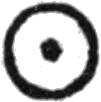 Or full stop represents the termination of the movement.
Or full stop represents the termination of the movement.
“A hand” means like A, and “B hand” means like
B, etc., in the one-handed Deaf Alphabet (Cut 1) on
next page. The positions meant by “4 hand,” “5
hand,” “flat hand,” “flat fist,” or “compressed hand,”
are figured on the same page.
Begin by learning the Single-hand Manual alphabet
as noted above.
Next learn the Numbers and the signs for Question and
its combinations; also Yes and No, Good and Bad, Come
and Go, Big and Small, Truth and Lie, Strong and Weak,
Understand, Perhaps, Talk and Sign-talk, after this refer
to the Dictionary for the signs that serve your purpose
and use them according to the rules of syntax as herein
set forth.
Never lose a chance of talking the Sign Language with
an old Plains Indian, preferably of the Cheyenne or
Arapahoe tribes. Their wonderful facility and grace
are as hard to convey on paper as the pronunciation of
French, and are as essential for the best style in Sign
Talk. One may, indeed, know every sign in this book
and not be a good sign-talker, so fundamental is this
correct accent, or manner.
Footnotes
SIGN TALK
A Universal Signal Code, Without Apparatus, for Use in
the Army, the Navy, Camping, Hunting, Daily
Life and Among the Plains Indians
SIGN TALK
OF THE AMERICAN INDIANS
BY
ERNEST THOMPSON SETON
“A hand,” “G hand,” “flat hand” etc., mean like “A,”
“G,” “flat,” etc., on page li.
A
Abandon, Give It up (Thrown away, chucked). Hold
both S hands, backs up, near left breast, briskly swing
both down to left side, opening them with a snap and
giving a slight rebound to the hands after the movement,
as though emphatically throwing away something.
Sometimes only one hand is used. Compare
Bad, Hate, and Charge. See Divorce.
Fr. abandonner; Ger. aufgeben.
Able. See Can.
Aboard (Sitting down on). Left hand out flat, palm
up, right S hand on it, thumb up. Compare Sit down.
Fr. à bord; Ger. an Bord.
About or Around. Hold the flat left hand pointing
forward, up and to the right, encircle it several times
with the right G finger. If possible, make it concrete by
indicating the very thing that was encircled.
Fr. autour; Ger. um ... herum.
About, in the sense of Near by or Almost. See Close.
Above or Over (One thing above another). Bring the
flat left hand, back up, in front of and a little to the left
of body; left forearm horizontal, fingers pointing to right
and front; bring the flat right hand, back up over the
left in a semi-circle upward large or small, as best suggests
the actual distance. Has been used for More
than. Compare Beyond.
Fr. au-dessus; Ger. über.
(Below is the reverse of this.)
Absent. See Empty.
Abuse to Scold or Defame (Throwing lies against one).
Hold the right V hand near the mouth, pointing to left.
Jerk it forward toward person once or twice. For
Abusing me make the sign lower opposite the left
breast and inward toward one’s self.
Fr. calomnier, injurier; Ger. schmähen, beschimpfen.
Accident. See Free, also Luck.
Ache or Pain. Thrust G finger many times in different
directions over and parallel to the part. Compare
Wound and Sick.
Fr. la douleur; Ger. der Schmerz.
Across, Cross, or Over (Crossing a ridge). Hold the
flat left hand out, palm down, and pointing forward and
toward the right, pass the flat right hand edgewise
across the back of the left. If but one person is meant,
the right G is sometimes used. This sign as illustrated
is often used for Council. See Council and Laws.
Fr. d’un côté à l’autre, traverser; Ger. hinüber.
Act, as in a theatre play. Hold A hands in front perpendicularly,
move up and down alternately as though
the thumbs were two puppets. (Deaf sign, not used
or understood by Indians.) Compare Play and Follow.
Act, as in a play. Sign Face, Two, Dance (that is dancing
with a mask) (not established).
Fr. jouer; Ger. spielen.
Act or Deed. See Work.
Add to (Piling up). Flat left hand pointing to the right
and front, palm up, forearm horizontal; the palm of
flat right hand is placed on top of left hand a number of
times, the left hand being raised a couple of inches each
time, to meet it; the movement ends with left hand as
high as top of the head. Often it is done as in the
illustration but with palm of left down.
Adjectives, see Comparative.
Adulation. Kissing the back of the hand. (Pop.) Not
Indian, but they understand it now. (R. B.)
Fr. la flatterie; Ger. die Schmeichelei.
Advance. Both flat hands back up, pointing forward,
tandem, right in advance, six inches ahead (the fingers
extended) moved forward together in gentle jerks.
Compare Move camp.
Fr. avancer; Ger. vorschreiten.
Advance Guard (The one ahead, looking). Flat left
hand back up, pointing forward, breast high; place G
right just before it, then turn right G into V to mean
Looking. Also used for Scout. Compare Ahead.
Fr. l’avant-garde; Ger. die Vorhut.
Advise or Advice. Sign Talk, Make, Way. (C) Sign
Help and Talk would be near it.
Fr. conseiller; Ger. raten.
Afraid (Shaking heart). Sign Heart then shake it up
and down two or three times, to indicate the throbbing
action of the heart under influence of fear. Or more
strongly, sign Heart and then finish by raising the hand
until its back strikes the chin, to mean the heart rises
in the throat.
Fr. effrayé; Ger. ängstlich.
Afraid or Cowardly (Seger says this means Buffalo
backing out of fight; that is, “drawing in his horns.”)
Hold out both G hands level, backs out, G fingers hooked
like horns, draw them straight back together for six
inches. Mostly but one hand is used. Compare Bring.
Fr. lâche, poltron; Ger. feige.
Afraid of no one. Point right G in several directions,
then add Afraid, Not.
Fr. peur de personne; Ger. vor niemand Angst haben.
After, Behind, or Late (Time or space). G fingers pointing
forward at an angle in front of body; left in advance.
Draw the right over and behind the left. Draw it back
a little way for a little bit after; but far back and low
down for a long way behind. Some finish by clenching
the right hand.
If it meant that one is behind the rest, use the flat left
hand, palm down, in advance, with right G behind.
Fr. après; Ger. hinter, nach.
Afternoon. Make a circle of right thumb and index
and sweep it over the afternoon half of the sky from the
zenith down. Compare Sunset.
Fr. l’après-midi; Ger. der Nachmittag.
Again. See Repeat or More.
Against, i.e., Go Against. Thrust the tips of the flat
right, back out, square against the palm of the flat left
held pointing level forward, back to left. See also
Oppose. Compare Quandary.
Fr. contre; Ger. wider.
Agent, Indian. Sign Whiteman and Chief, Give all.
The Southern Cheyennes sign Chief and pull teeth, because
their first agent had false upper teeth.
Agitate. See Excite.
Agree. Sign You, I, think, same. Sometimes use Equal.
See also Treaty.
Fr. s’accorder; Ger. übereinstimmen.
Agreement. See Treaty.
Ago, Time back, Past, or Back. Sign Time and point
back over the right shoulder with right finger G. Sometimes
the thumb or the whole hand is used instead of
the index. See Back.
Fr. passé, il y a quelque temps; Ger. vorher, früher.
Ahead or Before (In time). Hold out the left G pointing
forward and up; swing the right G over the left to a
place in front of it, both pointing the same way. Some
finish by closing and lowering the right fist. Compare
After.
Fr. avant; Ger. vor.
Ahead or Before others (In space or rank). Hold out
flat left, back up, near breast, pointing forward and
slightly upward; then hold right G just before it. Compare
Advance Guard, which it exactly resembles, except
that this omits Looking.
Fr. en avant; Ger. vor.
Air. See Wind.
Alight or Descend. Indicate from what, then drop right
V fingers downward onto flat left palm. See Dismount.
Fr. descendre; Ger. absteigen, hinuntersteigen.
Alike, to Look like or Resemble (Of persons). Make the
signs Face and Equal.
Fr. semblable; Ger. ähnlich sein.
Alive, Live, Life, or All right (Walking about, upright).
Hold index of right hand upright, move it about shoulder
high, forward in long slow zigzags sidewise, always
turning it so as to move palm forward. Also used for
Be or Exist. See Life, Deer, and Nothing. The Blackfeet
use the sign Grow for this idea. See Wandering.
Fr. vivant; Ger. lebendig.
All. With right hand flat and back up, describe a large
horizontal circle, shoulder high.
Fr. tout; Ger. alles.
All gone or Empty (Hands swept clean). Both 5 hands
in front of body, backs out, right nearer; loosely brush
fingers of right on left palm, moving right outward,
then reverse and repeat. Sometimes begin with sign
All. See Wipe out.
Fr. vide; Ger. leer.
Alliance or Friendship (Linked together). Form two
circles with thumbs and index fingers, and link them together,
other fingers closed. Some use only index fingers
hooked together.
Fr. l’alliance; Ger. das Bündnis.
All right. See Good or sometimes Alive.
All the time. Hold up the left G, pointing upward,
forward, and to the right; strike on it with right G near
the tip, then every inch or so up to the arm. See Many
times, Cheyenne and Buy.
Fr. toujours; Ger. immerzu.
Alone or Only (Living and moving singly). Move the
right G hand, pointed upward, slowly forward and to
left in a line slightly waving to right and left. Compare
Alive, Life, Man, One and Up there.
Fr. seul; Ger. allein.
Already. See Now.
Always, Ever, or Forever (Going on in cycles). With
elbow at side, hold the right G hand pointing forward;
move hand forward, describing circles with the index,
the result a spiral, ending with the index raised.
(Frosted, borrowed from the Deaf Code.)
Always. Sign Long time, Wiped out, and Not. Sometimes
sign Stop, Not. (Blackfoot signs.) See All the
time.
Fr. toujours; Ger. immer.
Ambitious (Pushing to rise). Indicate a person, then
sign Push and Rising man, or omit last.
Fr. ambitieux; Ger. ehrgeizig.
American. See Nationalities.
Ammunition (Cartridges in belt). Lay the flat hands,
palm in, on belt, then add Shoot by shooting the right G
forward. (Not Cheyenne, but understood.)
Fr. les munitions; Ger. die Munition.
Among. Hold the left 5 hand in front of neck, pointing
upward, move right G index (pointing down) in and
through. Sometimes use With.
Fr. parmi; Ger. unter.
Ancestor. Repeat the sign for Father several times,
with the flat left hand held back out on the breast, and
each time pushed farther away, the Father sign made
beyond it. (Crow sign.) The Cheyennes sign Father
and Old.
Fr. l’ancêtre; Ger. der Vorvater.
And or Also (Meet and go together). The spread flat
right hand, breast high, back forward, drawn six inches
to the right and closed to flat hand. (Deaf sign.)
Compare Horse. The Cheyennes use Equal or Increase,
according to the sense; or sometimes With or Add.
Fr. et, aussi; Ger. und, auch.
Angry (Mind twisted). Twist the A hand against or
near the forehead.
Seger maintains that this means a “mad buffalo
breaking off his own horns.” Possibly he is right; for
the older signs make the heart, not the head, the place
of the mind, and this must be a very old sign. Some of
the Blackfeet make this sign over the heart. Some
grind on the heart with the flat right fist, palm in, after
pointing to the person; meaning, “he grinds my
heart.” See Sorrow.
Fr. en colère; Ger. böse, zornig.
Animal or Quadruped (Jumper). The compressed
right hand, back up, advanced in short jumps, as in
Frog and Weasel. Sometimes the sign Ground is made,
first by sweeping the flat right across, palm up. “Leaping”
is generic for the quadruped as “Flying” is
generic for Bird. Compare Jump. Used by Blackfeet.
The Cheyennes considered it incomplete.
Fr. l’animal; Ger. das Tier.
Annihilate. See Exterminate or Wipe out.
Annoyance. See Trouble.
Annul. See Rub it out.
Another or Other (one other). Hold out flat right,
back up, swing it slowly up, out, far to right and down
low, turning it palm up. Compare Fall and Lie down.
Fr. un autre; Ger. ein anderer.
Another person. As above, but use right G. (Blackfoot.)
In this, as usual, the index up alone means Man.
This gesture is so natural that many whites use it; as,
for example, in saying impatiently: “That was another
man altogether.”
Answer (Talk come back). Push right G from the mouth
in the sign Talk, then draw back reversed; that is,
pointing to one’s own face or ear. (Blackfoot.) The
Cheyennes use Talk, Arrived here.
Answer, Reply, Respond (The word that follows the
other). Right G index upright on lips, left six inches
ahead and parallel; move them together toward the
person. (Frosted, borrowed from the Deaf Code.)
Fr. la réponse; Ger. die Antwort.
Antelope (Pronged horns of the animal). Bring the L
hands palm toward and alongside of the head, near
the base of the ears.
Fr. l’antelope; Ger. die Antilope.
Anxious. See Want.
Any (Scattering). Place the right A hand near left side,
elbow high; draw it down and out to right side in a
shaky curve. (Deaf sign.) Use Here and There.
(Cheyennes.)
Fr. quelconque, quelque; Ger. irgend ein.
Apache. See Indian.
Appear, To come into view. See Come into view.
Appears, Seems, or Looks like (See and Same). Hold
up flat right hand, thumb toward self, shoulder high;
throw it forward and turn palm toward self, fixing the
eyes on it and sign Same. Sometimes use the sign for
Look before Same. (Frosted; probably adopted from
Deaf Code.)
Fr. paraître; Ger. aussehen, erscheinen.
Applause. See Approval.
Approach or Moving toward. Hold partly bent left
hand well in front, breast high, to left side, palm to you
and right similarly to right, but quite near to you;
move the latter slowly forward toward former, but not
to touch it by several inches. Some use right G. See
Arrive there and Quandary.
Fr. approcher; Ger. näher kommen.
Approval, Applause, or Praise. Make the motion of
clapping the hands, but without noise. A white man’s
sign, but now generally understood.
Fr. l’approbation; Ger. der Beifall.
Arise or Get up. Hold out right G, back down; raise the
arm with a swing and snap and bend the wrist till the
finger points straight up. For a large number, use both
5 hands.
Fr. se lever; Ger. aufstehen.
Arithmetic. See Numeral.
Around. See About.
Arrange (Parfleches placed in teepee). With flat right,
slightly curved, back out, strike half a dozen times in a
circle, turning to watch the hand; then add Good.
Sometimes omit Good. Or, sign Work and Fix. See
Ready.
Fr. arranger; Ger. ordnen, einrichten.
Arrest or Imprison (To seize hold of and tie at wrists).
Sign Seize and then add Prisoner; that is, cross the
wrists, hands closed. Sometimes the upright left forearm
with S hand, back to left, is held near the left
shoulder, grasp left wrist with right hand and pull it a
little distance to right.
Fr. arrêter; Ger. verhaften.
Arrive here or Get here. Hold the flat left hand, back
out, near the breast, fingers pointing to right; carry
right G, back to front, well out in front of body; bring
the right hand briskly against back of left. Often the
flat right is used instead of right G.
Fr. arriver ici; Ger. hier ankommen.
Arrive there or Reach. Hold the flat left hand, back to
front, well out in front of body, about height of neck,
pointing to right; bring right G hand, palm outward,
in front of and close to neck, carry the right hand out
sharply to strike the palm of the left.
Fr. y arriver; Ger. hinkommen.
Arrogance. A haughty lifting of the eyebrows and sidelong,
disdainful look down as upon an inferior. (Scott.)
Sign Head, Big. In the popular code, indicate big
chest. See Conceit and Pride.
Fr. l’arrogance; Ger. die Anmaszung.
Arrow. Make, with a long swing, the motion of drawing
an arrow from the left hand.
Fr. la flèche; Ger. der Pfeil.
As or Than. Both hands, G fingers parallel, level, forward
near right side; carry them over to left in similar
position. (A sign borrowed from the Deaf, Frosted.)
This is the same as Who; only the context can show
which is meant. Sign Same or Beside.
Fr. comme, que; Ger. wie, als.
Ascend. Indicate the object (hill, tree, etc.), then press
right G against it, raising the same in jerks. Compare
Famous.
Fr. monter; Ger. hinaufsteigen.
Ashamed or Bashful (Drawing blanket over face).
Flat hands pointing up, palms in, close to face and
moved in till the wrists crossed, right nearest the face;
bow the head a little. Compare Blind and Dark.
The bowing of the head was not generally done, yet is
the only feature to distinguish it from Dark.
Fr. honteux; Ger. verschämt, verlegen.
Ashamed (I am ashamed). Cover the face and eyes
with both hands. (Pop.)
Fr. avoir honte; Ger. sich schämen.
Ashamed (You should be). See Shame.
Ashes. Sign Fire and Powder.
Fr. la cendre; Ger. die Asche.
Ask. See Beg.
Assiniboine. See Indian.
Astonishment or Wonder. Lay the flat palm of left
hand over the open mouth and draw the body backward.
Sometimes, also, raise right hand flat, palm
forward.
Fr. l’étonnement; Ger. die Verwunderung.
Astray. See Lost.
Astride. See Horseman.
At. Hold left flat hand, back up, pointing partly up;
strike the back with right flat hand.
Fr. à; Ger. an, auf.
Attempt. See Try.
Attention (A command). See Call.
Aunt. Sign Father (or Mother) and Sister. Or, sign
Woman with right, then tuck compressed right, point
down, under left arm pit. (R. B.)
Fr. la tante; Ger. die Tante.
Aurora or Northern Lights. Both hands, backs down,
half closed, thumb and finger tips together, raised very
high and spread with a sweep to indicate flashes. It
should be done facing north. It is helped if the hands
when at the highest are swung apart in an arch.
Fr. l’aurore boréale; Ger. das Nordlicht.
Automobile. See Motor car.
Autumn (Leaf-falling time). Make the sign for Tree
with both hands, then for Leaf with the right near the
left finger tips, then drop the leaf with tremulous, wavy
motion down and to right.
Fr. l’automne; Ger. der Herbst.
Avoid or Miss. Hold up G hands, move them toward
each other as in Meet, but carry left well outside, past
and beyond without meeting. Compare Meet, Trade,
and Mistake.
Fr. éviter; Ger. vermeiden.
Awl. Bore right G finger into left palm. Or, over the
left G as in sewing.
Fr. l’alêne; Ger. die Ahle.
Axe or Hatchet. Hold out the flat right hand, back to
right, wrist bent downward. Make as though chopping
with it; that is, strike down once or twice. Some
also grasp it near the elbow with left index and thumb,
but the Cheyennes omit this. For Hatchet, indicate
Size. See Tomahawk.
Fr. la hache; Ger. das Beil.
B
Baby. Swing the flat right hand (sometimes S hand)
in the hollow of the left arm as though it were a baby.
Add signs for sex and size when needed. Compare
Tomahawk.
Fr. le bébé; Ger. das Kindchen, der Säugling.
Bachelor. Sign Man, Marriage, No. (C)
Fr. le célibataire; Ger. der Junggeselle.
Back or Again. See Repeat.
Back, Backward, Ago, or Past (In time or space).
Throw right 5 hand thumb first back over right shoulder
once or twice. See Ago.
Fr. en arrière; Ger. hinten, zurück.
Backbite. Lay the right V hand on the mouth, as in
Lie, then lay it on the back of the right shoulder.
(Blackfoot.)
Backbite. Sign Scold, Talk, and Hide.
Fr. médire de; Ger. verleumden.
Bacon (Meat and thin). Hold out the flat left hand,
thumb edge up; with thumb and finger tips of right
back down, rub little finger of left. Hadley gives this
with the right hand over. It makes a better sign, but
I never saw it used that way. Compare Meat and Thin
and Oil.
Fr. le lard; Ger. der Speck.
Bad or Evil (Suddenly thrown away). Hold clenched
fist, back up, near breast; throw it forward, down, and
aside, opening the hand. Sometimes for emphasis
both hands are used. Compare Abandon, Charge, and
Hate.
Fr. mauvais; Ger. schlecht.
Badger (Walks under ground). Sign Hole, Enter, and
Walk. The Blackfeet sign is Striped-face with size and
pawing indicated.
Fr. le blaireau; Ger. der Dachs.
Bad Taste. See Taste Bad.
Bag. Left C hand, back out; drop compressed right into
this; then sometimes indicate thickness with flat hands
pointing straight up.
Fr. le sac; Ger. der Sack.
Bald. Lay the flat right hand on the forehead, draw
it up and back to the top of the head. Touch the hair
and sign Wiped-out. (Blackfoot.)
Fr. chauve; Ger. kahlköpfig.
Band or Patrol (Banded together). Hold the compressed
left hand pointing up; encircle it with the right
forefinger and thumb. (Chasing Bear.) Not a true
Indian sign and not used, but would understand it.
(Seger.) Sometimes use Bunch or Few. See Tribe or
Troop.
Fr. la bande, la patrouille; Ger. die Schar, die
Truppe.
Bankrupt. See Done.
Bar or Saloon (House of drink). Sign Crazy, Drink,
House.
Fr. le cabaret, la buvette; Ger. die Bierstube, die
Kneipe.
Bark (Like a dog). Sign Talk, but use index and middle
finger against thumb.
Fr. aboyer; Ger. bellen.
Barracks. Sign White, Soldier, House.
Fr. la caserne; Ger. die Kaserne.
Barren. Sign Born and All gone.
Fr. stérile; Ger. unfruchtbar.
Bar up. See Fins.
Baseball signs. These, of course, are not Indian; they
differ locally, but the three following are used by most
umpires:
A strike. The sign “Yes.”
Out. The Same as the “No” sign (as tho striking
something to one side with the back of hand).
Safe. Hand raised as in “Easy.”
Bashful. See Ashamed.
Basin or Hollow (A spread out circle). Hold the L
hands low in front, backs up, forming an incomplete
horizontal circle, not touching, the index fingers nearer
each other than thumbs; swing the hands apart by
wrist action so the index fingers point nearly forward.
Fr. le bassin; Ger. die Vertiefung, die Grube.
Basket. Sign Kettle, then interlock fingers as in House
of logs, to show structure. The Cheyennes understand
this, though usually they sign Kettle and Sew.
Basket. Lock the fingers of the hollowed hands, backs
down, join the thumbs as for a handle, then with the
right hand grasp left thumb and raise the hand a few
inches. (Sioux.) Compare Corral.
Fr. le panier; Ger. der Korb.
Bat. Sign Night and zigzag flight; i.e., flat hands side
by side, breast high, flapped first to right side next to
left. (C)
Fr. la chauve-souris; Ger. die Fledermaus.
Battle, Combat. Sign Fight, after which make Shoot
with each hand toward the other. (C) Compare
Fight and Kill.
Fr. la bataille, le combat; Ger. die Schlacht.
Battle-cry or War-cry. Open the mouth as in saying
“O” and pat it with flattened fingers of right hand.
(C) The Cheyennes use Yell.
Fr. le cri de bataille; Ger. der Schlachtruf.
Bay. Sign Water, then bring right L hand well out in
front of body, forming a horizontal half-circle. (C)
Fr. la baie; Ger. die Bucht.
Bayonet. Sign Gun, then lay left G index alongside
right G, the latter one-third ahead. If there is doubt,
indicate drawing it on the barrel tip.
Fr. la baïonnette; Ger. das Bajonett.
Be, to be or exist (Living). Sign Alive and then finish
with Now or Past to indicate tense, and Many to
indicate plural. Sometimes use Dwell or Recover for
this idea. Compare Alone.
Fr. étre; Ger. existieren, sein.
Beads. Hold out the flat right, slightly hollow; drop
it a little with a sidewise quivering to suggest the shimmering
of a handful of beads. (C)
Beads. Simulate holding beads between the left index
and thumb, while threading them with a needle in the
right. For Beadwork add a design or sign for Work.
Fr. les perles; Ger. die Perlen.
Beans (One picked out of a handful). Right hand flat,
palm up, index and thumb joined with the tip of index
projecting. (Chasing Bear. Understood by Cheyennes.)
Fr. les haricots; Ger. die Bohnen.
Bear. Hold out the Y hands, backs up, and strike
both down; push both forward in a series of jerks, or
swing down, forward and up.
Bear. Hold up flat fists near ears, palms forward, to
indicate round ears. (Blackfoot.) Some indicate the
paws by holding up both curved 5 hands.
Fr. l’ours; Ger. der Bär.
Bear, Grizzly. As above, but indicate the gray color.
Fr. l’ours gris; Ger. der graue Bär.
Beard. Hang the compressed right hand, point down,
under chin. The hand or hands are differently placed
for different cuts of whiskers.
Fr. la barbe; Ger. der Bart.
Beat, or Overcome. Use Kill.
Beautiful, Handsome, or Pretty. Hold up flat right
hand, and look on the palm as in a mirror, then make
the sign Good.
Beautiful. Draw the flat hand down near the face, back
forward, and sign Good.
Fr. beau; Ger. schön.
Beaver (Tail of beaver striking mud or water). Hold
left flat hand in front of body, left arm horizontal;
strike up against the left palm once or twice with back
of right flat hand.
Fr. le castor; Ger. der Biber.
Because. Sign Consider, then Behold. Understood by
Cheyennes and Blackfeet, though not well established.
Fr. parce que; Ger. weil.
Become or Turn into. Sign Grow and Same or Arrive there.
Fr. devenir; Ger. werden.
Bed (Spreading blanket for sleep). Hold flat hands
palms up, points forward, one behind the other, left
ahead, push it forward, at same time draw back right,
then add Sleep.
Fr. le lit; Ger. das Bett.
Bee. Sign Fly, Arrow, and One. (C) In Cheyenne,
sign Small, Bird, Make, Taste.
Fr. l’abeille; Ger. die Biene.
Before. See Ahead.
Before, that is, Future. Sign for Time, but hold left
hand near breast and swing right forward, up and over.
Or sign After, Many Sleeps.
Fr. avant; Ger. ehe.
Beg (To ask alms). Hold out the flat right hand, palm
up, as a beggar does. Swing it forward and upward,
then draw it toward self, slightly curving the fingers.
Fr. mendier; Ger. betteln.
Beg, I beg of you, Ask, I pray you. Lay the flat hands
together, palms touching, fingers pointing up (or clasp
them) and hold them toward the person. A white sign
now understood by the Indians. Compare Pray.
Fr. supplier; Ger. bitten.
Begin, Commence, Must, Push, Try, Go ahead (Start
in a race). With elbow at sides and arms level, push
fists forward two or three inches, right a little behind.
Or use Go. See Strong.
Fr. commencer; Ger. anfangen, beginnen.
Behavior. See Way.
Behind. See After.
Behold. Hold out flat right, palm up, pointing forward
and moved slowly down to below level. Sometimes
use both hands. Compare Show.
Fr. regardez!; Ger. siehe da!
Believe. Sign Think, Straight.
Fr. croire; Ger. glauben.
Belonging to. See Possession.
Below, Beneath, or Under. Is the reverse of Above;
which see.
Fr. dessous, sous; Ger. unter.
Belt. With both hands, make as though putting on a
belt.
Fr. la ceinture; Ger. der Gürtel.
Beneath. See Below.
Bend or Bent. Take left index in right finger and thumb
and bend the middle joint of it at right angles. Or sign
Break very slowly.
Fr. plier; Ger. biegen.
Berry. With right middle finger and thumb hold tip
of right index, letting it project a little; add Bushes.
Or, sign Tree, Pick, and Eat. This is a descriptive
phrase rather than an established sign, but it is a good
illustration of impromptu constructions which are
continually made and are at once understood because in
harmony with the main principles of Sign Talk. Compare
Fruit, Cherry, and Bullet.
Fr. la baie; Ger. die Beere.
Beside or By (By the side of). Like With, but right G
about three inches off left palm. Sometimes use Close.
Fr. à côté de, près de; Ger. neben.
Bet or Wager (Placing on each of two piles). Indicate
the event, as Race, then sign Place; that is, hold out
partly compressed hands backs up; swing both forward
up and down nearly together at finish.
Fr. le pari; Ger. die Wette.
Between. Hold up the flat hands, palm to palm, six
inches apart; then thrust the right G on line close past
left palm.
Between. Hold left V hand, fingers level, pointing to
right (or straight up) and drop right G down between.
Fr. entre; Ger. zwischen.
Beware, Caution, or Look out. See Warning.
Beyond or Other side. Hold the flat left hand, back up,
in front of body about ten inches, fingers pointing to
right; bring flat right hand, back up, between left and
body at same height, fingers pointing to left; swing the
right hand upward, outward, and then downward on
curve, beyond left hand, turning right hand back down
in movement. Compare Fall and Other.
Fr. au-delà de; Ger. jenseits.
Bible. Sign Book and Medicine.
Fr. la Bible; Ger. die Bibel.
Big. Hold the curved 5 hands with palms toward
each other, well out in front of the body, hands a little
lower than shoulders and a few inches apart, pointing
forward; separate hands, carrying right to right, left to
left, keeping them opposite each other. Also used for
Long. Compare Great and Long.
Fr. grand, gros; Ger. grosz.
Bighorn. See Sheep.
Bird. With flat hands at the shoulders, palms down,
imitate the motion of wings. Using different speeds for
different birds. Compare Fly, which progresses.
Fr. l’oiseau; Ger. der Vogel.
Birth. See Born.
Bison. See Buffalo.
Bit (Of a bridle). Place the L hand palm down on the
mouth.
Fr. le frein; Ger. das Gebisz.
Bite. Bring the right C hand, back outward and upward,
a little in front of the body; snap sharply together
the tips of the first and second fingers and the tip
of thumb against the back of the left flat hand, repeating
the motion. Some omit left hand. The Blackfeet make
this from the mouth.
Fr. mordre; Ger. beiszen.
Bitter or Sour. Touch tongue with tip of right G and
add Bad. Compare Salt, Sugar, Taste, Taste bad.
Fr. amer; Ger. bitter.
Black. See Color.
Blackfoot. See Indian.
Blackguarding or Reviling (Lies from both). Hold up
right V, pointing nearly level forward, opposite right
shoulder; left ditto at left shoulder; swing them alternately
at each other.
Fr. outrager, insulter; Ger. jemanden beschimpfen.
Blanket or Robe (Wrapping about shoulder). Bring
the A hands palms toward each other, opposite and
above each shoulder near the neck; move the right hand
to left and left to right till the wrists are crossed, right
hand nearest body. Compare Fond.
Fr. la couverture; Ger. die Decke.
Bless you (Drawing from above and spreading out).
Hold the flat hands high up in front, palms forward,
apart, at arm’s length. Lower them a little and
slightly push toward the person meant. (C)
Fr. que Dieu vous bénisse; Ger. Gott segne dich!
Blessing the food. Hold both 5 hands over the food,
then add Talk upward.
Blind. Bring both flat hands, backs outward, in front
of and close to eyes, right hand nearest and both hands
parallel to face; move right hand slightly to left, left
to right; then place the tips of the fingers against closed
eyes. (C)
Fr. aveugle; Ger. blind.
Blood (A wounded buffalo bleeds at the nostrils).
Raise the right V hand so the tips of the fingers are
pressed one against each nostril; move the hand to the
right and downward, giving it a tremulous motion. Add
Red. Some omit Red.
Fr. le sang; Ger. das Blut.
Bloom or Blossom. See Flower.
Bluff. See Hill.
Boat. Bring the hands together hollowed, fingers
straight, little fingers joining, the thumbs somewhat
apart, to represent the body of a boat, held before the
breast. Push it forward to indicate movement. Add
the motion of paddling for Canoe, or Rowing for bigger
boat. Usually the Boat sign is omitted; Paddling or
Rowing being enough by itself. Compare Bowl.
Fr. le bateau; Ger. der Kahn.
Boil. See Cook.
Fr. bouillir; Ger. kochen.
Bone. Hold up the left hand, palm down, wrist a little
bent; with right G tap the wrist bone on outer side of
left; then add Hard.
Fr. l’os; Ger. der Knochen.
Bonnet, that is, Warbonnet. Sweep 5 hands along near
each side of head from front to back. Sometimes also
sweep right 5 hand down behind for the Tail.
Fr. le bonnet de guerre; Ger. die Federkappe.
Book. Open and close the flat hands like cover of a
book, then indicate the lines of writing. Sometimes
show the thickness to distinguish it from Letter. Compare
Open and Shut.
Fr. le livre; Ger. das Buch.
Born, Birth, or Parturition (Issuing from loins). Flat
right in front of and near the body, pointing downward
and to front, moved downward and outward on a curve.
Compare Dive.
Fr. né; Ger. geboren.
Borrow. See Lend.
Boss. Use Chief.
Both. Sign Or, that is, hold up the left V, pointing
forward, and tap each tip of V, and in turn, with right
G; then over left V add All with right. Sometimes point
to each and add Two. Sometimes use All. Blackfeet
use Two and Same.
Fr. tous les deux; Ger. beide.
Bow (Weapon). The left A hand held still, a little
advanced, the right A hand touches it and makes the
motion of drawing the cord of the bow.
Fr. l’arc; Ger. der Schiessbogen.
Bowl (A vessel). With curved hands side by side,
fingers bent, palms up, indicate shape. (C) Compare
Boat. For a larger vessel, use Basin.
Fr. le bol; Ger. die Schale, die Schüssel.
Box. Hold out both flat hands side by side, backs up;
then swing apart and down at right angles, turning the
hands at the angle so the backs are out.
Fr. la boîte; Ger. der Kasten.
Boy. Sign Man, Young.
Fr. le garçon; Ger. der Knabe.
Brag. See Bravado.
Brain. Touch forehead with N hand.
Fr. le cerveau; Ger. das Gehirn.
Brand or Name. All fingers of right closed but thumb
and index, these form a “C,” which lay on the palm of
flat left, pointing forward, thumb up. Sometimes lay
it on left shoulder outside. Compare Name.
Fr. la marque, marquer avec un fer rouge; Ger. das
Zeichen, das Brandmal, einbrennen.
Bravado or Brag. Sign Fire, Talk, True, and No. (C)
Fr. la bravade; Ger. die Prahlerei.
Brave (Strong heart). Sign Heart and Strong.
Fr. brave; Ger. mutig, tapfer.
Brave, as an intensive. See Very much.
Bread (Making a cake). Gently clap the slightly hollow
right hand over slightly hollow left hand, then reverse
so left is on right and clap them together again;
repeat.
Fr. le pain; Ger. das Brot.
Break. Make the motion of seizing a stick, hold it
horizontally with both hands and breaking it in the
middle. The thumbs finish wide apart.
Fr. casser, briser; Ger. zerbrechen.
Breakfast. Sign Sunrise and Eat.
Fr. le déjeuner; Ger. das Frühstück.
Breeze. See Wind.
Bribe. Hold the hand behind the back, hollowed,
open and palm up. (Pop.)
Fr. corrompre; Ger. bestechen.
Bridge (Lifting over water). Sign Water; hold out the
flat hands horizontally in front of body, pointing forward,
palms up; and Across.
Fr. le pont; Ger. die Brücke.
Bridle. Like Bit; but raise the hand till near the eyes.
Fr. la bride; Ger. der Zaum.
Bring, Take, or Fetch. Move the right G hand briskly
well in front or to right or left of body; draw the hand
with a sweep in toward the body, at the same time
curving index finger. Compare Come in which the index
is held vertically, and Steal.
Fr. apporter, prendre; Ger. bringen, nehmen, holen.
Broad or Wide. Same as Big, but keep the hands flat
and palms up.
Broad and Spreading is the same as above but with
palms down. Compare Prairie.
Fr. large; Ger. breit.
Broke or Dead broke. See Done (No. 2.)
Broken down. See Decrepit.
Brook. See Creek.
Brother (Suck together). Lay nearly horizontal N of
right hand on lips; draw it away and down, then add
Male.
Fr. le frère; Ger. der Bruder.
Brother-in-Law. Left forearm across breast; with
lower edge of flat right, strike down past left elbow.
Probably means relative on the side. (R. B.)
Fr. le beau-frère; Ger. der Schwager.
Bucket. Sign Bowl, then indicate the handle.
Fr. le seau; Ger. der Eimer.
Buffalo (Curved horns). Hold the curved G fingers
palms toward and close to sides of head; raise the hands
slightly and carry them a little to the front. To distinguish
domestic cattle, add Spotted. The Navahos
reverse this; that is, with them the curved horns as
above means Cattle, to which they add Beard, to mean
Buffalo.
Fr. le bison; Ger. der Büffel.
Bullet. Sign Fire off; then grasp the forefinger of the
hand with the second finger and thumb, so that the tip
of it will so extend beyond them and represent the ball.
Fr. la balle; Ger. die Kugel.
Bunch (Of fruit). Hold out the compressed right hand
opposite throat, fingers pointing down. Compare
Beard.
Bunch (A small herd grazing). Hold out curved right
5 hand, back up and forward. See Herd. Sometimes
use Enclosure.
Fr. le troupeau; Ger. die Anzahl, die kleine Herde.
Burn. Sign Fire and Wipe out.
Fr. brûler; Ger. brennen.
Bushes or Brush. Like Grass, but breast high; and
draw right hand to you and left far ahead.
Fr. la broussaille; Ger. das Gebüsch.
Busy. Sign Push and Work.
Fr. occupé; Ger. beschäftigt.
But, Except, Save, or Unless (Of all one pulled back).
Sign All, with right swung to left; then sign One, with
left at left side, and pull it to right side between forefinger
and thumb of right.
But. Sign All Go, One, Sits.
But (One drawn back). Point right G down, forward
and to right; hold it a second, then jerk it back four or
five inches. (Hadley.)
Fr. mais; Ger. aber.
Butte. See Hill.
Buy. Sign Money and Trade, making it clear who gives
the money.
Buy or Sell i.e., Market. Tap three times on side of
left G index with side of right G index. Compare, All
the time, Peas, and While. See Sell.
Fr. acheter; Ger. kaufen.
By. See Beside.
By and By (After a little time). Hold the pinched
index and thumb of each hand as in Time, but half an
inch apart. Or sign Time afterward. Compare Sometime.
Fr. plus tard; (C) Ger. später.
C
Cache. See Hide.
Call, Attention! Say! Strike the palm of the open
left hand with the tips of right fingers, then swing right
G a little toward the person.
Fr. dites donc; Ger. hören Sie!
Called or Named. Lay the back of the crooked right
G on lips, pointing to front and left, its tip pressed
against the thumb, which is nearly straight; then move
the hand upward and forward in a curve, straightening
out the index finally with a snap, pointing toward the
person or thing. Compare Talk in which the action is
repeated. See also Name.
Fr. appelé; Ger. genannt.
Camera. Sign Picture and See. Compare Photograph.
Camp (Set up the lodge). Sign Teepee, holding the
hands face high; drop the hands together for a foot with
energy.
Fr. le camp; Ger. das Lager.
Camp-fire. Hold left hand flat, palm down, fingers a
little spread; then lay right hand fingers similarly held
across at right angles, to indicate the wood laid ready,
and add the sign for Fire. (Sheeaka.) Not a true
Indian sign, but sufficiently descriptive for the Cheyennes
to understand it.
Fr. le feu de camp; Ger. das Lagerfeuer.
Camp-fire Girls. Sign Camp-fire, then raise the right
index in a spiral for Smoke.
Camp-fire man are you? Give the signs Question, you,
camp-fire, and man or briefly make the Camp-fire sign
and look inquiringly.
Fr. Êtes vous membre du Camp-fire Club; Ger.
Sind Sie ein Mitglied des Lagerfeuer Klubs?
Can, Able, or Power. Hold both S hands in front,
elbows at sides, thumbs up; drop the hands for six
inches with a jerk. (Sheeaka and the Blackfeet.)
Sometimes use only one hand. The Cheyennes sign
Own, Strong, Medicine.
Fr. pouvoir; Ger. können.
Candid (True, clear as day and good). Sign True, Day,
and Good. (C)
Fr. sincère; Ger. aufrichtig.
Candle. Hold up left G finger and with right hand sign
Fire on its tip, then indicate length on left arm.
Fr. la bougie; Ger. die Kerze.
Candy-stick. Sign Sugar; then on left G index held
upright, show stripes. (C)
Fr. le bonbon; Ger. das Zuckerwerk.
Cannon. Sign Gun and Big.
Fr. le canon; Ger. die Kanone.
Cannot, or Unable, Fail, Failure (The arrow that failed
to stick). Hold the flat left hand out in front, thumb
edge up; strike the palm of it with the forefinger of the
right G hand, which then at once rebounds and is
thrown forward and down to rest on its back.
Fr. ne pas pouvoir, incapable; Ger. nicht können,
unfähig.
Canoe. Sign Boat and Paddle.
Canoe of birch bark. Push forward compressed right,
back down, to represent the curved prow, then add
Paddle.
Fr. la pirogue, le canot; Ger. das Kanu, der Rindenkahn.
Canyon (Between hills). Hold up the fists, palms
toward each other, about six inches apart, face high;
then indicate Go between; that is, hold the left unchanged
but thrust forward the flat right hand, palm to left.
(Blackfoot.) Compare Between.
Fr. le canyon, le grand ravin; Ger. die Schluckt.
Cards. Hold imaginary cards in left and deal with right
hand.
Fr. les cartes; Ger. die Karten.
Caribou. Sign Deer, High, and lay the flat right hand
on forehead so the fingers slightly spread point forward,
showing the brow shovel. (Blackfoot.) Sometimes omit
High.
Fr. le renne, le caribou; Ger. das Karibu.
Carriage, or Covered Wagon. Sign Wagon, then raise
the hands, palms down, flat, but bent at an angle, up
above the head, and move forward about two feet to
represent the carriage top.
Carriage or Buggy. Sign Wagon, Small, and sometimes
add Black.
Fr. la voiture; Ger. der Wagen.
Carry or Pack. Both closed hands held opposite the
temple as if holding the tump line, the shoulders
slightly forward as though bearing a pack.
Fr. porter; Ger. tragen.
Carry in the hand. With one hand make as though
carrying a basket by the handle.
Cars. See Railroad train.
Cartridge. Hold right G hand, back up, in front of
body, index horizontal and pointing to front, thumb
pressed against side of index, with the thumb tip just
back of second joint; add Shoot. See Ammunition.
Fr. la cartouche; Ger. die Patrone, (artill) die Kartusche.
Cat (Flattened or turned-up nose). Lay A hand on
nose, rotating a little out and up. (C) Sign Nose,
Short, Dog.
Fr. le chat; Ger. die Katze.
Catch. Same as Get but action quicker. See Get.
Fr. attraper; Ger. fangen.
Catholic. Indicate gown by sweeping the 5 hands
down over the sides and outward; then add Black.
Sometimes make the sign of the Cross.
Fr. catholique; Ger. katholisch.
Cattle. Sign Buffalo and Spotted. (Blackfoot.) Compare
Buffalo. Or, sign Buffalo and Whiteman.
Fr. les bestiaux; Ger. das Vieh.
Caution. See Warning.
Cavalry. Soldier and Ride.
Fr. la cavalerie; Ger. die Kavallerie.
Centre. With thumbs and index fingers of L hands
make a horizontal circle; then, keeping the left unchanged,
indicate centre with right G finger. Sometimes
draw a horizontal circle with right G, then drop
same down into its centre.
Fr. le centre; Ger. die Mitte.
Certain. Sign I, Know, Good. Or use True.
Fr. certain; Ger. sicher.
Challenge, Defy, or Dare. Spring the middle finger
with a vigorous snap toward the person, the other
fingers closed; hand held face high, back up. A European
sign given by Butler. Compare There and Defiance.
Fr. défier; Ger. herausfordern.
Chance. See Luck.
Character (Shape of heart). Lay right C hand on
heart, draw it out, that is, forward, a little and with
both A hands outline a human figure. (D) Sign
Heart, Good, Bad. (Blackfoot.)
Fr. le caractère; Ger. der Charakter.
Charge (Military, against others). Swing both fists
from right shoulder forward and a little down in an up
curve, away, rising a little, at the same time springing
them open.
Fr. la charge (contre les autres); Ger. die Attacke,
der Angriff (gegen andere).
Charge (Military, against us). Similar but reversed,
springing the hands open toward one’s face.
Fr. la charge (contre nous); Ger. die Attacke (gegen
uns).
Chase. See Follow.
Cherries (Choke). Sign, Tree, Pick, and Pound.
(Blackfoot.) See Berry.
Fr. les cerises; Ger. die Kirschen.
Cheyenne. See Indian.
Chicken. Sign Bird, then Red and with 5 hand on
crown show Comb. (C) Or sign Bird and Whiteman.
Fr. le poulet; Ger. das Huhn.
Chief (People with one man rising above them).
Hold up left 5 hand, palm to right, pass index of right G
hand at several inches above left. (Scott.) The
Cheyennes omit left hand; they shoot the right G up
over and much down in a long sweep, finishing lower
than it began.
Fr. le commandant; Ger. der Häuptling.
Child or Offspring. Compressed right hand, points up,
swung well out in front and dropped a foot to the height
of the child. Compare Young.
Fr. l’enfant; Ger. das Kind.
Children (Springing up). Hold out both hands, palms
up, very low, fingers pointing up and scarcely spread;
alternately swing them up and down for six inches.
Compare Grass, in which they are held low and are
spread widely; also Bushes.
Fr. les enfants; Ger. die Kinder.
Choose, Make choice, or Select. Hold right G shoulder
high, back up, a foot in front of the breast, swing it in a
circle with a succession of little bounds or up curves, as
though pointing at many different objects in succession,
the head turned to follow always; then finish by throwing
the G finger forward in a curve; or, in some cases,
finish by picking up the imaginary object selected, using
index and thumb for this. Compare Find, Hunting,
and Look.
Fr. choisir; Ger. wählen.
Chop. Use the flat right hand, little finger down, as an
axe, chopping first from right, then from left, once on
each side. Sometimes do this on back of left hand,
which stands for the log. Compare Free, which is two
or three cuts on right side only.
Fr. couper, trancher; Ger. hauen, hacken.
Christmas (The day of the shining tree). Sign Tree,
then hold hand with fingers spread and crooked, palm
down, level of face. Lower it six inches in short, quick
zigzags to suggest glittering or shimmering. (W. C.
Roe.) In Snow the hand is lowered in long zigzags for
about two feet. See Shimmer. Or sign Middle, Winter,
Tree, and Hanging; for the last, hold the curved 5
hands, backs up, at level of the eyes; jerk them a little
apart. (R. B.)
Fr. le Noël; Ger. Weihnachten.
Church (Steeple house). Cross clasp the fingers so the
tips are within, then raise both index fingers to form the
steeple. (Pop.)
Church. Sign Medicine, Talk, House.
Fr. l’église; Ger. die Kirche.
Cigarette. Sign Tobacco; then lay G fingers side by
side pointing opposite ways; roll one about the other.
Sometimes omit Tobacco; sometimes give Cigar (2nd
sign) and Little.
Fr. la cigarette; Ger. die Zigarette.
Cigar (2). Sign Cigarette, Black, and Smoking. Sometimes
hold right G at corner of mouth, pointing forward.
Cigar and Cigarette are recent signs and changing
rapidly.
Fr. le cigare; Ger. die Zigarre.
City (Big town). Make sign for Town, then add sign
for Big. Or omit Big but swing the hands far apart.
Fr. la ville; Ger. die Stadt.
Cities. Many are indicated by their initial letter
enhanced with twisting motion. (D) For some we
may use their nickname but this is merely a suggestion.
Boston (The Hub). Sign for City and Centre.
Chicago (Windy City). Sign for City and Wind.
The Cheyennes call it Big Lake City.
Kansas City (Buffalo Head City). Sign Buffalo Head
and point up high to the wall. (Cheyenne.)
London. Sign City, Chief, and Red Coats.
New York (Knickerbocker City). Sign for City and
trousers cut off below the knee; i.e., draw flat of
hand down over thigh then below knee and stop,
turning edge of hand in. Or sign Big Island City.
(Blackfoot.)
Ottawa. Sign City, Chief, and Capotes.
Philadelphia (Quaker City). Sign City, then make
sign for broad hat with rim curled up by drawing both
index fingers across mid-brow, level in front, then
twisting them up at the place of the rim. Or “no
name, just Big City, nothing distinctive.” (Blackfoot.)
Pittsburg (Smoky City). Sign for City and Smoky.
Rome (Eternal City). Sign City and Forever.
Washington. Sign Father, Chief, Sits. (Cheyenne.)
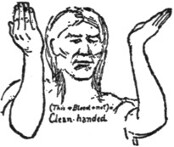
Clean-handed or Innocent (Great Spirit see no blood
on these hands). Lift hands over shoulder, palms up
higher than head and add Blood, No. (C) Or, sign
Work, Bad, No.
Fr. innocent; Ger. unschuldig.
Clear (Clear Sky). Sign Clouds, then swing the hands
wide apart, finishing with palms up at arm’s length, up
high. Or, sign Clouds, Wiped out. (Blackfoot.)
Clever. See Cunning.
Close, Near, Nearly, Soon, Early, About, or Almost
(Draw near). Bring the flat curved right hand, back to
right, well out in front of body, about height of shoulder;
draw the hand in toward the body and slightly downward.
Compare Far. See also Soon.
Fr. près, presque; Ger. nahe, beinahe.
Clothes. See Coat.
Clouds (Rolling). Rotate the flat hands over each
other from in front of the face, to over the head.
Clouds (Rain). Look upward, swing the flat hands at
arm’s length, palms down over the head; then add Rain.
Fr. les nuages; Ger. die Wolken.
Coal. Sign Hard, Fire, and Good.
Fr. le charbon; Ger. die Kohle.
Coat or Clothes. Hold the L hands near the breast,
palms in; swing them down to the waist.
Fr. l’habit; Ger. der Rock.
Coffee (Grinding coffee in mill). A few inches over the
flat left hand, back down, move the right A as though
turning the crank of a coffee mill. Or, sign Black
Drink. Compare Tobacco.
Fr. le café; Ger. der Kaffee.
Coin. Close hollow right over hollowed left and shake
as tho jingling coin. (Sheeaka; not Indian, but now
understood.) See Dollar.
Fr. la pièce d’argent; Ger. die Münze.
Cold (Shivering). Bring the fists in front of and close
to body, height of shoulder, elbows at sides, shoulders
drawn in, and shiver. See Winter. Compare Blanket.
Fr. froid; Ger. kalt.
Color. With the finger tips of right hand (thumb
crooked under) rub circularly on the palm of left hand as
though rubbing color. Often add Same or Equal, to make
more clear.
Fr. la couleur; Ger. die Farbe.
Black. Sign Color and touch the hair or eyebrow.
Fr. noir; Ger. schwarz.
Blue. Sign Sun with left hand and then draw the
right G finger around it to mean color of sky around
the sun. (Sheeaka). Or, sign Color and Sky.
Fr. bleu; Ger. blau.
Brown. Sign Color and Deer.
Fr. brun; Ger. braun.
Gray. Sign Color, Little, and White.
Fr. gris; Ger. grau.
Green. Sign Color and Grass.
Fr. vert; Ger. grün.
Red (Cheek color). Sign Color and lightly brush
the right finger tips over the cheek, points to right.
Fr. rouge; Ger. rot.
White. Sign Color and rub thumb nail of left A
hand with tip of right G finger; i.e., nail color,
white in Indians.
Fr. blanc; Ger. weiss.
Yellow. Sign Color and point to any yellow object,
such as a straw or dead grass. Or sign Color,
Grass, and Dead.
Fr. jaune; Ger. gelb.
For other colors, touch or indicate some object of the
tint meant.
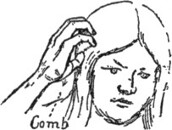
Comb. With all fingers of right 5 hand hooked, comb
the right side of the head and down as far as the breast
two or three times. Compare Woman.
Fr. le peigne; Ger. der Kamm.
Combat. See Battle.
Come. Carry right G hand, back out, fingers up, in a
graceful sweep from arm’s length to within a foot of
one’s face. Many use the flat hand swung down and to
you, palm under and toward you. Railroad men use
the whole arm, swinging it across the body at an angle
of 45 degrees, so as to be seen in a dim light.
Fr. venez; Ger. kommen Sie.
Come back. Hold flat left, back forward, near breast;
swing right ditto pointed up from arm’s length in
against back of left. See Arrive here.
Fr. revenez; Ger. kommen Sie zurück.
Come between or Intervene. Hold out left hand flat,
back out, at arm’s length and pass flat right, thumb up,
between left and body.
Fr. s’interposer, intervenir; Ger. dazwischen kommen.
Come gently. See Easy.
Come for a moment. Right hand held forward and up,
fingers closed except index, with which beckon by
crooking and straightening, the hand not moved.
(Pop.) White sign, now fully adopted by the Cheyennes.
Fr. venez une seconde; Ger. kommen Sie einen
Augenblick her.
Come into view or Appear. Hold out flat left hand, back
forward, thrust right G index up, farther off, under
and behind, until it appears above.
Fr. paraître; Ger. erscheinen.
Comfort (See how smooth or fat). Draw flat right hand,
palm in, down breast, then off and up in curve forward,
palm up. (Sheeaka.) Compare Confess. Sometimes
use Glad. (Blackfoot.)
Fr. le bien-être; Ger. die Behaglichkeit.
Comfortable. Alternately rub left palm over back of
right hand, then right over left back, always palm up;
then swing both forward. (Sheeaka. Probably from
Deaf.)
Fr. confortable; Ger. gemütlich.
Coming. Hold out the flat right, palm to you and
pointing nearly up; draw it to you in little jerks.
Fr. venant; Ger. kommend.
Coming man. See Rising man.
Commence. See Begin.
Compass points.
North—Wind cold there.
Fr. le nord; Ger. der Norden.
East—Sunrise there.
Fr. l’est; Ger. der Osten.
South—Wind warm there.
Fr. le sud; Ger. der Süden.
West—Sunset there.
Fr. l’ouest; Ger. der Westen.
Complete. See Done.
Comparative, etc., of Adjectives.
For Positive, give first the adjective then swing the
flat right hand out a little, level, palm up. (Sheeaka.)
For Comparative, give first the adjective then raise
the right G hand to the height of the chin, pointing
up. (Sheeaka.) See More, and sometimes use
Ahead or Above after the adjective.
Fr. le comparatif; Ger. der Komparativ.
For Superlative, give first the adjective then add
Strong and Ahead or Very much.
Fr. le superlatif; Ger. der Superlativ.
Conceal. See Hide.
Conceit (Swelled Head). Hold hands open and curved,
one on each side of the head, two or three inches away.
A whiteman’s sign, but quite well known now to the
younger generation of Indians.
If in unbelievable degree, stretch the right hand at full
length sidewise, and work the first finger as though
scratching the ear which is supposed to be just above the
hand. (Pop.)
Conceit. Sign He, Think, Strong.
Fr. la vanité, la présomption; Ger. die Einbildung, der
Dünkel.
Conduct. Same as Way.
Confess (Show the heart). Lay points of both compressed
hands on centre of breast, then spring them
away, out and aside, turning them flat and palms up.
Sometimes but one hand is used. I am inclined to
think that this should be simply Heart and Behold,
although none of my Indians made it that way. Sometimes
sign You, Tell, True.
Fr. confesser; Ger. gestehen.
Congress. Sign Whiteman, Chief, Council (No. 2).
Fr. le Congrès; Ger. der Kongresz.
Connivance (Wink, that is, close one eye). This ancient
sign assumes that the person who should see, closes the
eye next his accomplice. (Pop. Also Cheyenne.)
Fr. la connivence; Ger. die Konnivenz, das (strafbare)
Einverständnis.
Consider, Ponder, or Weigh (Wisdom looking on the
ground). Sign Wolf (i.e., wisdom, analogous with our
word “foxy”), then turn downward the points of the
two fingers representing the wolf ears, back of hand near
the eyes and moving the hand from right to left as in
surveying the ground. (Scott.)
Consider. Hold the right “4” hand near the heart,
pointing to left, rotate a little back and forth. (Blackfoot.)
The Cheyennes use V hand, which makes it the
same as If. See Because.
Fr. considérer; Ger. erwägen.
Constable. See Policeman.
Contempt. See Scorn.
Contented. To make contented, Satisfied. Use Glad
or Sit, Good. (Blackfoot.)
Fr. content; Ger. zufrieden.
Continue. Sign Go and Long Time. (Blackfoot.)
Fr. continuer; Ger. fortsetzen.
Conversation. See Discussion, Speech, and Talk.
Cook (In the abstract). See Make and Food.
Fr. faire cuire, cuisiner; Ger. kochen.
Cook (By boiling). With both L hands make a horizontal
circle, then holding left unchanged, put something
into it with right and add Fire. Compare Centre
and Hole.
Fr. cuire, bouillir; Ger. kochen.
Cook (By frying). Place flat right on flat left hand,
palm to palm, then flip the right like a pancake, turning
it palm up as it drops on the left.
Cook (By broiling). As in the above Frying, but leave
out the left hand entirely.
Fr. griller; Ger. braten, rösten.
Cook (noun). Sign Man, Makes, Food.
Fr. le cuisinier; Ger. der Koch.
Coon. See Raccoon.
Corn (Shelling the corn). Hold out the left A hand,
thumb straight and resting on index finger; place the
ball of the thumb of right A hand on back of left thumb
near its base; twist the right hand by wrist action to the
right and downward until the right thumb slips off with
a snap against the right index. Repeat once or twice.
Fr. le maïs; Ger. der türkische Weizen, der Mais.
Corral or Fenced Field or Pasture (Area embraced or
held). Interlock the fingers, hold arms curved in
front, horizontal; then add Enclosure, i.e., swing the
hands apart and draw back each in a half circle till their
heels meet near you.
Fr. le corral; Ger. die Einzäunung.
Council (Sitting in a circle and talking). Bring the
A hands, back outward, well out in front of body, a little
lower than the shoulders, little fingers touching; swing
them apart and toward the body so they meet close
to it, forming a horizontal circle; palms forward; then
add Discussion.
Council (2). Exactly like Across, but repeated two or
three times. This is a recent sign among the Cheyennes,
but is becoming popular. See Across and Law.
Fr. le conseil; Ger. die Ratsversammlung.
Counsel or Advice. See Advice.
Counting. See Numbers.
Count coup or Make a hit or a Strike (Striking a dead
body with the coup stick). Strike the top joint of the
right G index on the middle of the left G index, as the
right is swung from below up. Grand Coup sign Coup
and Great.
Fr. le coup; Ger. der Treffschusz.
Country. See Land.
Coup. See Count coup.
Courting (Driving or rounding up in secret). Thrust
the right L hand back nearly up under flat left, held
palm down, twisting the right by wrist action. Compare
Sweetheart and Glitter.
Fr. faire la cour; Ger. das Cour machen, das Hof machen.
Coward. See Fear.
Coyote. Sign Wolf and Small.
Fr. le coyote, le loup des prairies; Ger. der Präriewolf.
Crab. Place base of wrist of right hand, palm down,
on some flat surface, thumb and little finger extended
and curved (others closed) to represent claws. Then
move the hand sidewise backward, waving the claws.
(Scott.) Compare Spider.
Fr. le crabe; Ger. die Krabbe.
Crave. See Want.
Crayfish. Hold out the V hand level; draw it back,
opening and shutting the V. Compare Dog.
Fr. l’écrevisse; Ger. der Krebs.
Crazy, Foolish, Mad, Demented (Brain in a whirl).
Raise compressed right hand, all fingers together, tap
the forehead with it and make one or two quick circles
with finger tips in the air. (Sheeaka.) Tap the forehead,
shake the head and point to the person. (Pop.)
Crazy. Swing the 5 hand in horizontal circles near the
forehead, going with the sun. Going the reverse way
always raises a laugh among Cheyennes; it both intensifies
and makes the idea ridiculous.
Fr. fou; Ger. verrückt.
Cree. See Indian.
Creek, Brook, or Rill. Sign Water, then draw right G
hand, back up, held low, from opposite left side, past
body to right side; finger level, pointing to left and
waved sidewise. Compare River, Snake, Crooked, and
Wire.
Fr. le ruisseau; Ger. der Bach.
Crime or Sin. Sign Strong, Bad, Work.
Fr. le crime; Ger. das Verbrechen.
Crooked or Wrong. Point the right G forward and
slightly down; push it slowly forward in a succession
of large, horizontal zigzags, each arched a little.
Cross or Sulky. Rest the forehead low on the left
hand. Or sign Heart, Bad.
Fr. maussade; Ger. mürrisch.
Cross (of Christ). Hold right G upright, left G at right
angles across last joint of right.
Fr. le crucifix; Ger. das Kruzifix.
Cross. See Across.
Cross the heart. With right index make a little cross
over the heart. This means “I give you my word of
honor.” (Pop.)
Fr. parole d’honneur!; Ger. auf mein Ehrenwort!
Crow. Sign Bird and Black.
Fr. la corneille; Ger. die Krähe.
Crowded. See Few.
Crow Indian. See Indian.
Crush. See Exterminate.
Cry out. See Yell.
Cry, To weep. With G forefingers near the eyes trace
the courses of tears. If excessive, sign Rain from the
eyes. (Blackfoot.) Compare Pity.
Fr. pleurer; Ger. weinen.
Cunning, Smart, or Clever. Make the sign for Wolf
and add the sign Equal. Compare Consider.
Fr. rusé; Ger. schlau.
Cut. Saw the lower edge of the flat right across the
palm or edge of the flat left.
Fr. couper; Ger. schneiden.
Cutting up. See Meat.
Cyclone or Whirlwind. With flat right hand, back to
the right and level with the right shoulder, make a spiral
upward. A very small one for a little dust whirlwind,
and a large violent one for a dangerous cyclone.
Fr. le cyclone; Ger. der Wirbelsturm.
D
Dam. Sign for Stream or River and Hold. (Blackfoot.)
Fr. la digue, l’écluse; Ger. der Damm.
Dance (People jumping together). Bring the flat (or
“5”) hands in front of body about height of breast,
with fingers pointing nearly up, palms toward each other
about six inches apart. Move the hands briskly upward
and downward a few inches several times,
simultaneously, mostly by elbow action. Compare
People.
Dance (Drumming). Hold up one flat hand face high,
back to side, thumb raised and up: jerk up and down. (C)
Fr. danser; la danse; Ger. tanzen, der Tanz.
Danger (The Scout or Wolf going ahead and coming
back to report danger). Right V hand, back upward,
moved directly and slowly forward in front of the right
shoulder and then suddenly and quickly drawn back at
the same time the body is thrown back a little. (Sheeaka.)
Danger. Sign Look, Little, Afraid (No. 2).
Fr. le danger; Ger. die Gefahr.
Dangerous (Of a man). Sign Strong and Bad.
Fr. dangereux; Ger. gefährlich.
Dare you. See Challenge.
Dark, Unknown, Obscure. Bring the flat hands, back
outward, in front of face, right hand nearest face, left a
little ahead, hands crossed, tips of fingers about opposite
centre of forehead; bring the hands very slightly
toward face. Compare Ashamed and Blind.
Fr. obscur; Ger. dunkel.
Daughter. Sign Born and Female.
Fr. la fille; Ger. die Tochter.
Day. See Time.
Daybreak. Sign Little, Sunrise.
Daybreak (A peep through darkness). Hold right flat
hand above left flat hand and in same plane; right little
finger on left index then raise the right hand a few inches
higher. (C)
Fr. l’aube; Ger. der Tagesanbruch.
Dead, Death. Make the sign for Die and Sleep. (C)
The Cheyennes use Die.
Fr. mort; Ger. tot.
Deaf (Hearing ground out). Press the palm of extended
right hand slightly against right ear, and move
the hand in small circle parallel to and close to the ear.
Sometimes add Not.
Fr. sourd; Ger. taub.
Debt. See Owe.
Deceive. Sign Give and Lie.
Fr. tromper; Ger. betrügen.
Decide, Determine, Make up one’s mind (Think, then
act or settle it). Lower the head and raise right fist to
chin; then raise the head and cut down with the little
finger edge of the flat right hand. (Sheeaka.)
Decide. This is a sentence rather than a sign. With
4 hand over heart, sign Consider; point slowly in two or
three directions for Ways; sign That by vigorously
swinging the right G index out, pointing down; then
add So by raising it slightly up and then down. (Blackfoot.)
Fr. décider; Ger. sich entscheiden.
Decrease, Reduce, or Make smaller. Hold flat right
hand, palm down, high above, a little to the side of flat
left hand, palm up; move them together in succession
of little jerks. Sometimes for emphasis finish by compressing
all right fingers to a point in the left palm.
Compare Increase and Heap.
Fr. diminuer; Ger. verringern.
Decrepit, Old, or Broken down (Bent with disease or
age). Hold up G hand, back to right, higher than
shoulder; lower the hand several inches, at same time
bend the index. (C)
Decrepit. Hold up the right G, shoulder high, with
index bent in a hook; rotate as in Old.
Fr. décrépit; Ger. altersschwach, gebrechlich.
Deed. See Act.
Deep. Hold the left flat hand horizontal, chin high,
back up, fingers pointing to right; then drop right arm
to full length down with flat right hand palm up, under
left, fingers pointing forward.
Fr. profond; Ger. tief.
Deer. Both hands fully spread, palms in and held up
to the side of the head to represent the horns of a deer.
(Sheeaka.) This is generic for Deer. Compare Elk.
Fr. le cerf; Ger. der Hirsch.
Deer, Mule or Rocky Mountain Blacktail. Sign Deer
then set compressed hand at each ear pointing up and
forward to indicate the large ears, as in a mule. (Scott.)
Compare Bear.
Fr. le cerf mulet; Ger. der langohrige Hirsch.
Deer, Whitetailed or Virginian. Raise the right G
hand, pointing up and shoulder high; switch it from
nearly horizontal right to nearly horizontal left and
back, several times, pausing at the low point each time.
Sign Deer if need for clearness.
Fr. le cerf de la Virginie; Ger. der Hirsch aus Virginien.
Defame. See Abuse.
Defend, Protect, Defense, Forbid, or Protection. Sign
the same as the first part of Corral, but swing the joined
hands to left and right. So also to separate the hands
means to Loose or Remove protection. See Hold or
Protect.
Fr. défendre; Ger. verteidigen.
Defiance, Defy, Dare, Challenge, or I defy you. Point
the T hand toward the person. This is an extremely
insulting challenge implying also the extreme of hatred
and contempt. See Challenge.
Fr. le défi, défier; Ger. die Herausforderung, trotzen.
Defiance, Insolent. See Mockery.
Delight. See Excite.
Depart. See Go.
Describe, Explain, or Tell about (Tell all about it).
Sign Talk and All—that is, swing the curved flat right
hand, palm down, and to left, in a horizontal circle in
front of the right cheek.
Fr. décrire; Ger. beschreiben.
Desire. See Want.
Destroy. See Exterminate.
Determine. See Decide.
Devil. Sign Medicine, Horns, and Tail. A purely
modern sign.
Fr. le diable; Ger. der Teufel.
Dew. Sign Night, Grass, and the Shimmer; i.e., pass
curved right 5 hand, palm down, with a tremulous motion
just above the grass and add Water. (C)
Fr. la rosée; Ger. der Tau.
Die (To go under; i.e., underground). Hold left hand
flat, fingers horizontal, palm to you, breast high, pointing
to right. Hold right G hand pointing to left above
and within; pass it down, under and up beyond, still
pointing to left.
This is capable of modification. Thus passing the
right hand under and drawing it back means to be near
death but to Recover. To make the sign Little after
this means to Faint.
Fr. mourir; Ger. sterben.
Die out. See Melt.
Different or Wrong (Push aside). Hold up the flat
right, pointing forward and a little up, back to right.
Swing the whole arm a foot to right, forward and upward,
without bending the wrist, then back to first pose
and repeat; a much-used and very plastic sign. Compare
Bad and No.
Fr. différent; Ger. anders.
Difficulty. See Trouble.
Dig. Use flat right hand as a spade.
Fr. creuser; Ger. graben.
Dime. Sign White, Little, Money.
Dinner. Sign Noon or Night, as may be, and Eat.
Fr. le dîner; Ger. das Mittagessen, die Haupmahlzeit.
Direction. Point the G finger forward and down, swing
it forward in a curve till it is about horizontal and
pointing in the line intended.
Fr. la direction; Ger. die Richtung.
Dirt or Soil. See Earth.
Dirty. Rub the tips of the 1st and 2nd fingers with the
tip of the thumb, exactly as in Powder, and add Bad.
Fr. sal; Ger. schmutzig.
Disappear. Hold out the flat left, palm in, then shoot
compressed right, points first, over and down; then rub
upper edge of left with palm tips of right to mean wiped
out.
Disappear. Look around and sign See, Not. Sometimes
use Hide.
Fr. disparaître; Ger. verschwinden.
Disbelief. Sign That, True, I think, No.
Fr. l’incrédulité; Ger. der Unglaube.
Disciple. See Learner.
Discouraged. See Sorrow.
Discovery. Found out.
Discussion, Conversation, or Debate (In a general
sense). Hold out both flat hands, palms up, level, six
inches apart, breast high; swing both to left, then back
to right several times, to signify the handing of words
back and forth.
Discussion or Conversation (Between two). Make the
sign for Talk alternately right at left and left at right.
Fr. la conversation; Ger. das Gespräch.
Disgust or Dislike. Push both flat hands forward
palms out, fingers up, and turn away head. Or Heart,
Tired. (C) Sometimes use Scorn.
Fr. le dégoût; Ger. der Ekel.
Dismount. Sign Horseman, then separate and lower
right V hand, points up. If the points of the A hand
were down, it would mean “looking on the ground.” See
Mount.
Fr. descendre de cheval; Ger. absteigen.
Disobey. Sign Hear, Not. Compare Obey.
Fr. désobéir; Ger. nicht gehorchen.
Distant. See Far.
Distress. See Sorrow.
Fr. la misère; Ger. die Not.
Dissolve. See Melt.
Dive (To plunge into water). Place flat hands palm to
palm and make the action of diving.
Fr. plonger; Ger. tauchen.
Dive or Swoop (Like a bird in air). Hold out flat left
hand, back outward, bring flat right hand, back out,
some inches in rear of and higher than left hand, pointing
downward and forward; then shoot the right hand
downward and outward, back of hand grazing under
the left hand and up beyond. Compare Born.
Fr. s’élancer; Ger. niederschiessen au.
Divorce. Sign Marry, then swing the fingers apart
horizontally. This is a legal divorce. When Abandon
is used it means leaving one’s mate without legal
divorce.
Do. See Work.
Doctor. Sign Chief and Medicine. (C) The Cheyennes
omit Chief.
Fr. le médecin, le docteur; Ger. der Arzt.
Doer or The one who does or Man who (of all, that one).
Sign Man, then swing right G on the level a foot, and
back six inches; then raise and strike with same G down
on middle of the line. (Sheeaka. Apparently no other
Indian knew it.) The Cheyennes sign Man and Work,
or Man and Knows.
Fr. l’auteur, celui qui fait; Ger. der Täter.
Dog (Drawing lodge poles). With V hand back up in
front of body draw the double trail down and backward.
Compare Wolf. Seger maintains that the idea
here is the dog’s ears point backward as he runs. See
Bark.
Fr. le chien; Ger. der Hund.
Dollar. Sign Money and One. This would vary with
the country, the sign stands for the unit of currency.
Fr. le dollar; Ger. der Dollar.
Done, Ended, Finished, Complete, Period, or Full
Stop (Chopped off). Hold left hand flat, fingers touching,
point forward, thumb up and with edge of right
similarly held, chop down close past the tips of the fingers.
Also used as an auxiliary past tense, as I done eat.
Done (2) Finish, Quit, Break off. Hold up both fists at
level of chin, palms down, middle knuckles of left
touching ditto of right; jerk them a foot apart as though
breaking a cord; swing them apart, down, along and up.
This is also used as a Period at the end of sentence and
I have seen it used for Bankrupt. It is a northern sign
recently established among the Cheyennes. Compare
Fat and Break.
Fr. fini; Ger. fertig.
Don’t Care (I am defiant). Tap chest with tips of right
flat hand, then swing the hand briskly and high to
right, keeping palm facing the left. (Sheeaka.) Merely
shrug the shoulders. (Blackfoot.) The Cheyennes sign
Go ahead.
Fr. cela m’est égal; Ger. ich mache mir nichts
daraus.
Do not or Don’t. Hold up flat right hand, palm out,
and forward at an angle; sharply shake the hand by
wrist action back and forward (not sidewise), also sometimes
the head. Compare Easy and Rub it out. Sometimes
use Stop.
Fr. ne faites pas; Ger. tun Sie das nicht.
Don’t want. See under Want.
Door. Sign Teepee or House, then hold flat left hand,
thumb up, and lay flat right across the palm with little
finger of the right as the hinge; swing it till it lies flat
on left palm. (C) The Cheyennes sign House, then
pull and swing an imaginary door.
Fr. la porte; Ger. die Tür.
Doubt, I am doubtful. Very slowly shake the head.
(Pop.) Cheyennes and other Indians add—right hand
held out palm forward and down, open and shaken;
really a slow, slight Question sign. See If.
Fr. le doute, j’en doute; Ger. der Zweifel, ich bezweifle.
Down, Downward, or Below. Point straight down
with right G, lowering the same. (Blackfoot.) Some
use flat hand for this. Compare Here.
Fr. en bas; Ger. unten.
Down-hearted. See Sorrow.
Dream (See while sleeping). Sign Sleep and See; keeping
the eyes closed.
Fr. le rêve; Ger. der Traum.
Dress. Pass the palm of the L hand over the part of
the body to be covered. Compare Hat, Moccasin,
Robe, etc.
Fr. la robe; Ger. das Kleid.
Drink or Drinking (From a cup). The O hand to the
mouth as in drinking. Compare Want.
Drinking in the abstract would be: Draw the hollow
hand level to the mouth from slightly above and down
past chin, fingers pointing nearly forward. This combines
Water and Swallow. See Water. Compare
Speech.
Fr. buvant; Ger. trinkend.
Drinking liquor (Half a finger). Hold up right G hand
back to you, then lay left G across back to indicate
liquor, then add Drink. (Sheeaka.)
Fr. buvant une boisson alcoolique; Ger. Schnaps
trinkend.
Drive (Sense of driving a herd, or running off a herd).
With L hands horizontal, opposite each other and same
height, about an inch between tips of thumbs; move the
hands simultaneously in the direction of the drive.
Fr. mener; Ger. treiben.
Driving (A team). Hold both hands, backs out, as
though holding reins, thumbs straight, with index of each
around its point. See-saw the hands on the same level.
Fr. conduisant; Ger. lenkend, fahrend.
Drouth. Sign, Long time, Rain, No.
Fr. la sécheresse; Ger. die Dürre.
Drown. Sign Water and Die.
Fr. noyer; Ger. ertrinken.
Drum. With G fingers draw a large circle, beginning
together well forward, each making half-circle, ending
near body; then strike on it several times with right A.
Fr. le tambour; Ger. die Trommel.
Drunk or Drunkard. Sign Crazy, Drink, and Much.
Fr. ivre; Ger. betrunken.
Dry (Of a stream or spring). Sign Stream, Water, All
gone.
Fr. sec; Ger. trocken.
Dry. See Thirsty.
Duck. Sign for Bird and make the broad bill with flat
hand held under the nose, back up, pointing forward;
push it forward a few inches, or else with thumb below
and first and second fingers above.
Fr. le canard; Ger. die Ente.
Dull (Of a tool). Sign Cut and Not or Bad. Compare
Saw.
Fr. émoussé; Ger. stumpf.
Dull. See Dunce.
Dumb. Press the finger tips of the flat hand on the
mouth; add Talk and No.
Fr. muet; Ger. stumm.
Dunce or Dull (Blockhead). Strike forehead with right
fist knuckles. (D) A Cheyenne signed it Behind,
Book, Know, Not.
Fr. le benêt, l’imbécile; Ger. der Dummkopf.
During. See While.
Dust. Rub tips of right fingers with tip of right thumb,
as in Powder; then with flat right hand horizontal,
palm down, pat several times toward the earth. (Scott.)
See Earth and Land.
If the dust is in the air, pat down with one flat hand,
then wave both 5 hands, points up, near the eyes; sometimes
blink and draw back to make it more expressive.
Fr. la poussière; Ger. der Staub.
Duty (That, me, sends). Sign for That, Me, and Go
(emphatically).
Fr. le devoir; Ger. die Pflicht.
Dwell or Inhabit (Alive and moving about in). Right
flat hand, face high, pointing up, twisted slowly from
left to right two or three times. Compare Appear,
Alive, and Doubt.
Dwell (2) (Sitting, emphatic). One fist above the other
in front as though grasping a stake, then with both hands
push it down and slightly forward. (Blackfoot.) Compare
Sit.
Fr. demeurer; Ger. bewohnen, wohnen.
Dwindle. See Decrease.
E
Eagle. The sign for Bird is slowly made, then with the
G hand in front of the face, back to right, describe a
downward curve from between the eyes to indicate the
curved bill of the eagle. This same sign is given for
Roman nose, but hold the back of the hand forward.
Fr. l’aigle; Ger. der Adler.
Early. See Soon.
Early evening. Sign Sunset and Little of. (C) The
Cheyennes understood this, but preferred to swing the
Sun sign down to near, but not quite, level.
Fr. au commencement du soir; Ger. früh am Abend.
Early morning. Sign Little and Daybreak, or Sunrise.
Fr. de bon matin; Ger. frühmorgens.
Ear-rings. Make a ring of each index and thumb and
apply to each ear-lobe, backs of hands out, other fingers
raised.
Fr. les boucles d’oreilles; Ger. das Ohrgehänge.
Earth, the World (All land). Sign All with both flat
hands, palms down, then pat down with both hands
twice. Compare Land.
Fr. le monde; Ger. die Erde, die Welt.
Earth, Soil, or Dirt. Point down, then with thumb and
finger tips, lift and rub some imaginary soil as in Powder.
Fr. la terre; Ger. die Erde, der Schmutz.
Easy, Softly, or Gently. Hold flat hand at face height,
fingers half spread and a little curved, palm forward,
leaning toward the person and gently and slightly
shake the hand from side to side. (Sioux and Blackfoot.)
With slight modification, much used on the
railway in shunting. Compare Rub it out, Question,
and Do not.
Fr. doucement; Ger. sachte.
Eat or Food. Throw the nearly compressed right hand
lightly in a curve past the mouth several times. Compare
Water and Drink.
Fr. manger; Ger. essen.
Eaten enough (Full to throat). Sign Eat, then lay L
hand on breast, palm in, and raise it to opposite chin.
Compare Hang.
Fr. assez mangé; Ger. satt gegessen.
Effect. See Result.
Effort. See Try.
Egg. Sign Bird and Born; then indicate the size of the
egg with finger and thumb of one or both hands.
Fr. l’oeuf; Ger. das Ei.
Either, Or. Hold out left V hand, back up; tap each
finger in turn with right G. Compare Both.
Fr. l’un ou l’autre, ou ... ou; Ger. entweder ... oder.
Elk or Wapiti. Hold the hands above the head at arm’s
length on each side, thumb and first two fingers of each
spread, others closed; jerk them forward two or three
times for three or four inches. Compare Deer, Moose,
and Caribou.
Fr. le cerf du Canada; Ger. das Elentier.
Empty, Absent, Gone, or Out of. Place the right 5
hand, points up, in the left C hand, which is back,
forward, and down; drop the right hand down out of the
left, closing left to O. Compare All gone.
Fr. vide; Ger. leer.
Encamp. See Camp.
Encircle. See Surround.
Enclosure. Hold out both 5 hands level, palm to palm,
finger tips touching; swing them apart in a horizontal
circle; draw them back; end with fingers wide apart
and heels touching. A much-used sign. See Corral.
Fr. l’enclos; Ger. die Einzäunung.
End. See Done.
Endure, Suffer, or Stand it (Suffering, but strong and
erect). Hold flat curved right hand close in front of
breast, breathe heavily, swinging the hand near and
from; then raise the right A hand in a curve out and
up, about head high. (Sheeaka.) Understood, but not
used by Cheyennes.
Fr. supporter; Ger. aushalten, leiden.
Enemy. Sign Shake hands and Not. Sometimes use
Hate.
Fr. l’ennemi; Ger. der Feind.
Engaged or Betrothed (Ring-bound). Sign Prisoner,
then with right index indicate a ring on ring finger of
left hand. (D)
Engaged. Sign Bye and bye, Marry. See Courting.
Fr. fiancé; Ger. verlobt.
Engagement (i.e., Business). Swing the flat hands,
palms up, up and down for six or eight inches, as in
Road, but not progressing. Or, sign Road and Meet.
Fr. l’engagement, l’obligation; Ger. die Verabredung.
Enlist. Sign Work and Soldier.
Fr. enrôler; Ger. sich anwerben lassen.
Enough or Full in general sense (Levelling off a full
measure). Hold out left O hand, back to left, and across
the top from right to left pass the flat palm of the open
right hand. Sometimes add Strong, to mean Plenty.
See Eaten enough.
Fr. assez; Ger. genug.
Enter or Come into. Hold out hollow left, back up,
and pass compressed right hand under and beyond.
Fr. entrer; Ger. eintreten.
Equal, Even, Same, Too, Also (Even race). Hold G
hands in front of breast, side by side, backs up, pointing
to front, about two inches apart; push them forward
together and a little up in a sweep. A much-used sign.
Compare Race, Parallel, Marry, and Mate.
Fr. égal, le même; Ger. gleich, egal, genau so.
Erase or Annul. Sign Wrong and Wipe out. See Rub
it out.
Fr. effacer; Ger. auslöschen, ausstreichen.
Escape. See Free.
Even or Same. See Equal.
Evening. Sign Night and Little of. (C) See Early
evening.
Fr. le soir; Ger. der Abend.
Ever. See Always.
Evil or Sin. Sign Work and Bad.
Evil Eye. Close all fingers of right hand, except index
and little finger; to point these at any one means “You
have the Evil Eye.” In Italy this is an insult. (Pop.)
In France it means “Shame on you,” or “I put you to
shame.” (Pop.)
Fr. la main à corne; Ger. das Hexenauge.
Except or Unless. See But.
Excessive, Too much, Unjust, Too (Extremely, piled up).
With right palm down, make a succession of curves,
marking stages each higher than the last, beginning
very low; then finish by swinging both hands, palm
down, away up and forward. (Sheeaka.) Or sign
Heap. Sometimes use Enough.
Fr. excessif, trop; Ger. übermässig, zu viel.
Exchange. See Trade.
Excite, Agitate (Heart flutters). Sign Heart, then hold
the 5 hand near the heart, back to right, pointing
upward; raise it a foot shaking the fingers. The
Blackfeet use this for Glad, and in most cases among the
Cheyennes it implies pleasant excitement.
Fr. exciter; Ger. aufregen.
Excuse. See Wipe out.
Exist. See Be.
Expect. See Hope.
Explain. See Describe.
Exterminate, Annihilate, Crush, Destroy, etc. (Crushed
and wiped out). Drop flat right on flat left, palm to
palm, grind them together, then brush the right over the
left tips, to front and beyond. Compare Wipe out.
Fr. exterminer; Ger. vernichten.
F
Face. Sweep the flat right hand, palm in, across the
face and down. This is sometimes used for Person.
Fr. la figure; Ger. das Gesicht.
Fade. See Melt.
Faint. Signs for Die and Recover.
Fr. s’évanouir, faible, épuisé; Ger. ohnmächtig werden,
schwach.
Fall or Tumble. The right flat hand in front of breast,
back up, swept briskly out, forward up and down, to
rest palm up. Compare Another and Lie Down.
Fr. tomber; Ger. hinfallen.
Fall. See Autumn.
Fall (Of water). Sign River or Creek, then hold out
flat left, back out, and push flat right over it, bending
right fingers over far edge, making them tremble.
Fr. la cataracte; Ger. der Wasserfall.
Fail, that is, to lack success. See Cannot.
Fail (In business). Sign Work, Backward. (Blackfoot.)
The Backward is indicated by holding the flat
left well forward, drawing the flat right back in jumps.
Fr. faire faillite; Ger. bankerott werden.
False. See Lie.
Fame. See Glory.
Famous (Standing on a hill). Sign Hill, then over that
hold right G, palm forward, index just above left
thumb. Or, sign Chief and Brave.
Fr. fameux, célèbre; Ger. berühmt.
Far object, Distant or Far forward, Over there. Move
the G hand forward and upward in a long slow arch,
finishing at arm’s length with down curve.
Far (In general). Flat right hand curved, pointing to
left, back forward, pushed out and up at arm’s length.
Compare Close.
Fr. loin; Ger. entfernt.
Farm. Sign Land and Planting.
Fr. la ferme; Ger. der Pachthof.
Farmer. Sign Corn and Chief.
Fr. le fermier; Ger. der Ackerbauer.
Fast, Quick, Rapid, or Swift (Pass by). Hold out the
flat left hand, back to left. Bring the flat right hand,
back to right, several inches in rear of and slightly to
right of left, pointing to front and downward; carry
right hand swiftly past left and close to it, and as it
passes, by wrist action, raise the hand so that fingers
will point upward and in front, making a curve; at the
same time, draw back the left a little.
Fr. rapide, vite; Ger. schnell.
Fat (Shape of a fat animal’s hips). Hold the fists out
side by side, thumb to thumb, then swing them apart
in two curves, up, out, down, and a little forward.
Compare Done and Break.
Fr. gras; Ger. fett.
Fat or Grease. See Oil.
Father (Nurse, male). With compressed right hand,
pluck at the right breast two or three times, as though
drawing out milk. Sometimes add Male. Compare
Mother.
Fr. le père; Ger. der Vater.
Father-in-law. Sign Brother-in-law, Old, and Man.
Fault-finding (Striking, knocking). With flat right
hand, arm at full length, make a succession of short
chops down. This is fault-finding with another. For
“fault-finding with me” chop toward the breast.
(Sheeaka.) See Abuse, Chop, and By itself. The
Cheyennes use You, All time, Scold.
Fr. blâmer, censurer; Ger. das Tadeln.
Fear, Cowardice, Coward. The head stooped down
and the right arm thrown up, palm out, as though to
ward off danger. (Sheeaka.) The Cheyennes understand,
but prefer Woman, Heart. See Afraid.
Fr. la peur; Ger. die Furcht.
Feather (Small). Pluck an imaginary feather from left
arm with index finger and thumb of right hand and
blow it away from the mouth with one puff, at same
time opening the finger and thumb to let it go.
Feather, i.e., Quill Feather. Sign Wing, then make as
though pulling out and holding up One feather.
Fr. la plume; Ger. die Feder.
Feel (That is, heart feels). Place the tip of the middle
finger, others extended and lifted, against the heart;
then draw it up a little way. (D)
Fr. sentir; Ger. empfinden.
Feel or Touch (to touch). The hand as above, but
pushed forward and moved a little from side to side.
(Sheeaka.) See Hot.
Feel or Touch. Hold out left flat hand, back up; press
tip of right flat hand on it at various places. Compare At.
Fr. toucher; Ger. tasten, berühren.
Female or Woman. Draw the flat right hand, palm in
close to the side of the head, finger tips about on line
with the top of head; lower the hand, at the same time
curving fingers as though combing with them the hair
over ears and cheeks; finish with a snap at line of shoulders.
Two hands are used in the north. Compare
Comb. For White woman indicate an immense hat.
(Sheeaka.)
Fr. la femme; Ger. das Weib.
Fetch. See Bring.
Few. See Small.
Fight or War. Hold loosely clenched A hands well out
in front of body, thumbs toward body, about height of
shoulders and about three inches apart; bring right hand
in toward body few inches, at same time move left out
about same distance; then carry right out and bring left
in, repeating these two or three times, making them by
wrist and elbow action. This is a fight of many; for a
fight of two, use the G fingers same way. In old days,
according to Father Isadore, the signal for Battle was a
handful of dust thrown in the air. The gesture of doing
this came to mean Fight.
Fr. le combat, la guerre; Ger. der Streit, der Krieg.
Find. Sign Look around here and there, then shoot out
the V hand and pick up an imaginary something with
finger and thumb. Compare Choose and Hunt.
Fr. trouver; Ger. finden.
Fingers crossed, To claim Sanctuary. Also called Bar
up, King’s X, King’s Cross, Pax, Truce, Fins, Fines,
etc. Hold up right hand with first and second fingers
crossed. This means “I claim privilege, what I do now is
outside the game.” (Universal in our schools and probably
very ancient.)
Fr. être exempt; Ger. die Immunität, verschont sein.
Finish. Hold out flat left, palm up; rub flat right on it,
palm down, making two sunwise circles. Also use
Done.
Fire (Blaze, flaring up with smoke). Hold the right
hand down and forward at arm’s length, back in front
of the body; fingers hooked so the tip of thumb is over
the nails of first three fingers and holds them down;
raise the hand six inches and spring the fingers upward,
free, separate, and straight. Do this twice. Compare
Aurora.
Fr. le feu; Ger. das Feuer.
Fire, Spark of. Hold up right thumb and index as
though holding something and blow it steadily; add
Fire if needed for clearness. Compare Feather (small).
Fr. l’étincelle; Ger. der Funke.
Fire, Set it afire. Make the motion of striking a match
on the side of the thigh and thrusting it forward.
Fr. allumer; Ger. anzünden.
Fire off, Shoot, or Gun-Fire (Blaze shooting forward).
Right hand in front of right shoulder; throw palm forward
six inches and at same time straighten and spread
all fingers with a jerk. Some add a hand clap or many
for Volley firing.
Fr. décharger, faire feu sur, tirer; Ger. schiessen,
abfeuern.
First (Of all, number one). Hold up left 5 hand, palm to
right; push it forward, then tap the little finger with the
right G. (Sheeaka. A Sioux sign, but understood by
Cheyennes.) Compare Last and Guide.
First. Sign Ahead.
Fr. le premier; Ger. der Erste.
Fish. Make sign for Water; then hold flat right hand,
back to right, in front of right shoulder, elbow high;
and move the hand sinuously forward. Often omit
Water. Compare Snake.
Fr. le poisson; Ger. der Fisch.
Fisher or Pekan. Sign Marten and Big (suggested,
not established).
Fr. le pékan; Ger. der kanadische Marder.
Fix. Lay low edge of flat right hand on upper edge of
flat left near thumb base. Push right forward and
down, turning left back up. (C) Or, sign Work and
All right. Compare Mend, Council, and Law.
Fr. ajuster, arranger; Ger. herrichten, in Ordnung
machen.
Fix, In a Fix. See Quandary.
Flag. Hold flat right well out, back to right. Lay left
G on wrist of right. Wave right sidewise.
Fr. le drapeau; Ger. die Flagge.
Flat. See Prairie.
Flesh. See Meat.
Float. Flat left hand, back up; place flat right on it,
palm down, and move both to right as on waves. (C)
Understood by Cheyennes.
Fr. flotter; Ger. oben auf schwimmen, auf dem Wasser
treiben.
Flood. Indicate source of Water, then hold up both
flat hands, backs up, side by side, waist high; raise
them neck high and sign Charge. Omit Charge unless
needed.
Fr. l’inondation; Ger. die Flut.
Flour. Sign Bread and Powder.
Fr. la farine; Ger. das Mehl.
Flower, Bloom, or Blossom. Sign Grass, but higher;
then clasp right index and thumb over left ditto, others
closed; then turn the hands so the little fingers touch
and the thumbs point up. (C)
Flower. Sign Grow; hold both compressed hands together
in front, pointing up, backs out; spring them
out into 5 hands, forming a circle pointing up.
Fly (The insect). Sign Bird, Small; then point here and
there on the arm anywhere. Sometimes omit Small.
Fr. la mouche; Ger. die Fliege.
Fly (To). With flat hands held near shoulders simulate
wings, beating exactly as in Bird, but move the hands
forward a foot or more horizontally. Compare Bird.
Fr. voler; Ger. fliegen.
Fog (Water, peep through). Sign Water and hold the
5 hands, fingers crossed, in front of the eyes. (C) The
Cheyennes understand this, but prefer the next:
Fog (Mud in the sky). Sign Turtle, then raise both 5
hands, palms forward, from the horizon up high; then
spread them out. This expresses “turtles in the sky”;
probably because the sky is clouded as is the water
when the turtle moves in it.
Fr. le brouillard; Ger. der Nebel.
Follow or Chase. Left G hand pointing nearly up,
moved ahead and variously pursued six inches behind
by right G hand. Sheeaka used his thumbs for this.
Fr. suivre; Ger. folgen, nachlaufen.
Fond, Fondness, Love, Affection, Regard, etc. (Pressed
to the heart). Cross wrists of A hands, backs out, over
the heart, right nearest body, few inches from it; draw
both against the body and bend the head over them.
With one hand it is Like; with two hands, Love. (Blackfoot.)
Compare Blanket.
Fr. affectueux; Ger. zärtlich, liebevoll.
Food. See Eat.
Fool, Do you take me for a. With the right G index,
draw down the lower eyelid a little; as though to say,
“Can you see any green there?” (Pop.)
Fr. le sot, me croyez vous bête? Ger. der Narr, denken
Sie ich bin dumm?
Foolish. See Crazy.
Foolish or Unwise. Sign Crazy and Little of.
Fr. imbécile; Ger. närrisch.
Football signs. See page 233.
Footprints (Visible walk). Sign for Walk and for See
with the fingers pointed down. This is Human tracks;
for Horse tracks, sign Walk with the index and thumb
of each hand in a three-quarter circle, other fingers
closed, and then add See as here.
Fr. les empreintes des pieds; Ger. die Fusztapfen.
Footrace. Sign Walk quickly, and Race.
Fr. la course à pied; Ger. der Wettlauf.
For (Giving to). Throw the flat right hand forward and
palm down, slowly toward the object. Compare Stop,
Give, and Wait.
For. Sometimes use Belongs. Hold out the two G
hands nearly back up, a foot apart; swing them together
till the G tips are about two inches apart. (Sheeaka.)
For. Lightly close the right as though it held some
object, push it forward and upward, back to right.
(Blackfoot.)
Fr. pour; Ger. für.
Forbid. See Defend.
Forest, Timber, or Woods. Hold both forearms upright,
with all the fingers much spread, meaning Trees,
the right hand nearest the body, its back against the
palm of left; then separate them, drawing right hand
toward the body, moving the left away and upward in a
curve. See Tree.
Fr. la forêt; Ger. der Wald.
Forever. See Always.
Forgive. See Excuse.
Forget or Forgot (Swept from my brain). Touch the
forehead with the right N finger. Shake the head and
motion as though to brush away an imaginary fly from
near the nose. (Sheeaka and Pop.) See Remember not.
Forget or Forgot. Clap right hand down on left (for
surprise); lay right G, palm forward, on forehead, and
add Hid.
Fr. oublier; Ger. vergessen.
Forward (In space). See Ahead.
Forward (In time). See Future.
Found it. Sign I Saw, then reach forward and with
index and thumb pick up an imaginary object. Compare
Choose.
Found it. At a distance, hold both hands high above
the head, fingers closed, thumbs pointing toward each
other. (Pop.)
Fr. je l’ai trouvé; Ger. ich habe es gefunden.
Found out, i.e., You are found out. Point forefinger at
the person. (Sheeaka.) Or sign You, I, Understand.
Fr. démasqué; Ger. ertappt.
Four-foot. See Animal.
Fox. Indicate the size of animal and bushy tail.
Fr. le renard; Ger. der Fuchs.
Free, Escape, Safe, Save, Relief, Permit, Turn loose
(Unbinding). S hands crossed at wrists. With an
effort, break the imaginary bonds and throw the hands
apart, turning palm sides up. Sometimes add Go. See
Pardon.
Free, Wild, or Free of Incumbrance (Cut loose).
Hold flat right hand in front of breast, fingers forward,
back down; move by wrist action sharply to left a few
inches; then jerk back to place two or three times as
though cutting something loose. Compare Chop and
Wild Animal.
Fr. libre; Ger. frei.
Freeze over, Form ice. Sign for Cold, Water, then
raise and move till the flat hands are touching in front,
side by side, backs up and at arm’s length. (C) See
Ice.
Fr. geler; Ger. gefrieren.
Friend, Friendship, or Chum (Brothers growing up
together). Hold right N hand in front of neck, palm
forward, pointing up; raise it head high, slightly advancing
it. Alliance is sometimes used, or even Peace.
Fr. l’ami; Ger. der Freund.
Frog (Water hopper). Water; then with compressed
right hand make long hops forward.
Fr. la grenouille; Ger. der Frosch.
From. Touch digit of right G hand to right shoulder,
then throw it in a long sweep up and forward. Sometimes
Indians use flat hand for this.
Fr. de; Ger. von.
Frost. Sign, Cold, White, and Strong.
Fr. la gelée; Ger. der Frost.
Fruit. Sign Tree, then make a ring of right index and
thumb, others closed, and place it here and there in the
branches, and add Eat. Compare Berry, Leaf, and Money.
Fr. le fruit; Ger. die Frucht.
Full. See Enough.
Future (Time ahead). Make the signs for Time and
Far ahead. See also Will.
Fr. futur, l’avenir; Ger. zukünftig, die Zukunft.
G
Gallop. Sign Ride, then hold out flat hands, palm to
palm, right in advance; work them up and down together,
the tips describing vertical curves. Compare
Fast and Work.
Fr. galoper; Ger. galoppieren.
Gamble. Hold the hands out level, six inches apart;
swing to left and right simultaneously, in easy curves
down and up, keeping them near each other as though
swinging a tom tom. Compare Drive and Herd.
Fr. jouer; Ger. spielen.
Gap, Gorge, or Mountain Pass. Sign Mountains,
then hold out left L hand, thumb pointing to left and
upward, pass flat right between, touching at bottom.
Fr. le défilé; Ger. die Kluft, die Schlucht.
Garden. Strike down with right G as in Here, but in
several directions, then add Plant and Eat.
Fr. le jardin; Ger. der Garten.
Gather. See Together.
Generous. Sign Heart and Big; or, Heart, Pities.
Fr. généreux; Ger. groszmütig, freigiebig.
Gentle. See Kind.
Gently. See Easy.
Get or Obtain (That is, he gets, or obtains). Reach
out left hand, back up; then with right hand, grasp
something on top of it; then close and draw back the
right. If it is the first person who gets, finish by drawing
the hand toward oneself. Sometimes omit left
hand.
Fr. obtenir; Ger. erlangen, erhalten.
Get well. See Recover.
Ghost, Soul, or Spirit. Bring right G hand in front of
centre of body, pointing down; then draw it upward,
as though drawing the forefinger out of the mouth,
upward and to the front and at the same time exhale a
breath. (Scott.) The Cheyennes sign Big eyes (as in
Owl), and shaking the hands at the same time. See
Spirit.
Fr. l’esprit; Ger. der Geist.
Gift. Hold left hand, hollow up; with right hand pick
an imaginary object out of the left; carry it forward, at
the same time turning right hand flat, palm up, and fingers
pointing down and forward. Or, sign Give and
Free (2nd).
Fr. le cadeau; Ger. das Geschenk.
Girl (Woman sprout). Sign Female, Young.
Fr. la fille; Ger. das Mädchen.
Give. Hold out flat right, back to right, shoulder high;
swing it out and down.
Fr. donner; Ger. geben.
Give you. Swing the hand from the person giving
toward you. This, with the sign below, shows the beginning
of a conjugation.
Give me. Bring the flat right hand well out in front of
body, about height of neck, back of hand nearly to left,
lower edge nearest to body, pointing upward; draw the
hand in toward the body and a little down; at the same
time, bend the hand and the wrist so the fingers touch
the chest. Compare Tell me and Half-Breed.
Fr. donnez moi; Ger. geben Sie mir.
Give it up. See Abandon.
Give up, Lose hope, or Discouraged. See Sorrow.
Glad, Pleasant, Happy, or Merry (Sunshine in the
heart). Sign Heart and Day.
Fr. heureux; Ger. froh, glücklich.
Glitter or Shining (The mirror signal). Hold out the L
hand with index pointing forward, back up. Rotate
with a flash, or jerk so the thumb is upright and back
to its original pose. Do this once or twice. See
Courting and Sweetheart.
Fr. étinceler; Ger. glitzern.
Gloomy, Cross, or Sullen (Clouds close). Sign Clouds,
then draw them down near head. (C) Or, sign
Thinking and Bad. Compare Cross and Angry.
Fr. sombre; Ger. finster, trübe.
Glory or Fame. Sign All, Good, Know. See Famous.
Fr. la gloire; Ger. der Ruhm.
Glow, Splendor, Wonderful (Spread in the sky). Hold
up both 5 hands, palms forward, pointing up, at arm’s
length, nearly level; raise up very high and at the same
time spread widely. A much-used and very plastic
sign. May sometimes mean Weather.
Fr. la splendeur; Ger. das Glühen, die Pracht.
Go, Went, or Travel. Hold flat right hand, back to
right, breast high, pointing to front and down; swing
it up and out till the fingers point forward and upward.
Often combined with Arrive there.
Fr. aller; Ger. gehen.
Going. Hold up right G, palm forward; move it forward
in short pushes.
Fr. allant; Ger. gehend.
Go away, Go ahead, Go farther (Imperative). Hold
flat right hand in front of body, palm forward, fingers
upright; move the hand to front in a slight curve to
right; repeat once or twice. See Begin.
Fr. allez! Ger. gehen Sie!
Goat. Sign Horns, with the straight G fingers on each
side of head, and Beard. Sometimes omit Horns,
signing only Beard.
Fr. la chèvre; Ger. die Ziege.
God (The Great Mystery). Sign Medicine and Great.
Fr. Dieu; Ger. Gott.
Gold. Sign Money and Yellow, or Hard and Yellow.
For Gold coin sign, Chief, Money.
Fr. l’or; Ger. das Gold.
Gone. See Absent.
Good, All right, Level, Fair, Just (Level
with the heart). Hold the flat extended
right hand, back up, level, touching the
left breast; swing the hand briskly out
to front and slightly up in a curve.
Fr. bon; Ger. gut.
Good-bye. Hold right hand flat, palm down, pointing
forward horizontally at height of head and shake the
hand up and down by wrist action. A whiteman’s
sign recently adopted by Indians.
Fr. adieu, au revoir; Ger. lebe wohl!
Good-morning. Sign Day and Good.
Fr. bonjour; Ger. guten Morgen.
Goose. Sign Bird, moving the wing hands slowly;
hold both flat hands low, side by side, a little apart,
backs up; push them down sharply a few inches, for flat
feet. Sometimes also make the honk sound.
Fr. l’oie; Ger. die Gans.
Gorge. See Gap.
Gossip. See Telltale.
Grain, of any kind. Hold both hands hollow together,
as in Bowl; shake, then point to the hollow of the left
with right G. (Sheeaka.) The exact kind must be
specified. In Cheyenne, Wheat is Bread and Sow; Oats
is Horse, Eat, Sow.
Fr. le grain; Ger. das Getreide.
Grandchild. With the flat right, pat one’s own back
where the baby is carried. Among the Cheyennes, only
the grandmother uses this.
Grand Coup. See Count Coup.
Grandfather. Sign Old and Father.
Grandfather (Father once removed). Sign Father,
then hold curved left hand in front of body, palm in;
and on outer side make the sign Father again. For
Great grandfather, repeat the sign for Father once more.
For Ancestors, many times. (Crow signs given me by
La Forge.)
Fr. le grandpère; Ger. der Groszvater.
Grandmother. As above, but use Mother sign. (LaF.)
Grandmother. Sign Old, Mother.
Fr. la grand-mère; Ger. die Groszmutter.
Grasp. See Keep.
Grass. Hold both hands low, palms up; turn all fingers
upward straight and swing hands slightly apart. For
Grass growing, raise the hands a little. Compare Children.
Fr. l’herbe, le gazon; Ger. das Gras, der Rasen.
Gratitude. Use Thank you sign. Or else raise the flat
right hand, palm forward and face high; draw it downward
in a sweep several times as though stroking the
other person’s breast. For emphasis use both hands.
Fr. la reconnaissance; Ger. die Dankbarkeit.
Grave. Hold out both flat hands, thumbs up, six
inches apart, pointing level forward; draw them back
level to you, sign Die; then hold out left flat hand as
before and slap on it two or three times with the flat
right, for cover up.
Fr. le tombeau; Ger. das Grab.
Great. Hold out the slightly curved 5 hands in front
of breast, few inches apart, palms toward each other,
pointing to front; separate hands the right to the right
and up a little and near the body; the left to the left
and down a little and farther away. Compare Big
and Wide. Sometimes use Much or High.
Fr. grand; Ger. grosz.
Greater than. Sign Ahead, Great. So also Less than
would be Behind, Small.
Fr. plus grand que; Ger. gröszer als.
Grief. See Sorrow.
Grieve. Sign Heart, Down. See Give up and Mourn.
Fr. se chagriner, pleurer; Ger. trauern.
Ground. See Land.
Grouse or Prairie Chicken. Sign Bird and show size;
then with right hand low, palm up, fingers closed except
first curved up like neck, imitate forward walking.
(Sioux.) Sign Bird then indicate fast wing beats and
whirring. (Blackfoot.) Sign Bird and Tail cut off.
(Cheyenne.)
Fr. la gelinotte; Ger. das Waldhuhn.
Grow, Become, or Turn into. Hold right G hand low,
back down, index finger pointing upward, in front of
body; raise the hand by gentle jerks.
Fr. pousser, croître, devenir; Ger. wachsen, werden.
Guide (Verb). (Show trail and Lead.) Point with
right index forward and downward; then add Lead.
(Sheeaka.)
Fr. conduire; Ger. führen, leiten.
Guide (Noun). Hold up left 5 hand, little finger forward,
and ahead of the right G, all moved forward in
easy swings.
Fr. le guide; Ger. der Führer.
Gun. Make the motion of holding and aiming a gun;
then add Fire-off. For Rifle, add the working of the
lever.
Fr. le fusil, la carabine; Ger. das Gewehr.
Gun, i.e., Shot-gun, sign Gun, then clasp the hands
twice and hold up two fingers. See Revolver.
Fr. le fusil de chasse; Ger. die Flinte.
Gun-fire. See Fire.
Gun-powder. Sign Gun and Powder.
Fr. la poudre à canon; Ger. das Schiesspulver.
H
Habit (Thought bound). With G forefinger draw a
small circle on forehead, then sign Prisoner. (D)
Habit (Road smoothed by repeated strokes). Sweep
the flat hands, palms down, back and forth; then strike
three times down with the right G. (Sheeaka.) Or
sign Way and Keep. (Seger.)
Habit (Long time the same). Hold out left G, draw
right G back from left knuckles to shoulder; add Same.
Fr. l’habitude; Ger. die Gewohnheit.
Hail. Sign Rain, Cold, and with curved right index on
thumb indicate size of stones.
Fr. la grêle; Ger. der Hagel.
Hair (Of animal). Hold out left forearm horizontally
in front of body and sweep the curved right 5 hand,
palm up, along it from elbow to wrist. For Human
hair, touch one’s own hair. Compare Wing.
Fr. le poil; Ger. der Pelz.
Half. Hold left flat hand in front of breast, back out.
Lay the lower edge of right flat hand on upper edge of
left index, in middle, and jerk it toward the tips of left.
Sometimes the right hand alone is used edge downward,
drawn back and down as though its under side were cutting
something. Compare Part.
Fr. le demi, la moitié; Ger. die Hälfte.
Half-breed. With flat right hand pointing up, little finger
next middle of the breast, palm to right, halve the body
down breast, swing it far to left, return to centre, then
swing far to right and give the tribal sign for each half.
Or, give the first sign only; that is, the hand cutting
in the middle.
Fr. le métis; Ger. der Mischling.
Halt or Stop. Hold the right flat hand, palm outward
and downward, in front of the body, pointing upward
and to front, hand about height of shoulders; move the
hand sharply to front and downward, stopping it suddenly.
Sometimes merely raise the hand flat forward.
This means also Keep quiet, Wait a moment, etc.,
when made gently. “This sign is world wide. In a
journey around the world, I have used it in every country
visited and found it instantly recognized. I saw a
train stopped by it in the Himalayas, also jinrikishas
stopped in Java, Singapore, Saigon, Canton, Hong Kong,
Nagasaki, and Manila.” (Scott.)
Fr. Halte! Ger. Halt!
Halve. Same as Half; but jerk one part to right and
one to left. (C)
Fr. couper ou diviser en deux; Ger. halbieren.
For One-Quarter, lay the “knife hand” at last joint of
left index; for Three-Quarters, near base; see also
Quarter.
Fr. le quart; Ger. das Viertel.
Handsome. See Beautiful.
Hang (To be executed). Swing the right L hand over
the head down to the neck, palm in; close the thumb and
index, then draw it up to height of head, index pointing
down. This is done in two graceful sweeps.
Fr. pendre; Ger. hängen.
Hang. Hang right G index like a hook on straight left
G index.
Fr. accrocher; Ger. aufhängen.
Hanker. See Want.
Happen. See Luck.
Happy. See Glad.
Happy Hunting Ground. Sign Die, Beyond, and Dwell.
Fr. les Champs Elysées des Indiens; Ger. die seligen
Jagdgefilde.
Hard (Like rock). Hold out the left hand flat, edge
down, and strike the palm with the knuckles of the right
two or three times.
Fr. dur; Ger. hart.
Hat (Head cover). Bring the L right hand, back outward,
in front, close to, and a little above the head;
lower the hand until thumb and index are about opposite
the eyes; spread thumb and index, passing down
close to forehead.
Fr. le chapeau; Ger. der Hut.
Hatchet. See Axe.
Hate. Hold up both hands opposite left side of face
in pose for Fire-off, back of each to its side; spring both
out as in Fire-off, to left side, turning the left very little,
so that it shoots forward; the right shoots to the left.
Compare Abandon and Scorn; also Defiance. Sheeaka
used only Defiance sign.
Fr. détester; Ger. hassen.
Have (To possess). See Possession.
Have to, Bound to, Must, Obliged to, Compelled to
(Bound down). Sign Prisoner and Work. Or, That,
Work, Strong.
Fr. être obligé; Ger. müssen.
Hawk. First make Bird sign, then imitate the seizing
of the prey with both feet hawk-fashion, by means of
both hands placed in front of body opposite neck, palms
outward, make grasping motion forward. (Scott.)
Or sign Bird and with curved G indicate bill. See Eagle.
Fr. le faucon; Ger. der Habicht.
He. Make the sign Male; or point with the thumb,
other fingers closed.
Fr. il; Ger. er.
Headache. Touch head; then hold curved flat hand
near and flirt the fingers from behind the thumb two or
three times to show the throbbing.
Fr. le mal de tête; Ger. das Kopfweh.
Healthy. See Well.
Heap or Very Much. With curved hands show shape,
beginning at the lowest points. Compare Many,
Mound, and Much.
Fr. l’amas, le tas; Ger. der Haufe(n).
Hear. Move the right G hand (pointed forward) from
behind the right ear, past the ear and forward. Compare
Listen and Indian Nez Percé.
Fr. entendre; Ger. hören.
Heart. Bring the compressed right hand against the
left breast, over heart and pointing downward.
Fr. le coeur; Ger. das Herz.
Heat. See Hot.
Heaven. Simply point up with right G, back to right
and head high. Compare Heavens and Happy Hunting
Ground; also, Tall.
Fr. le paradis; Ger. der Himmel, das Paradies.
Heavens, Skies, or Sky. Hold both flat hands palms
down, tips touching, over and in front of the head;
sweep them down sidewise in outline of the dome. Compare
Clouds, Carriage, Hot Weather.
Fr. le ciel; Ger. der Himmel.
Heavy (Cannot hold up). Hold flat hands, a few
inches apart, at same level, backs down, in front of
body and pointing to front. Raise them slightly and
let them drop several inches, finishing low. Compare
Light.
Fr. lourd; Ger. schwer.
Help. Hold left forearm horizontally in front of body,
hand A, and place flat right hand under left forearm and
lift it slightly. (Sheeaka; borrowed from the Deaf.)
Or, sign Work and With.
Fr. aider; Ger. helfen.
Her. See Possession.
Herd of Animals. Hold out left 5 fingers a little curved,
level, far advanced, shoulder high, backs up and out;
moved forward and a little down together. For Herd grazing
hold right 5 over left 5 wrist; draw right back toward
body in a slight arc up and down.
Fr. le troupeau; Ger. die Herde.
Herd (Verb). See Drive.
Here (This spot). Swing the right G, back up, from
pointing up, to forward and down; then stab toward the
ground two or three times. Compare Down, Earth,
Place.
Fr. ici; Ger. hier.
He who. See Doer.
Hide, To Cache, Conceal, or Lose. Swing the flat or
else compressed right hand, palm down, under the flat
left hand held in front, palm down; the left hand rests
on the right at end of sign. (Sheeaka.) Sometimes
add Hush. Compare Enter and Night.
Fr. cacher; Ger. verstecken.
Hide (Skin). Hold extended left hand, back up, in
front of body, and with the right thumb and forefinger
gather up, with a pinch, the loose skin on the
back of left hand. Sometimes sign Robe.
Fr. la peau; Ger. das Fell.
High or Height. Hold the flat right hand, back nearly
up, pointing to front, in front of right shoulder; raise
the hand according to the height intended. If it refers
to humans, hold the right hand (compressed or G)
vertically pointing upward. (C) To show height of
small objects or animals, hold the flat left, palm up,
under right. See Tall.
Fr. haut; Ger. hoch.
Higher. See Superior.
Hill, Bluff, or Butte. Push right A fist, back out,
straight up, face high. For plural use both hands moved
alternately up and down at different places. Compare
Ridge, Lump, and Mountain.
Fr. la colline; Ger. der Hügel.
His. See Possession.
History or Story (Pictures of the past). Hold up flat
left, palm forward, and sketch on palm with right G;
then sign Past. (C) Or, Sign Long, Past, Tell me.
Fr. l’histoire; Ger. die Geschichte.
Hit (To make a hit). See Count Coup.
Hoax (To wolf or beguile). Sign I, Make, Him, Wolf.
(Seger.)
Fr. mystifier; Ger. jemandem etwas aufbinden.
Hog or Pig. Indicate size, then with a circle of two
thumbs and two index fingers in front of mouth show
muzzle; last, with flat right hand, or flat fist back up,
make a snout and root. Usually give only the last sign.
Fr. le cochon; Ger. das Schwein.
Hold (to hold a prisoner). Arms in a level circle, flat
right hand inside flat left and overlapping, both palms
toward you; swing to right and left. Compare Defend,
Keep, and Corral.
Fr. tenir prisonnier; Ger. gefangen halten.
Hole. Form a circle with thumbs and fingers of L
hands. If need be, for clearness, hold left hand in
position and pass the compressed right through the
imaginary hole. Compare Cook and Boil.
Fr. le trou; Ger. das Loch.
Holler. See Yell.
Home. Sign My, Teepee.
Fr. la demeure, le foyer, le chez-soi; Ger. das Heim.
Home-sickness. Sign Heart, Want, and Teepee.
Fr. le mal du pays; Ger. das Heimweh.
Honest (Straight walk). Point right G straight forward
from near throat; push it down and up in a slight curve
till it is upright, then push it forward in two or three
little jerks. See also True.
Fr. honnête, intègre; Ger. ehrlich.
Honor (Upon my honor). With right index draw a small
cross on the heart. (Pop.)
Fr. parole d’ honneur! Ger. auf Ehre! bei meiner
Ehre!
Hope. Sign Heart, Want.
Fr. l’espoir; Ger. die Hoffnung.
Horse. Hold the flat left hand, back to front, before
face, fingers level; move it to right; and then, for a
moment, place the first and second fingers of right
astride it, as in Ride. Some omit the last gesture. The
movements of the hand indicate the height, action, and
speed of the horse.
Fr. le cheval; Ger. das Pferd.
Horseman. Sign Man and Ride. Or, place the V right
astride of the flat left and push both to right.
Fr. le cavalier; Ger. der Reiter.
Hot or Heat (As water or iron). Hold the hand as in
Feel; touch the middle right finger tip to tongue; reach
it forward and down, as though touching a hot iron,
quickly jerking it back. (A northern sign understood
by Cheyennes.) The use of the middle finger is general,
no doubt because it is longest.
Fr. chaud; Ger. heisz.
Hot weather (Rays of sun beating down). Hold the 5
hands a few inches apart, backs up, above and in front
of head, pointing toward each other. Lower the hands
to level of face.
Fr. les grandes chaleurs; Ger. das heisze Wetter.
Hot or Sweating (Personally). Draw right index
crooked across the brow, left to right, as though to run
off the sweat, others and thumb closed.
Hotel. See Restaurant.
Hour. See Time.
House. Indicate the double slope of the roof by flat
hands, pointing nearly up and joined together at the
tips. Some use only the next sign for House.
Fr. la maison; Ger. das Haus.
House of logs (Corners of a log house). Bring the
hands in front of body and interlock the fingers near
tips, fingers at nearly right angles and horizontal.
Some add Roof by joining tips of flat hands as in House.
Compare Basket.
Fr. la cabane en bois, la hutte; Ger. das Blockhaus.
How! or Ho! The Indian salutation is sometimes used
with hand salute; that is, all fingers closed except index
and middle, as in Friend.
Fr. Ho! Ger. Grüsz Gott!
How? See Question.
How many? See Question.
How much? See Question.
Hundred (Whole circle of tens). Hold up both 5 hands,
palms forward, opposite right shoulder; thumbs nearly
touching; swing to left and down. Precede this with
one for one hundred, two for two hundred, etc.
Fr. cent; Ger. hundert.
Hungry or Hunger (Cuts one in two). Draw the lower
edge of flat right hand, back down, across the stomach;
emphasize by drawing back and forth.
Fr. avoir faim, la faim; Ger. hungrig sein, der Hunger.
Hunt or Searching for (In the sense of seeking for).
The fingers of the right V hand brought near the eye,
but pointing forward; then swing horizontally from side
to side, the eye looking wherever they point. Compare
Choose, Find, and Look. Or, shade the right eye with
the right hand and swing the head. (Pop.)
Fr. chercher; Ger. suchen.
Hunting (With gun or bow). Hold out both G hands,
one behind the other; swing in up-curves forward and
sidewise, but always one behind the other.
Fr. chasser; Ger. jagen.
Hurry, to Come or to Go quickly. Make the sign for
Come (or Go) three or four times, very quickly and
emphatically. (Sheeaka.)
Hurry (Ride fast). Jump the flat hands up and down
before you, quickly, palms up. Compare Light, which
is similar, but slower.
Fr. se dépêcher; Ger. eilen.
Husband. Make sign Male and Marry.
Fr. le mari; Ger. der Mann; der Gatte.
Hush. See Silence and Halt.
Hypocrite. Sign Wolf and Like. Or Face and Two.
According to Ruggles, the Paiutes sometimes use this
second combination for Liar; the Cheyennes understand
it but do not use it.
Fr. le hypocrite; Ger. der Heuchler.
I
I, Me, Myself, Mine. For I touch the centre of the
breast with the right thumb extended, other fingers
closed. This and the next are used indiscriminately
by the Cheyennes.
Me is touching the breast with point of compressed
fingers.
My. Lay the A hand on the forehead, palm to left,
thumb pointing up; swing it forward and down level;
that is, sign Possession, assuming the first person.
Fr. je, moi, mien; Ger. Ich, mich, mein.
Ice. Sign Water and Hard. Sometimes add Cold.
Fr. la glace; Ger. das Eis.
Icicle. Sign Water and Cold; then hold up right G,
pointing downward and dropped a little.
Fr. le glaçon; Ger. der Eiszapfen.
Idea, Thought (Thought expressed). Lay the right G
on the forehead, pointing up, palm to left; swing it
down to horizontal at mouth level, then push it straight
forward and up in a curve. Compare So.
Fr. l’idée; la pensée; Ger. die Idee, der Gedanke.
Idle. Sign Work and Not.
Fr. paresseux; Ger. müszig.
If, Doubt, Undecided, Perhaps, or Maybe so (Heart
looking two ways). Lay the right V hand on the heart,
pointed down and to left front; rotate the hand on the
wrist so the back is alternately up and out. When
many emotions (i.e., perplexity) are to be expressed,
use all fingers extended. See Consider.
Fr. si, peut-être; Ger. wenn, ob, vielleicht.
Ignorance (I don’t know). Shrug shoulders and raise
one flat hand. (Pop.) Or, sign Know, Not. Compare
Forget.
Fr. l’ignorance; Ger. die Unwissenheit.
Imperative Mood. Sign the verb in question, then
strike the flat right, palm down, onto the flat left, palm
up. Or add Push. (C)
Impossible. Sign Can and Not. See also Cannot.
The Cheyennes use True, Not.
Fr. impossible; Ger. unmöglich.
Imprison. See Arrest.
In, Inside, or Within (To put into). Make a semicircle
of the left arm held out level; then drop the compressed
right hand downward between the left and the
body. Outside begins the same, but the right drops
outside the left.
Inside, i.e., in a Hole. Make a horizontal ring of the
left index and thumb, then drop the right index down
into it. For a house, use Enter.
Fr. en, dedans, dans; Ger. in, drin, im Innern.
Incite. Sign Push, Talk, and Go; that is, try to talk into
going.
Fr. inciter; Ger. anreizen.
Increase. Hold out the flat hands, palm to palm, well
apart at same height; separate them more and more in
slight jerks; or, if it is more explicit, do it with the flat
hands one above the other. See Add to. Compare
Decrease.
Fr. augmenter; Ger. vermehren, vergröszern.
Indian. With the tips of right flat fingers, rub the side
of the flat left held out back up, in short strokes; meaning
reddish, because all men’s hands out west are red
at this place. Compare Smooth.
Indian. Indicate the eagle feather at back of head.
(Sheeaka.) Or sign Man and Red. (Scott.)
Fr. l’Indien; Ger. der Indianer.
Indian Tribe or Nation. Give the Tribal sign and add
All in each case.
Indian Tribal signs:
Apache. (Probably using the notched-stick fiddle).
Draw the right G finger up and down along the left
G several times, from near the point to the base, a
foot long each stroke. Compare Poor.
Arapahoe. With all fingers of right hand compressed
so the points are together, tap the left breast, that is,
sign Mother. As Sherman Coolidge tells me, the
Arapahoes claim theirs to have been the mother of all
tribes. In the south, the sign is rub the side of the
nose with the right G, referring to their one-time
salutation of nose-rubbing.
Banak. Sign for Lodge and Bad. (C)
Blackfeet. Sign for Moccasin and Black.
Caddo. Draw the right N over the left N from the
tips back to the knuckles (because they wore pants).
(Father Isadore.)
Cheyennes. (Perhaps meaning “striped tail,” because
they used turkey feathers; or, more likely, “finger-choppers,”
because they chopped their fingers when
in mourning.) Hold out left G finger and cut it with
the edge of the right G finger drawn across it once or
twice, each time further up the hand. Compare
Often and And all the time.
Chippewa. See Ojibwa.
Comanche. Sign for Snake, pushing the hand forward.
Compare Shoshoni. (Seger.)
Cree. Sign Rabbit, People; but usually omit People.
Crow. Sign Bird slowly. Sometimes only one hand.
Or hold S hand, palm forward, at brow for “Pompadour
Indians.”
Dakota. See Sioux.
Flathead. See Koutenais.
Gros Ventre. Sign Big Belly.
Hopi. Sign Dance and Snake.
Kiowa. With the tips of the flat right, palm up,
back to left, describe an upright ellipse near the right
ear; because they used to cut their hair on that side
to show the ear ornaments or ear painted red.
Koutenai. Sign for White-tailed Deer. (C)
Mandan (Tattooed chin and cheek). With right hand
compressed so all tips touch, tap the chin and jaw.
(C)
Navaho (Makers of striped blankets). Sign for Work,
Blanket, and Striped.
Nez Percé (Pierced nose). Pass index of right G
hand level under nose from right to left. Compare
Hear.
Ojibwa or Chippewa (Living in the Woods). Sign
Tree and People; or sign Paddle, People. (Blackfoot.)
Osage (Shaved heads). Rub the flat right hand, palm
out, over the side of the head and down, as though
shaving the head; the little finger being the sharp
edge.
Paiute. Sign Rabbit, Robe.
Pawnee (Wolf). Hold up the right V hand, palm
forward, near right ear; then swing finger-tips forward.
Piegan. Rotate half closed hand, palm in, near right
cheek.
Pueblo. Sign Two Quivers; that is, Arrow, Two; then
drop compressed left once or twice into C right hand.
Sac (Shaved heads). Same as Osage sign.
Shoshoni or Snake Indians. Sign for Snake and
sometimes add Bad, Lodge.
Sioux (Cut throats). Draw the right G finger across
the throat.
Uncapapa (From their position in camp). Sign for
Sioux and Encamp, then make an incomplete circle
with index fingers and thumbs; then, holding left
in pose, strike last joint of index with tip of right G
and similarly right index with tip of left G. (C)
Ute. Sign Black and Red.
Wichita (Tattooed rings). With right G finger tap
the forehead in a circle.
Yankton. Sign for Sioux and Nez Percé. (C)
Indian Agent. See Agent.
Indifference (None of my business). Both hands held
down by the thighs; at the same time a shrug of the
shoulders. (Pop.)
Fr. l’indifférence; Ger. die Gleichgültigkeit.
Infantry. Sign Soldiers and Walk.
Fr. l’infanterie; Ger. die Fusztruppen, die Infanterie.
Inferior (To one). Hold up both G fingers, the one
representing the inferior much lower.
Inferior (To many). For several inferiors use the 5
hand to represent them, while the G of the other hand
up high represents the superior.
Fr. inférieur; Ger. untergeordnet.
Inhabit. See Dwell.
Injure, Doing evil to. If with reference to another person,
make sign for Work and Bad. If with reference to
one’s self, make signs Do, to me, Bad.
Fr. faire du mal; Ger. beschädigen.
Innocent. See Clean-handed.
In order that. See So that.
Inside. See In.
Interrogate. See Question or Query.
Intervene. See Come between.
Invalid. See Sick one.
Investigating. See Searching; also Consider.
Iron. See Metal.
Island (Round thing surrounded by water). Sign Land,
then with L hands make a horizontal circle; hold left
hand in pose, sign Water with right hand; then compress
it and draw it point down around the circle just
made. Compare Lake.
Fr. l’île; Ger. die Insel.
Itching. Scratch the left palm with nail of the right G
index; or else the thigh.
Fr. la démangeaison; Ger. das Jucken.
J
Jealous (Elbowing aside). Hold the fists near the
breast; alternately swing each elbow out and back a
little. (C)
Jealous (Hide and stab). Hold out flat left, back up,
and with right G stab under it once or twice.
Fr. jaloux; Ger. eifersüchtig.
Jesus (The Cross above). The right G finger upright
and crossed on top with the left G; this cross then
placed above the eyes, the face looking upward; then
the cross pushed toward the sky to the full extent of the
arms. The real meaning being, “He who was crucified
and is now in heaven.” (Scott.) Or sign Big, Medicine,
Child.
Fr. Jésus; Ger. Jesus.
Joke (Play talk). Sign Play; that is, hold the right
5 hand near the mouth, back down, fingers a little
curved; swing the hand forward and upward; then add
Talk.
Fr. la plaisanterie; Ger. der Scherz.
Joyous. Sign Heart, Glad, and Sing. (C) Sign
Heart, Happy, or Playing.
Fr. joyeux; Ger. fröhlich.
Judge. See Consider.
Jump (Human). Stand right V on left palm; assume
these to be legs and make them jump up and down.
(Sheeaka.)
Jump or Spring (Anything). Hold compressed right
hand, pointing to left, near right shoulder; swing it up
forward and down in a long curve. Also used for
Animal, in which case use several short jumps.
Fr. sauter; Ger. springen.
Junior. See Younger; also Inferior.
Just or Fair. From a position near each side, bring
the extended O hands, palms inward, together so the
tips of right thumb and index touch tips of left thumb
and index, like two balance pans side by side. (D)
Or, sign True and Same, or Good.
Fr. juste; Ger. gerecht.
Just so. Make the sign Yes once or twice; or else, use
True.
Fr. justement, précisément cela; Ger. genau so, ganz
richtig.
K
Keep, Grasp, or Remember. Hold out flat right hand,
back to right, fingers level; hold up left G hand, back
to left; swing them together; grasp left index in closed
right hand and move the hands slightly to right and
left. Compare Hold and Remember.
Fr. tenir, retenir; Ger. halten, behalten.
Keep close. Sign Good and Near. (C)
Keep quiet. Sign Stop and Sit down, or simply Stop.
See Hush.
Fr. taisez vous, tenez vous tranquille! Ger. ruhig
sein! schweigen!
Kettle. Indicate the shape of the mouth with both
L hands; then, holding left unchanged, pass the right
G into it; then, with right, lift as if by a handle. Some
omit the “handle.” Compare Basket and Cook.
Fr. le chaudron, la chaudière; Ger. der Kessel.
Kidney. Hold up the two compressed hands, then
swing them back against the kidneys.
Fr. le rein, (d’animal) le rognon; Ger. die Niere.
Kill, Overcome, Win, or Be victor (Striking with a
club). Hold the right A hand, back nearly up, in front
of shoulder, back of hand making a slight angle with
wrist; strike to the front, downward and little to left,
stopping hand suddenly and giving it slight rebound.
For Kill me or Beat me, make the sign toward one’s self.
Fr. tuer, vaincre; Ger. tot schlagen, siegen.
Kin, Kinsman, or Kinship. Sign Brother and Distant
or Near, as the case may be.
Fr. le parent; Ger. der Verwandte.
Kind or Gentle. Sign Heart and Good.
Fr. aimable; Ger. freundlich, sanft.
King’s X. See Fins.
Knife (Penknife or Jack-knife). (Whittling a stick.)
With right A hand make motion of whittling the index
finger of the left G hand. (Blackfoot and Pop.) The
Cheyennes sign Cut and Bend.
Fr. le canif, le couteau; Ger. das Messer, das Taschenmesser.
Knife or Dagger. Thumb up straight, rest of fingers
closed, hand at side. (Pop.) Compare He, Turn
down, and Opossum.
Knife. Hold left hand near mouth, then with lower
edge of flat right make as though cutting off a piece of
meat held between the left hand and the teeth. Understood
but not used by Cheyennes. They indicate
length with right G on flat left back and add Cut.
Fr. le couteau, le poignard; Ger. das Messer, der Dolch.
Know or Be acquainted with. Sign Know, as below.
Fr. connaître; Ger. kennen.
Know or Understand (See, it is in my heart). Lay the
right L hand, back up, on heart; swing it out, up in a
slight curve, and down a little, palm up.
Fr. comprendre, savoir; Ger. wissen, verstehen.
Know, I don’t. Shrug the shoulders and shake the head
and raise the right hand open, palm up, to level of
shoulder, inclining the head to the side. (Pop.) Compare
Don’t care.
Know, I know what I’m doing (Perhaps “I smell a rat”
is the verbal form of the sign). Lay the right index on
right side of nose. (Pop.)
Fr. je ne suis pas aveugle; Ger. ich weiss was ich
mache.
Knowledge or Intelligence. Tap the forehead and add
Big. Compare Conceit.
Fr. le savoir, l’intelligence; Ger. die Kenntnis, das
Wissen.
L
Labor. See Work.
Lake. Sign Water and with both L hands make an incomplete
horizontal circle, then bring wrists together
and swing finger tips apart. The last gesture is to
suggest Wide. Compare Island.
Fr. le lac; Ger. der See.
Lame (Bobbing of horse’s head). Right A hand out in
front, back up, moved forward a little and at the same
time jerked down by wrist action and to left; repeat.
Compare Old and Kill.
Fr. boiteux; Ger. lahm.
Land, Country, Ground, or Earth (Flat and extended).
Pat toward ground with one or both flat hands; then
swing them apart, flat, palms down, on a broad upward
sweep left and right.
Fr. la campagne, la terre; Ger. das Land, die Erde.
Lantern. Sign Enclosure, but make it perpendicular;
then in the same space sign Fire twice.
Fr. la lanterne; Ger. die Laterne.
Large. See Big and High.
Lasso. Sign Rope, then hold right L hand over right
shoulder, back nearly to right, index pointing up; throw
it forward, upward, and down, close index and thumb
and jerk the hand back. Often omit Rope.
Fr. le lasso; Ger. die Wurfschlinge.
Last. Hold up the left 5 hand, thumb nearest you;
push it straight away, then tap the thumb with the G
of the other hand. (Sheeaka.)
Last (One, After). Hold up 5 left hand and, away behind
it, the G right. (Blackfoot.) Compare First and
Guide.
Fr. le dernier; Ger. der Letzte.
Last year. Sign Winter, Beyond.
Fr. l’année passée; Ger. voriges Jahr.
Late. See After.
Laugh. Hold both curved 5 hands, palms up, near the
sides, a foot apart; then shake them up and down. Compare
Play.
Fr. rire; Ger. lachen.
Law (Written road). Sign Write, then Across two or
three times. Compare Council (No. 2.)
Fr. la loi; Ger. das Gesetz.
Lawyer. Whiteman, Law, and Know.
Fr. l’avocat; Ger. der Advokat.
Lazy or Tired. Shake the head, throw it back, then
drop both nearly open, hands limply, one held out at
each side motionless. Compare Weak and Tired.
Fr. paresseux, fatigué; Ger. faul, träge, müde.
Lead. With right hand fingers grasp the flat left hand
and drag it forward. (Sheeaka; borrowed from the
Deaf.) Sometimes used also for Teacher.
Lead. Hold right A hand high in front of right shoulder,
back to right; move it forward by gentle jerks, as though
leading a pony. See Guide.
Fr. conduire; Ger. führen.
Leaf. Sign Tree, then shake right hand shoulder high,
with thumb and index pointed nearly up, forming an
incomplete circle, others closed. Compare Money and
Fruit.
Fr. la feuille; Ger. das Blatt.
Learn. Sign Book, then follow the lines with the right
G finger and last draw it to Me. Or sign Book, Look,
Know, making the last sign once or twice toward the
Book. See Lesson.
Fr. apprendre; Ger. lernen.
Leggings. Draw the L hands, backs out, one on each
leg from well down to near hips.
Fr. les grandes guêtres; Ger. die ledernen Gamaschen.
Lend, Loan, or Borrow. Sign Give you (or me) and
By and By, Give me (or you). Or, Give, Little while.
Fr. prêter, emprunter; Ger. leihen, borgen.
Less (Compressed). Hold the open flat hands a foot
or two apart, palm to palm, one above the other.
Hold the lower hand stationary and then draw the
upper in jerks down toward the lower. See Decrease.
Fr. moins; Ger. weniger.
Let it alone. See Abandon.
Letter (Sticking on the stamp). Indicate size of letter,
then close right hand, thumb extended; wet thumb end
on lips and press on open left palm.
Fr. la lettre; Ger. der Brief.
Level, All right. See Good, also Prairie.
Liar. Make sign for Lie; then indicate the person.
To add the intensive Very much makes it equivalent to
the strong and unprintable English expression that is
used in extreme cases.
Fr. le menteur; Ger. der Lügner.
Liberal. See Generous.
Liberate. Sign Prisoner, throw the hands up and apart,
then add Go. (C) See Pardon.
Fr. délivrer; Ger. befreien.
Lie or False (Two tongues or forked tongue). Hold the
right V hand, back out, a little in front and to the right
of mouth, and pointing to left; move the hand to left,
past mouth, and downward.
Fr. le mensonge; Ger. die Lüge.
Life. See Alive.
Light (Not dark). See Day.
Light (Not heavy). Hold out both flat hands, palms
up; raise briskly together in one or two jerks. Compare
Heavy, which is the same in pose, but in which the
hands drop briskly. See Hurry, which is similar but
much faster and raised each time in one movement.
Fr. léger; Ger. leicht.
Lightning or Thunderbolt. With right G index held
high, make a quick zigzag downward.
Fr. l’éclair; Ger. der Blitz.
Like (To be partial to). Sign Want.
Like or Alike. See Equal.
Listen, I will not. Cover both ears with the hands and
shake head. (Pop. and Blackfoot.)
Fr. je n’écouterai pas; Ger. ich will nicht zuhören.
Listen. Hold right L hand back to right near and
around right ear; rotate the hand by wrist action (Cheyenne).
Or hold hollowed right hand behind the right ear.
(Popular sign understood by Cheyennes.) Compare
Hear.
Fr. écouter; Ger. horchen.
Little of, Small, Piece of, Part. Hold right hand in
front of body, shoulder high, back to right, end of
thumb pressing against under side of index so that only
about half an inch of index is seen beyond the thumb,
other fingers closed. For emphasis, point at right with
left G.
Little or Small of Stature. For small animal, person,
etc., indicate the stature by holding out flat right, palm
down, above the ground or above the flat left, palm up.
See Boy.
Little or Small degree or matter, Weak. Hold the
right fist above the left as though both were grasping a
thin stick, backs out. Twist the right hand and draw
it in a little to the breast, turning it so the palm is a
little upward instead of a little downward. Compare
Few. Note Strong is its analogue.
Fr. petit, peu; Ger. klein, wenig.
Live. See Alive.
Live in. See Dwell.
Liver. Compress the right hand, bend it much at the
wrist, hold it so the back is forward and down, fingers
level and pointing back; lay it on the right side under
the ribs, draw it to the middle of the body following
under side of ribs.
Fr. le foie; Ger. die Leber.
Lock. Against flat left palm turn thumb and index of
right as a key.
Fr. fermer à clef, la serrure; Ger. schlieszen, das
Schlosz.
Long. Fully extend the left arm forward and downward,
hand flat, palm down; lay right G finger on the
left wrist; then draw it up to the shoulder. Often use
Big.
Fr. long; Ger. lang.
Longing. Sign Heart and Want; or Heart, Want, and See.
Fr. le désir ardent; Ger. das Verlangen.
Long time (Drawn out). Slowly draw the hands very
far apart as though pulling out a piece of gum or elastic.
See Time.
Fr. longtemps; Ger. lange.
Look. Make V hand and point with fingers in line of
sight. Compare Hunting and See.
Fr. regarder; Ger. ansehen, hinsehen.
Look at that. Point with forefinger at object and add
See. Compare There.
Fr. regardez cela, voyez; Ger. sehen Sie das an.
Look out. See Warning.
Loose or Set Free. See Liberate.
Lose, Lost, or Astray (Hid, find, and not; apparently
referring to the game of hide in the hand). Hold out
both fists together, palms up, for Hid; then look about
and point with right G hand behind here and there and
to one side; add Not. (Sheeaka.)
Lose. The Cheyennes use Hide, which see. Compare
Night.
Lost, I am lost. Sign Look, Way, See, Not. (Blackfoot.)
Fr. perdre, perdu; Ger. verlieren, verloren.
Love. See Fond.
Low. Hold flat right hand low, back up.
Fr. bas; Ger. niedrig.
Luck, Happen, Chance, or Accident (What turns up).
Extend both G hands in front, palm side up; turn them
in toward each other till the backs are up; forefingers
still extended. Then add Good or Bad. (D) This
suggests the gambling sticks in the Indian game. See Of.
Luck (Whatever befalls me). Sign Medicine, or shake
the head and the flat hand in front of the neck, then
swing right G in a curve till it strikes the breast.
(Sheeaka. A doubtful Sioux sign.)
Fr. la chance, l’accident; Ger. der Zufall.
Lump (Apparently “hill” that can be held in the hand).
Hold up the right A hand, waist high, palm to you,
thumb pointing up, wrist bent so arm is nearly level.
Compare Hill.
Fr. la petite masse; Ger. der Klumpen, die kleine
Masse.
Lunch or Luncheon. Sign Noon and Eat.
Fr. le déjeuner; Ger. das Mittagessen.
Lungs. Hold the 5 hands on the breast, one at each
side, and indicate slow heaving. Compare Sick.
Fr. les poumons; Ger. die Lungen.
Lynx. With the C hand at each side of the face indicate
ruffs; with rings of index fingers and thumbs,
show the eyes; then on the G right with the G left show
the bob tail. (Sheeaka.) This is a description rather
than a name.
Fr. le lynx; Ger. der Luchs.
Lynx, Bay, or Bob-cat. Sign Cat and Short tail. (Scott.)
The Cheyennes, who do not know the true Lynx,
sign Animal and Short tail.
Fr. le lynx rouge; Ger. der Rotluchs, die amerikanische
Wildkatze.
M
Mad. See Angry and Crazy.
Make or Manufacture. Hammer the top of one fist
with the other two or three times, giving both hands a
twisting motion. (Sheeaka. Adopted from the Deaf.)
Compare Work, which is mostly used by Indians for
Make.
Fr. fabriquer; Ger. anfertigen.
Make up one’s mind. See Decide.
Man or Male (The one alone; the erect one). Right G
held up at height of chin, palm forward; many Cheyennes
make it back forward. For Boy sign Man then
drop the hand down to a level that indicates height,
and turn it palm to you.
Fr. l’homme; Ger. der Mann.
Mandan. See Indian Tribes.
Manitoba (Red River Country). Give signs for Country,
River, Red (suggested).
Manner. See Way.
Man who. See Doer.
Many (Many tens). Hold up both hands, face high,
half closed, palms forward; throw them forward in 5
shape. Repeat several times. See also Heap and
Much.
Fr. plusieurs; Ger. viele.
Many times, Often, or All the time. Hold out left arm
level, hand flat palm in; tap it a few times with right G
hand from near wrist, moving each time an inch or so
toward elbow. Compare Cheyenne.
Fr. souvent; Ger. oft.
Married or Marry (Side by side, united as one). Sign
Trade, that is, Bargain; then lay right G beside left G
touching, both pointing forward level, not moved.
(C) The Cheyennes omit Trade. Compare Equal,
Parallel, and Mates.
Fr. marié, épouser; Ger. verheiratet, heiraten.
Marten or Sable. Sign Weasel; that is, curve right G
and push it forward, back up, in bounds; indicate size,
yellow throat; then, running up a tree. This is a suggested
description, as I found no established sign.
Fr. la marte, la zibeline; Ger. der Marder, der Zobel.
Match. Strike an imaginary match on right thigh, or
left arm.
Fr. l’allumette; Ger. das Streichholz.
Mate or Partner (One teepee and side by side). The G
fingers in tent form, then up side by side, touching.
(Sheeaka.)
Mate or Chum. Sign Friend, Same.
Fr. le camarade, le compagnon; Ger. der Kamerad.
May or Maybe. See Perhaps.
Me. Touch one’s own chest with the tips of the compressed
fingers of the right hand. (Sheeaka.) Compare
I.
Fr. moi; Ger. mich.
Meals. For Breakfast, sign Eat and Sunrise; for Lunch,
sign Eat and Noon; for Dinner, sign Eat and Sundown.
Fr. les repas; Ger. die Mahlzeiten.
Mean or Intend. Sign Want and Say.
Fr. avoir en vue, vouloir dire; Ger. beabsichtigen,
meinen.
Mean or Stingy. Sign Heart and Few.
Fr. avare; Ger. geizig.
Meanwhile. See While.
Meat (1). Hold out the flat left, back up; then with
the flat right, palm up, slice pieces off the left palm.
This is generally used, but often with left palm up.
Meat or Flesh (2). With right index finger and thumb,
grasp the flesh between left index finger and thumb.
(Sioux and Blackfoot.) Note, if this be done by putting
the right at the under side of the left, it is the same as
the next sign.
Meat (3). Lay the flat left hand, little finger down,
between the thumb and fingers of the flat right, as far
in as possible; then pat the back of the left by opening
and closing the right a little and add Buffalo. In
conversation, Buffalo without the first sign is often
used for Meat, just as we use Beef. The first part of
this is much like Thick and Thin, but the whole of the
left fingers are involved and the right hand is not slid
along.
The right in this, it will be noted, shows the pose of
the hand when holding a thick piece of meat to be cut
up for drying.
Clark says there is no sign for Meat; yet, obviously,
his sign for Bacon is compounded of Meat, Thin, and
Greasy; and the sign he gives for Cutting up, means
Cutting up meat.
Meat (4). With right index and thumb, pinch the
flesh at the palmar base of the left thumb. (Father
Isadore says this is fixed and universal among the
Comanches.)
Fr. la viande; Ger. das Fleisch.
Medal. Make a circle of right thumb and index (other
fingers closed); lay it little finger in, on the centre of the
breast. (C) Compare Policeman.
Fr. la médaille; Ger. die Medaille.
Medicine, Mystery, Holy, Sacred, or Wonderful (In
the sense of Sacred Mystery). Hold V right hand close
to forehead, palm forward, pointing up, separated;
move the hand upward, twisting it so that the tips of the
extended fingers will describe a spiral curve. This is
hardly translatable.
Fr. le mystère sacré; Ger. das heilige Geheimnis.
Medicine (A curative drug or potion). Hold out left C
back to left and pour into it from a bottle in right C hand.
If a powder, pour on flat left palm. If a pill, pour on
palm and afterward pick up with index and thumb.
(Pop.) Sign Medicine and Eat. (Cheyenne, recent.)
Fr. la médecine, le remède; Ger. die Arznei.
Medicine-Man or Shaman. Make signs for Man and
Medicine.
Fr. le magicien, le médecin; Ger. der Medizinmann,
der Schamane.
Meet. Hold forefingers of both G hands a foot apart,
pointing up, left farthest off; move together till touching
at the tips. Compare Trade, Mistake, and
Avoid.
Fr. rencontrer; Ger. treffen, begegnen.
Melancholy. Incline the head slightly forward and rest
forehead on left hand, left forearm close to body. Understood
by Cheyennes, but they prefer Heart on the
Ground.
Fr. triste; Ger. schwermütig.
Melt, Fade, Die out, Dissolve. Hold up both “5”
hands six inches apart, fingers pointing up, palms toward
you; let the hands drop and slide aside, gradually
assuming compressed position, backs up. (Sheeaka.)
Melt. Sign Wipe out, but slide the right palm over
the left toward the tips in small jerks, then over and
beyond.
Fr. fondre; Ger. schmelzen, vergehen.
Memories. Head hung forward; right A hand dropped
a foot under chin; then sign Time, Back. (Blackfoot.)
Fr. les souvenirs; Ger. die Erinnerungen.
Memory or Remembering. Sign Heart and Know.
Fr. la mémoire, se rappeler; Ger. das Gedächtnis,
sich erinnern.
Mend. Lay the right G along to overlap the left G,
then hammer on the left with right fist. (Sheeaka.)
Note, this is mending iron or wood; to mend clothes,
lay one index on other as above, then with right sew
over edge of left. (Blackfoot.) The Cheyennes usually
sign Make and Good. Compare Fix.
Fr. raccommoder; Ger. ausbessern, reparieren.
Mercy. In the Roman Arena, the appeal for mercy
was made by stretching the hand with first and second
fingers raised and touching; others closed. (Pop.)
Fr. la clémence, la miséricorde; Ger. das Erbarmen,
die Gnade.
Mercy on Another. See Pity.
Mercy on Me. See Pity.
Merry. See Glad.
Message, i.e., Spoken. See Speech.
Metal. Sign Hard and describe or point to a piece of
the metal in question. Or sign Strong, Hard.
Fr. le métal; Ger. das Metall.
Meteor. Sign Star and with hand up high sign Fire
and let it drop in a wavy line across the sky.
Fr. le météore; Ger. das Meteor, die Feuerkugel.
Midday or Noon. Sun and Straight up.
Fr. le midi; Ger. der Mittag.
Middle (The point dividing in half). Hold out the
left G hand, finger level. Drop the right G hand down
onto it at the middle joint. Compare Half and Centre.
Middle. Strike down with lower edge of flat right
between the fingers of left V held pointing up.
Fr. le milieu; Ger. die Mitte.
Middle one. Hold up three fingers of left, tap the
two outer with right G, then bend the middle one down.
Fr. celui au milieu; Ger. der Mittlere.
Midnight. Sign Night and Middle.
Fr. le minuit; Ger. die Mitternacht.
Mile (Stake, measure, and stake). Hold out closed
left at arm’s length in front of shoulder, back up, index
and thumb joined at top; drop it six inches, point down;
then place index and thumb of similar right against it
and swing right out level to right for two or three feet
and drop it as before.
Fr. le mille; Ger. die Meile.
Milk. With both S hands make motion of milking.
Fr. le lait; Ger. die Milch.
Milky Way (Spirit’s Trail). Die and Way, and sweep
the right hand high across the sky to show where.
Fr. la voie lactée; Ger. die Milchstrasze.
Mingle. See Mix.
Mink. Sign Water, Creek, and Animal. (Blackfoot.)
Sometimes indicate size.
Fr. le foutereau, le mink; Ger. der Mink, der Nerz.
Minute (Division of time). See Time. Hold left O
hand horizontal for Watch; tap around it with right G
finger for hours; then for minute add One, Small, and
Time. Second would be the same with added signs Few
or Very. (Sheeaka.)
Fr. la minute; Ger. die Minute.
Minute (Very small). Sign Small.
Fr. trés petit; Ger. winzig.
Mirage. Hold right 5 hand high, opposite left shoulder,
back out, pointing to left; move it horizontally to right
with a tremulous motion. (C)
Fr. le mirage; Ger. die Luftspiegelung.
Mirror. Flat right, points up, opposite face, shaken
a little forward and back as though adjusting the
distance. Sometimes sign Look first.
Fr. le miroir; Ger. der Spiegel.
Mislead. Sign Way, then thrust right G to right and to
left, but not straight. Or sign Tell, Straight, Not.
Fr. égarer; Ger. verleiten.
Miss. See Avoid.
Mist. See Fog.
Mistake (Mark missed). Hold up left G hand, then
pass it by with right G hand.
Fr. l’erreur; Ger. der Irrtum.
Mix or Mingle. Hold up the 5 hands, face high, points up,
palm to palm touching; rotate one against the other. If in
cookery, imitate the movement of stirring. Compare Play.
Fr. mélanger; Ger. mischen.
Moccasin. Pass the open hands over feet from toe to
ankle. Usually but one hand is used, and it need not
touch the foot.
Fr. le mocassin; Ger. der Mokassin.
Mockery or Insolent defiance. Spread the right hand
with fingers straight, point of thumb to point of nose,
little finger toward the enemy. (Pop.) Not Indian
originally, but all understand it now.
Fr. la moquerie, la dérision; Ger. die Verspottung.
Modesty. Cover the eyes with one flat hand, its fingers
well apart. (Pop.) See Ashamed and Fog.
Fr. la modestie; Ger. die Sittsamkeit, die Bescheidenheit.
Money (Coin). With right thumb and index, others
closed, make a horizontal circle. Compare Sun, Fruit,
and Leaf.
Fr. l’argent; Ger. das Geld.
Money (Paper). Sign Writing and Money.
Money (Bills). Draw the flat left hand edgewise
between the thumb and fingers of the right; then on left
palm indicate shape. (C)
Fr. billets de banque; Ger. die Banknoten.
Monkey (Man’s face, dog’s run). Sign Face, Man,
Dog, Goes.
Fr. le singe; Ger. der Affe.
Month (One Moon). Sign for One and Moon and Die.
Fr. le mois; Ger. der Monat.
Each tribe had, of course, its own names for the
months. I have selected the ones most likely to be
widely popular, without regard to their origin.
January (Snow Moon). Sign Moon and Snow.
Fr. le janvier; Ger. der Januar.
February (Hunger Moon). Sign Moon and Hunger.
Fr. le février; Ger. der Februar.
March (Crow Moon). Sign Moon and Crow.
Fr. le mars; Ger. der März.
April (Grass Moon). Sign Moon and Short grass.
Fr. l’avril; Ger. der April.
May (Planting Moon). Sign Moon and Planting.
Fr. le mai; Ger. der Mai.
June (Rose Moon). Sign Moon and Rose.
Fr. le juin; Ger. der Juni.
July (Thunder Moon). Sign Moon and Lightning.
Fr. le juillet; Ger. der Juli.
August (Red Moon). Sign for Moon and Red.
Fr. l’août; Ger. der August.
September (Hunting Moon). Sign Moon and then
draw a bow as in hunting.
Fr. le septembre; Ger. der September.
October (Leaf-falling Moon). Sign Moon and Leaf-falling.
Fr. l’octobre; Ger. der Oktober.
November (Mad Moon). Sign Moon and Mad.
Fr. le novembre; Ger. der November.
December (Long Night). Sign Moon, Night, and
Long.
Fr. le décembre; Ger. der Dezember.
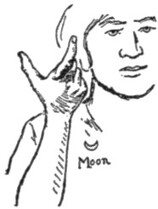
Moon (Horns in the sky, or crescent). Close right
hand except thumb and first finger, which forms a half-circle
or crescent, held above the right ear, back of hand
forward. Sometimes expressed as Night and Sun.
Fr. la lune; Ger. der Mond.
Moose (Elk with flat horns). Hold up flat hands for
horns; but swing both backward and forward to indicate
width; then, with both “L” hands, indicate the
hanging muzzle. (Blackfoot.)
Fr. l’orignal; Ger. das Elentier, der Elch.
More. Hold out the flat left hand, palm up; then with
right make as though throwing sand on it more and
more, three times. (Sheeaka.) Compare Most. See
Repeat, Add to, and Ahead.
Fr. plus; Ger. mehr.
Morning or Day (Opening up). Both hands palms
down, flat, near together. Sweep them up, out, and
apart; turning the palms up. The same as Day.
Morning or Dawn. Hold out both arms level, full
length, side by side, hands flat, backs forward, tips
touching; raise them slowly to half height.
Fr. le matin; Ger. der Morgen.
Mosquito. With right index and thumb make as
though pricking right cheek with a thorn; then slap
the place with right palm.
Fr. le moustique; Ger. der Moskito, die Stechmücke.
Most. Sign More, then raise the right flat hand high
above it. (Sheeaka.) Or sign Ahead, All.
Fr. le plus; Ger. meist, am Meisten.
Mother (Nurse or parent, female). With the finger tips
of the right hand, make as though drawing milk from
the left breast; add the sign for Female if necessary.
(Scott.) Note the left breast for Mother, nearer the
heart; the right breast is for Father.
Fr. la mère; Ger. die Mutter.
Mother-in-law. Sign Brother-in-law, Old, Woman.
Fr. la belle-mère; Ger. die Schwiegermutter.
Motor car. Make signs for Wheels, Horse, Not. Or
sign Fire twice then make as though holding and turning
steering wheel.
Fr. l’automobile; Ger. das Automobil.
Mound or Low Hill. Flat hands together, backs up;
separated and swept down to show shape. Compare
Heap, which is just the reverse; also see Box.
Fr. la petite éminence; Ger. der Erdhügel.
Mount (A horse). Hold right V to right side pointing
up; swing it up to right, over and down, points down,
onto flat left, which is held thumb up. Or, omit left.
(Blackfoot.)
Fr. monter; Ger. steigen.
Mountain. Hold up A hand as in Hill, but higher, and
add Hard. Use both hands alternately up and down
in various places for plural. Compare Hill and Lump.
Fr. la montagne; Ger. der Berg.
Mountain Lion, Cat. Sign Cat, Long tail, and Jump.
(C) Or with both L hands indicate large round tracks;
then, with right G, pointed down, raised and down, each
time, indicate the zigzag trail. (Paiute sign, given me
by C. B. Ruggles.)
Fr. le couguar; Ger. der Kuguar.
Mountain Pass. See Gap.
Mourn. With the flat hands used like knives, backs up,
little fingers as though sharp edges, make as though
to cut off the hair at each side of the head, and add Cry.
Fr. s’affliger; Ger. trauern.
Mouse (Night nibbler). Sign Animal, with very small
jumps, indicate size and Night; then, with right forefinger
and thumb, nibble at left G forefinger.
Fr. la souris; Ger. die Maus.
Move, To move camp (Teepee poles, travois). Both G
hands in front, backs out; lay right forefinger on left
at middle joint, crossing at an angle of 45 degrees, and
push both hands forward in slight jerks, each jerk a
day’s journey.
Fr. changer de place, déménager; Ger. fortziehen, wegrücken.
Mowing machine. Sign Grass and Knife; the last at
right lower than waist. Add Wagon if needed to indicate
horse mower.
Fr. la machine à faucher; Ger. die Mähmaschine.
Much or Many. Hold curved 5 hands, palm to palm,
a foot apart; swing down together and up face high,
closing them; swing a little apart at the finish.
Much (Heap.) Hold the flat hands so the palms are
toward each other, the left lower, and draw them apart,
the left downward, the right upward. The extent to
which they are drawn apart indicates the quantity.
Compare Big, Great, Heap, Increase, and Decrease.
Fr. beaucoup; Ger. viel.
Much, Too. See Excessive.
Mud. See Soft.
Mule. Hold extended hands alongside of ears, palms
to front, fingers pointing upward; by wrist action,
flop the hands to front and rear, representing motion of
mule’s ears.
Fr. le mulet; Ger. das Maultier.
Murder. Sign Kill and Free. Meaning an unjustified
killing.
Fr. le meurtre; Ger. der Mord.
Must. See Have to; also Begin or Push. See Imperative.
Muskrat or Musquash. Sign Beaver and Small.
Muskrat (Tail, swimming and lump). Hold out right
G, back up, nearly level, pointing forward and to left;
shake it, draw it to right; then hold up compressed
right hand, back up, pointing forward, and grasp right
wrist on lower side with left hand. (Blackfoot.)
Fr. le rat musqué du Canada, l’ondatra; Ger. die
Bisamratte.
My, Mine, or My own. Sign Possession; that is, hold
out the A hand, thumb straight up; then swing it in
till it touches the breast; or sometimes lay the spread
flat hand on the breast. (Sheeaka.) See I.
My, Mine, or My own. Touch breast with point of
compressed right, then sign Possession.
Fr. mon; Ger. mein.
Mystery. See Medicine.
N
Name (Of a man). Sign Called. “What is your name?”
would be Question, You, Called.
Name (Of animal). With right forefinger and thumb,
others closed, make an incomplete circle and lay it
palm down against the palm of the flat left hand, held
forward, back to left. Compare Brand and Called.
Scott gives it as illustrated.
Fr. nommer, le nom; Ger. (be) nennen, der Name.
Name, To sign one’s (Thumb print). Press the thumb
tip of the A hand against the palm of the flat left. Compare
Letter.
Fr. signer son nom; Ger. seinen Namen unterschreiben.
Named. See Called.
Narrow. Hold flat hands out, palm to palm, about six
inches apart, fingers level and pointing forward; move
them toward each other until but one inch apart. Compare
Fast, Between, Few, and Road.
Fr. étroit; Ger. eng.
Nation (People all). Hold up both 5 hands, swing
them toward each other and away in a great circle.
(Sheeaka.) Not well established.
Fr. la nation, le peuple; Ger. die Nation, das Volk.
NATIONALITIES:
American. Sign Thirteen, Fires. This was once used
on the Ohio, referring to the Council Fires of the
thirteen original colonies. Then add Country by
patting the ground with both flat hands and swinging
them apart and up.
According to Clark, sometimes called Long Knives.
Draw a long line east and west; then with flat hand,
point up, indicate all south of it. (Blackfoot.)
Fr. l’Américain; Ger. der Amerikaner.
British (Red coat). Touch the coat; then with
fingers brush the cheeks for red.
Fr. les Anglais, les sujets anglais; Ger. die Briten,
das britische Volk.
Canadian (Shaking off the snow). Shake the coat
lapel with right hand. (D) The Blackfeet draw a
long line east and west then with flat hand point to
indicate all north of that line.
Fr. le Canadien; Ger. der Kanadier.
Chinaman. Indicate long tail by signing Rope at
back of head.
Fr. le Chinois; Ger. der Chinese.
Dutchman (Long pipe). Place thumb of Y hand at
the mouth, draw it down and outward to indicate
the long pipe. (D)
Fr. le Hollandais; Ger. der Holländer.
Englishman. Sign White Man, Far. (Blackfoot.)
Fr. l’Anglais; Ger. der Engländer.
Frenchman. Hold out the F hand well toward the
left, palm up; draw it across in front of self from left
to right, turning it palm down. (D) To sign
Hairy Man would translate the nickname “Poilu.”
Fr. le Français; Ger. der Franzose.
German (The double eagle). Cross the wrists of
both 5 hands, thumb palm against thumb palm, and
work the fingers. (D)
Fr. l’Allemand; Ger. der Deutsche.
Great Britain (Red-coat land). Land, Coat, and
Red.
Fr. la Grande-Bretagne; Ger. das Groszbritannien.
Holland. Same as Dutchman.
Indian. See Indian on p. 106.
Irishman. Hold out left S hand, back up; swing
right V around it and end with V resting on back of
left. (D) Green Island Man would be more acceptable.
Fr. l’Irlandais; Ger. der Irländer.
Japanese. Sign Country and Rising Sun. Or sign
Man, Short, Eyes, Oblique. The last by pushing up
the outer corners of the eyes with G fingers. (These
are suggested.)
Fr. le Japonais; Ger. der Japaner.
Jew (Long beard). Placing the fingers of the bent 5
hand on the chin, draw them down and off, letting
the hand assume the flat position as it leaves the chin.
(D)
(As a slang term.) Spread both hands open from
opposite each shoulder, palms forward, and rotate
them slightly on the wrist back and forth. (Pop.)
Fr. le Juif; Ger. der Jude.
Italian. With the little finger of I hand trace a cross
in the centre of the forehead. (D)
Fr. l’Italien; Ger. der Italiener.
Mexican (Bearded White Man). Sign for White
Man and Beard. In this case, Beard is made by
rotating and jerking the 5 hand before the chin,
points up.
Fr. le Mexicain; Ger. der Mexikaner.
Negro. Sign White Man, Black face. (C) Sheeaka
also fumbled the open right over the knuckles of the
half closed left, to indicate kinky hair.
Fr. le nègre; Ger. der Neger.
Ontario (Land of Lakes). Make signs for Country
and Lakes. (Suggested.)
Fr. l’Ontario; Ger. das Ontario.
Russian. Arms akimbo, i.e., C hand on each side of
the waist. (D) The Cheyennes call them Ride
Easy from the Cossack circus performers; but it is not
an established sign. Bear Man is suggested.
Fr. le Russe; Ger. der Russe.
Scotchman (Plaid clothes). Cross the fingers of the
right 5 hand with those of the left 5 hand on the chest,
then let each drop to continue the lines. (D)
Fr. l’Écossais; Ger. der Schotte.
Spaniard. Sign Old, Mexican.
Fr. l’Espagnol; Ger. der Spanier.
White Man (Hat man). With G right hand draw
first finger across the brow. (C) For illustration
see White Man among W’s.
Fr. l’homme blanc; Ger. der Weisze.
Other countries are indicated in the Deaf Code by
making the initial letter in the single-handed alphabet
and swinging them in a circle in front of the forehead;
but this mode contravenes the fundamental
principle of Signs. (See Introduction.)
Therefore, it is better to wait till a true sign is
discovered.
Near or Nearly. Same as Close, which see.
Near by. See By.
Nearest. See Next.
Need or Need to. See Must.
Needle. Make the sign for Sew. (C)
Fr. l’aiguille; Ger. die Nadel.
Neighbor. Sign Close and Dwell, or Sit, Close.
Fr. le voisin; Ger. der Nachbar.
Nephew. Sign Brother’s (or Sister’s) Son. (C)
Fr. le neveu; Ger. der Neffe.
Never (Ever and Not). Right elbow fixed at side and
with right G hand out straight, describe a complete
upright circle, left to right; then throw the hand down
to right in Not. (Sheeaka; probably borrowed from
Deaf.)
Fr. jamais; Ger. niemals.
Never mind. See Rub it out.
New. Sign Little time, Traded. Or, Little while,
Made, Good.
Fr. neuf; Ger. neu.
News. With right G struck down to right and left
(for this and that) and Hear.
Fr. les nouvelles; Ger. die Nachrichten.
Newspaper. Sign Writing and Tell (i.e., Talk) to
right and left.
Fr. le journal; Ger. die Zeitung.
Next. See Neighbor.
Next or Second. Hold out the flat 4 left hand, palm
down; with right G draw the left index toward the right;
then tap the middle finger of left with right index. Or
sign Close.
Fr. prochain; Ger. nächst.
Night (Earth covered up). Bring the flat hands, backs
up, well apart, out in front of body, breast high; move
them together in outline of a dome, finally resting right
wrist on left. Compare Hide.
Fr. la nuit; Ger. die Nacht.
No. Hold flat right hand, back up, in front of body,
fingers pointing level and nearly forward. Swing the
hand in a graceful curve to right and front, at the same
time turning it thumb up, finishing with the back of
hand to right and downward; the hand is swept into its
position on a curve. Usually abbreviated into a short
jerk of the flat hand to right, its palm kept facing left.
Compare Bad and Different.
For short range, shake the head; this is simple and
universal. It is so natural that babies and animals do
it when offered bitter medicine, for example. (Popular
and Indian generally.)
Fr. non; Ger. nein.
No, I won’t listen; or Go away, the matter is ended.
Right G hand upraised to level of face, palm out, index
upright; wave the finger hand from side to side by wrist
action. Chiefly used by Cheyennes when joking. It is
general in Latin countries. Compare White-tailed
Deer.
Fr. non, allez! Ger. Punktum! Schlusz!
None, Nothing, I have no money. Turn the flat palms
forward, one near each trouser pocket. (Pop.)
Fr. il n’y a rien; Ger. nichts.
Noon. See Midday.
Notify. See Tell.
Now (Emphatic “right now”). Hold up right G,
back to right and pointing upward about eight inches in
front of the face; and, without stopping, carry it a little
to front; then stop and give a slight rebound. Sometimes
look up to make it clear that it relates to time of
day, that is, the sun’s course. Often it means this as in
this day; this moment; this night.
Fr. maintenant; Ger. jetzt.
Numbers and Counting. Up to ten as shown on the
fingers at the foot of previous page and this.
For 20—Sign 10, close the hands, then repeat it.
For 25—Sign 20, then drop left, close right, and sign 5.
For 30—Sign 10 three times; or else as below.
For 20, etc., sign 10, then hold out left 5 hand pointing
forward and draw right G along each finger from
base to tip; each finger so pointed stands for 10.
If over 50, do same with right hand and left index
till enough tens are shown.
For 100—Both 5 hands held up, palm forward, thumb
tips touching, low, opposite right shoulder; swing in a
vertical arch to low opposite left shoulder. This mode
of multiplying by ten may be applied to other numbers.
For 1,000—Sign 100 and on flat hands spread and
pointing forward, palm down, with index of other
hand show number of hundreds as above.
Numbers or Counting. Or, with the thumb of the same
hand, touch each of the finger tips in succession. (Popular
and sometimes used by Cheyennes.)
Fr. les nombres, les numéros, compter; Ger. die
Zahlen, zählen.
Numbers ordinal. Point at or indicate the person or
thing; then turn down the first finger for 1st and the
second finger for 2d and so on. Also see First, Next,
and Last.
Numeral Sign, Arithmetic, or Counting. Hold the left
5 hand, palm up, fingers a little bent; with right G
turn one or two left fingers down on left palm.
The Deaf mode is the figure-sign, then, without changing
position of arm or hand, give the hand a twisting
jerk from the wrist, which swings it in a small circle.
Fr. les nombres ordinaux; Ger. die Ordinalzahlen.
Nun. Sign Woman, Black, Hat.
Fr. la religieuse; Ger. die Nonne.
O
Oath or Swear. Tap the chest with the tips of the flat
right hand, then hold it at head height, palm forward.
(Sheeaka.) Sometimes point to Heaven and Earth,
then hold up flat right hand. (C) Neither is Cheyenne,
but both are understood by them. See Promise.
With right G make a small cross over the heart. (Pop.)
Fr. le serment, jurer; Ger. der Eid, schwören.
Obey. Make sign for Listen. For emphasis add Yes.
Disobey is putting the flat hands over the ears.
Fr. obéir; Ger. gehorchen.
Obliged to. See Have to. (C)
Ocean. Sign Water and Very broad. Some add Salt.
Fr. l’océan; Ger. der Ozean.
Of (That from that). Hold right G hand out straight
from right side, palm up; rotate the hand so the index
tip describes a small half-circle inward and finally the
palm is down. (D) Compare Luck.
Fr. de; Ger. von.
Offer or Propose. Hold the flat hands, palms up, near
you, then move forward as though offering something.
(Blackfoot.) The Cheyennes sign Want and Give.
Fr. offrir, proposer; Ger. anbieten, vorschlagen.
Office. Sign Writing House.
Officer. Sign Chief; or, if military, sign Chief, Soldier.
Or indicate with the right index on the left shoulder
or arm the insignia of the particular rank.
Fr. l’officier; Ger. der Beamte, der Offizier.
Offspring. See Child.
Often. See Many times.
Oil (Blowing oil off surface in pot). With both L hands
form a big level circle; then tilt it low on forward side
and blow across it. (Blackfoot, but understood by
Cheyennes.)
Fr. l’huile; Ger. das Öl.
Oil or Grease. Hold out the flat left, thumb up; with
right thumb on palm and right index on back (others
closed); rub back and forth with short, quick jerks.
Compare Thick, Thin, Bacon.
Fr. la graisse; Ger. das Fett.
Old (Walking with a stick). Hold right A hand, back
to right, about twelve inches in front of right shoulder,
about height of breast; move the hand a little upward,
to front, downward and back into its first position on
small curve, repeating motion. Compare Lame.
Fr. vieux; Ger. alt.
Old Man. Hold up the right index finger as in Man,
then drop, crook, and swing it in Old. See Decrepit.
Fr. le vieillard; Ger. der Greis.
Old, How old are you? Sign Question, Snows, You; or
Question, Counting, Colds, You.
Fr. quel âge avez-vous? Ger. wie alt sind Sie?
On or Upon. Lay the flat right hand, palm down, on
back of the flat horizontal left, palm down. Compare
At.
Fr. sur; Ger. auf.
Once. Dip the finger ends of the right compressed hand
down against the palm of the flat left hand, bringing it
away quickly. For Twice, do it twice, etc. (Sheeaka.)
Compare This and Repeat.
Once (One go). Sign One with right G index and push
it forward low down. (So, also, Twice is Two pushed
forward, etc.)
Fr. une fois; Ger. einmal.
One who, or The man that does. See Doer.
Onion. Sign Potato and Bad, Smell.
Fr. l’oignon; Ger. die Zwiebel.
Only. See Alone.
Open. The flat hands together, palm to palm, opened
out flat as a book. The same as Book with Writing
omitted. Compare Day, Book, Shell, and Shut.
Fr. ouvrir, ouvert; Ger. öffnen, offen.
Opossum. Hold out the flat right, fingers doubled on
palm, thumb straight up; move it forward level. The
thumb represents the tail. This is an Australian sign
given by E. C. Stirling. It is offered as a suggestion
and as a reminder that the Sign Language is world-wide.
The Cheyennes sign Tree, Climb, Hang by tail.
Fr. l’opossum, le (la) sarigue; Ger. das Opossum.
Opposite or Against. Hold the G fingers up opposite
each other, pointing at each other. Compare Against.
Fr. opposé, en face; Ger. gegenüber.
Or. See Either. Sometimes use Different.
Orderly or Put in order. See Ready.
Ordinal Numbers. See Numbers Ordinal.
Other. See Another.
Other side. See Beyond.
Otter (Wrapping the hair plait). With right thumb,
index and middle fingers together, others closed, describe
a small spiral from near the right ear down. Because
the otter skin was the kind used in strips to wrap
the plaits of the Indians’ hair.
Fr. la loutre; Ger. der (die) Otter.
Our. Sign All, My.
Fr. notre; Ger. unser.
Out of. See Absent.
Outside or Out of. Make a semicircle of the left arm
out level; drop the compressed right hand without and
beyond the semicircle. Compare In, which it resembles,
except in the last movement.
Fr. dehors, hors de; Ger. drauszen.
Over or Above. See Above.
Overcome. See Kill.
Overtake. Hold out flat left hand at arm’s length, palm
forward, fingers pointing up; hold the right G hand near
the breast, palm out, pointing up; move it forward till
it strikes the left hand. Use the left G if only one is
pursued. Compare Arrive there.
Fr. atteindre; Ger. einholen.
Owe or Debt (Recorded and given). Write on the
left palm and swing it from you to me or otherwise,
according to the case. (Sheeaka.)
Owe. Sign Trade, Time, Money, Give.
Fr. devoir; Ger. schuldig sein.
Owl. Sign Bird and Big-eyes; the latter by putting
around each eye a half-circle of thumb and index.
(For Horned Owl indicate the horns with G hands.)
For Burrowing Owl, sign Owl, Hole, and Dancing.
Fr. la chouette, le hibou; Ger. die Eule.
Own. See Possession.
P
Pack. Hold out left flat hand, back to left (this is the
horse); bring right flat hand and place palm against
left thumb, fingers pointing to front (this is the right
pack); raise the right hand and place palm against upper
part of left (this is the left pack); repeat these motions
quickly.
Fr. emballer; Ger. packen.
Pain. See Ache.
Paint. Use all the fingers of right hand as a brush
painting the left palm. Recent Cheyenne.
Fr. peindre; Ger. anstreichen, malen.
Paint the cheeks. Sign Red, then rub the cheeks and
front of the face with palm of flat right hand moved in
small circles.
Fr. se farder; Ger. schminken.
Palsy. Both flat hands, backs up, near breast, shaking.
Fr. la paralysie agitante; Ger. die Schüttellähmung.
Panther. See Mountain Lion.
Paper (Square to write on). With G fingers outline a
square, then make as though to write on it with right G.
Fr. le papier; Ger. das Papier.
Parallel, or Side by Side. The index fingers of G
hands laid side by side, not touching and not moving.
Some make right index point to left and left to right in
this. Compare Equal, Race, and Marry.
Fr. parallèle; Ger. parallel, gleichlaufend.
Pardon, Liberate, or Turn Loose (Removing a halter).
Hold both L hands, palms up, near the neck, one on
each side; sweep them up, over, forward and down, as
though removing a halter; at the finish the index fingers
are pointing forward and down. Sometimes add Go.
See Excuse and Free.
Fr. pardonner; Ger. begnadigen.
Part. If one-half, indicate it as in the sign for that
word; if less, hold the right hand nearer end of index,
according to portion desired to be represented. See
Half and Some.
Fr. la partie; Ger. der Teil.
Partner. See Mate.
Parturition. See Born.
Pass by. See Avoid.
Past (Time back). Make the sign for Time and jerk
the thumb backward over the right shoulder, all fingers
closed. (Sheeaka.) Or throw the flat hand back over
shoulder. In general, sign Time, Back. See Ago and Back.
Fr. le passé; Ger. die Vergangenheit.
Pasture. See Corral.
Patrol. See Band.
Pawnee. See Indian Tribes.
Pawnshop (House of three balls). House and hold
left hand up with thumb, first and second fingers pointing
straight down; then make a hoop of right thumb and
index and apply it in succession to the three hanging
tips. (Pop. and acceptable to Indians.)
Fr. le Mont-de-Piété; Ger. das Leihhaus, das Pfandhaus.
Pax. See Fins.
Pay (i.e., “Will you give me?” or “Will you pay?”).
Hold the right hand forward at level of waist, palm up,
fingers half closed, rubbing the tip of first finger and tip
of thumb together. (Popular and understood by
Sheeaka.) The Cheyennes sign Money, Give me.
Fr. payer; Ger. bezahlen.
Peace. Clasp the hands in front of body.
Fr. la paix; Ger. der Friede.
Peak. Sign Mountain, Part; then hold up high all
fingers of right hand in a point, back under.
Fr. le pic; Ger. die Spitze.
Peas. Sign Plant, then with right index and thumb as
in Little of tap five or six times in a row along the side
of the left G.
Fr. les pois; Ger. die Erbsen.
Pekan. See Fisher.
Penny. Sign Red, Money.
People. Hold up the 5 hands, points up, and add All.
Compare Nation and Dance.
People. Hold up both G hands at various heights, as in
Man sign. (Sheeaka.)
Fr. le peuple; Ger. die Leute, das Volk.
Pepper (Black sprinkler). Sign Black, then use right O
hand as tho it held a sprinkler. A Blackfoot sign
understood by Cheyennes.
Fr. le poivre; Ger. der Pfeffer.
Perhaps. See If.
Permit. See Free.
Perplexed. See If and Consider.
Petrol. See Spirit.
Period or Full stop. Use Done both No. 1 and No. 2.
Fr. le point; Ger. der Punkt.
Persevere, Persist, or Stick to it. Hold both fists near
breast and firmly push them forward once or twice.
That is, sign Push repeatedly.
Fr. persister; Ger. beharren.
Person or Individual. Sign Man.
Fr. la personne; Ger. die Person.
Photograph. Hold out the nearly flat left hand at arm’s
length, face high, palm to you, fingers level, pointing to
right; from near it, draw back right fist, palm to left
and up, thumb out straight, as though drawing something
to the eye; then near the face change the right
hand to flat, slightly curved, back forward, fingers
pointing to left, and push it forward against palm of left,
as in Print.
Fr. la photographie; Ger. die Photographie.
Picture. Indicate the subject, then hold up both L
hands to outline bottom and two sides of a square. With
imaginary pencil in right draw on this; left remaining
as it was. See Portrait and Photograph.
Fr. le tableau; Ger. das Bild.
Pie. Sign Bread, Round (i.e., with right G, indicate a
horizontal circle of proper size), and Sweet. Then sidewise
slide the flat right exactly over the flat left, both
with palms up. A description, rather than a sign.
Fr. le pâté, la tarte; Ger. die Pastete.
Piece. See Little of.
Pig. See Hog.
Pipe. Hold out right G breast high, back down, with
index curled up, pointing forward; jerk it forward once
or twice.
Fr. le pipe; Ger. die Pfeife.
Pistol. See Gun.
Pity or Mercy on another (Cry or shed tears for you).
Hold G hands, palms downward, index fingers up, in
front of and near heart, few inches apart, equally advance
and same height; move the hands outward and
slightly downward, or toward person. Compare Cry.
Fr. avoir pitié de quelqu’ un; Ger. jemanden bemitleiden.
Pity or Have mercy on me (Cry for me). Hold G hands
well out in front of body, as described above, but with
backs out; bring them toward body, slightly raising
them.
Fr. plaignez-moi, ayez pitié de moi! Ger. haben Sie
Mitleid mit mir!
Place or Put (Verb). Hold out flat left, back up; swing
compressed right over onto it, then open the right a
little. Sometimes omit flat left, or use instead compressed
left hand held points up. Compare Bet.
Fr. mettre; Ger. stellen, legen, setzen.
Place (Noun). With right G pointing down, indicate a
large circle on the ground. (A Pai-ute sign given by
Mallery p. 500, also a popular sign.)
Fr. la place; Ger. der Ort, die Stelle.
Plant or Planting. With right fingers and thumb, open
as though to drop a seed, then closed and moved on to
drop another farther, and another, all in the same row.
Compare Animal and Jump. See Sow.
Fr. planter; Ger. pflanzen.
Play or Recreation. Hold up both slightly curved 5
hands, points up and forward, palm to palm, about
eight inches apart. Swing them from side to side together,
rotating them so the palms are once to front, once
to back on each swing. Compare Dance and Children.
Fr. le jeu; Ger. das Spiel.
Playing or Fooling. Hold out in front of shoulder the
slightly curved 5 hand, palm up; rotate slightly by wrist
action. See Joke and Laugh.
Fr. jouer; Ger. das Spielen.
Plenty (Many, piled up). Push forward with both 5
hands, palms first, three times (i.e., sign Many); then
raise the hands very high, palms forward and down.
(Sheeaka.) Or sign Heap or Full. Compare Many.
Fr. l’abondance; Ger. die Fülle.
Ploughing. Hold both fists forward as though holding
plough, elbows high; and push forward. Also used for
cultivation in general.
Fr. le labourage, labourer; Ger. das Pflügen.
Poison-ivy (Vine, nibbler). Sign Vine; that is, hold
left forearm upright, as in Tree, and with right G finger
trace a climbing Vine about it; then with thumb and
first two fingers of right hand, scratch on edge of flat
left, held out back up.
Fr. le toxicodendron; Ger. der Giftefeu, der Giftsumach.
Polecat. See Skunk.
Policeman or Constable. Place the curved right index
and thumb, little finger out, against left coat lapel.
Compare Medal, Brand, and Name.
Fr. le sergent de ville; Ger. der Schutzmann.
Police-station. Sign Policeman and House.
Fr. le poste de police; Ger. das Polizeibureau.
Ponder. See Consider.
Poor in property (Scraped bare). With right G finger
scrape down the left G finger held up, from tip to base,
several times. Compare Indian Apache, and Shame.
Fr. pauvre; Ger. arm.
Poor in flesh. See Thin.
Porcupine (Prickly hair). Sign Hair; then with tips
of right 5 hand strike or prick the left palm, held facing
the right.
Fr. le porc-épic; Ger. das Stachelschwein.
Portrait. Hold up the flat left hand, back forward, as
though it were a Mirror, then sketch on the same with
an imaginary pencil, add Face and indicate the person.
See Photograph and Picture.
Fr. le portrait; Ger. das Bild(nis).
Positive of adjectives. See Comparative.
Possesses, Possession, Yours, His own, Belonging
to, etc. (Held in the hand.) Hold right A hand, back
to right, in front of the neck, or even the forehead, and a
few inches from it. Swing it forward and down so the
thumb is pointing straight forward.
Fr. posséder; Ger. besitzen.
Potato. Curved 5 right hand held as low as possible,
back down.
Fr. la pomme de terre; Ger. die Kartoffel.
Pour. Hold out the left O hand, back to left, and pour
into it with the right O hand.
Fr. verser; Ger. gieszen.
Powder. Hold out left hand, palm up; just above it,
rub thumb and finger tips of right. Or commonly
omit left hand. Compare Dust.
Fr. la poudre; Ger. das Pulver, der Puder.
Power. See Can.
Prairie, Smooth land, Flat, or Level (Level
wide). Flat hands side by side, palms up; then
slowly wide spread on same plane. In conversation,
usually but one hand is used.
Compare Free and Broad.
Fr. la prairie, la plaine; Ger. die Prärie,
die grosze Ebene.
Prairie-chicken. See Grouse.
Prairie-dog. Sign Mound, Hole; then push right G up
through hole and add Talk.
Fr. la marmotte de la prairie; Ger. der Präriehund.
Praise. See Applause.
Pray. Lay the flat hands palm to palm, point them to
the sky, then draw down toward self; repeat. (Sheeaka.)
Pray. Look up, sign Talk (No. 1.) straight.
Fr. prier; Ger. beten.
Present (Time). Same as Now.
Pretty. See Beautiful.
Pride, Proud, or Vain. Draw the flat hand, palm down,
over face to breast; throw back head, look up and add
Good. (Blackfoot.) This is their sign for Beautiful
with the addition of the head thrown back. Or sign
He, Think, He, Big Chief. See Conceit.
Fr. la fierté, fier; Ger. der Stolz, stolz.
Priest. Sign Robe and Black.
Fr. le prêtre; Ger. der Priester.
Print. Push the back of right flat curved hand slowly
and firmly against the palm of the left curved ditto,
as in Picture, only several times. Compare Quandary,
Approach, Photograph etc.
Prison (House of bars). Sign for House, then hold 4
hands up, side by side for prison bars. Add Man and
Look through.
Prison. Sign Prisoner and House.
Fr. la prison; Ger. das Gefängnis.
Prisoner (Arrested). Clinch the fists and cross the
wrists as though bound, and press down a little.
Fr. le prisonnier; Ger. der Gefangene.
Private. See Secret.
Produce and Product. See Result.
Prominent or Conspicuous (Stands on a hill). Sign
Hill up high, then lay right G against it, pointing up,
palm to self, back of right against left hand. See Famous.
Fr. éminent; Ger. hervorragend.
Promise (Word bound). Place the forefinger of right G
perpendicularly against mouth; bring down fist and,
parallel with it, the other fist, thumbs up; strike both
down together twice. (Sheeaka.) Also see Word of
Honor, or Cross my Heart.
Promise. Sign Talk (i.e., Word), Give.
Promise, Sworn (I swear). Tap the chest with tips of
flat right hand, then raise it, palm forward, and add
Talk. (Sheeaka.) Compare Oath.
Fr. la promesse, promettre; Ger. das Versprechen,
versprechen.
Proof or Prove. See Show.
Propose. See Offer.
Protect. See Defend.
Fr. protéger; Ger. beschützen.
Push. The same as Begin, which see.
Fr. pousser; Ger. schieben.
Put. See Place.
Q
Quality. See Rank.
Quandary, In a fix, Run against, or Up against it. Hold
out the curved left hand nearly at arm’s length, back
forward; push the ditto right from near the breast right
out briskly and hard against the left. Sometimes use
Against. Compare Approach, which is similar, but is
slow, and right does not touch; also, Print, which
pushes and is repeated.
Fr. l’embarras; Ger. die Verlegenheit.
Quarter (But one of four). Hold up the left 4 hand,
back out; then with the right G turn the little finger
down on the palm. Sometimes sign Half, then again
half of the tip portion.
Fr. le quart; Ger. das Viertel.
Quarrel (Two persons springing at each other). Hold
up both G hands and alternately jerk left at right and
right at left.
Fr. la querelle; Ger. der Streit.
Quench. Fire and Wipe out.
Fr. éteindre; Ger. löschen.
Question, Query, Interrogation, I am asking you a
question, I want to know, usually equivalent to “Is
that you?” (Groping or uncertain.) Hold up the
right hand toward the person, palm down and forward,
fingers and thumb open, spread, but a little curved; by
wrist action, swing the hand in small vertical semicircles.
The diagram below the illustration indicates
the finger tips seen from in front. The motion shown
for the little finger is, of course, shared by all. This is a
very important and much-used sign; it appears before
all questions.
If the person is quite distant, hold the hand higher,
more spread, and wave it several times to right and
left.
When very near, merely raise the eyebrows. For
long distance, raise both arms like Y with hands flat
and waved a little. (Crow.) See Consider.
Fr. l’interrogation; Ger. die Frage.
The following are needed in asking questions:
How? Sign Question and Work and Way.
Fr. comment?; Ger. wie?
How many? or How much? Sign Question; next
hold the left hand open, curved, palm up, fingers
spread; then with right G digit, quickly tap each
finger on left in succession, closing it back toward the
left palm, beginning with the little finger.
Fr. combien?; Ger. wie viele?
What? (As in “What are you doing?” “What is it?”)
Sign Question; follow with the same sign much exaggerated;
that is, with the arm action, swing the right
5 hand, palm under, fingers slightly bent and separated
and pointing forward, in an arc of about a foot
from right over to left and back once or twice. The
Cheyennes in general use this, though they denied
it when questioned. But it seems a good logical sign,
the large arc being equivalent to “object.”
Fr. quoi? que?; Ger. was?
When? If seeking a definite answer as to length
of time, make signs for Question, How many? and
then specify time by sign for hours, days, etc. If
asking in general When? sign Question and Time.
When? If asking for an exact date or point hold
up the left G, make a circle around its tip with right
G, which always points at it. On reaching the starting
point, the right G stops, touches the tip of left G.
(Sioux, given by Sheeaka.) This probably represents
the shadow going around the tree. See Time.
Fr. quand?; Ger. wann?
Whence? Strike to left with right G, back up, then
over to right a foot away, then back and again; point
to the person and sign Come. Usually it needs no
Question.
Fr. d’où?; Ger. woher?
Where? or Whither? (What direction?). Sign Question;
then with forefinger sweep the horizon in a succession
of bounds, a slight pause at the bottom of
each, the head following the finger. (Sioux and
Arapahoe.) The actual line of the finger is illustrated
in the lower plan, the hand being gracefully rotated
on the wrist in doing it. Or sign Question and Somewhere.
Where? Sign Question and Look.
Where? (In an abstract sense). Extend the open
hands, palm up, from the sides out low to the front,
and swing them from side to side with a look of inquiry
on the face. (Pop.)
Fr. où?; Ger. wo? wohin?
Which? (When the objects are in sight). Sign
Question and point with right G in three or four directions,
downward or toward the objects in question.
Which? (When the objects are not in sight). Sign
Question; then hold left hand in front of you, with
palm toward you, fingers to right and held apart;
place the end of the right forefinger on that of the left
forefinger and then draw it down across the other
fingers.
Fr. quel, lequel?; Ger. welcher?
Whither? Sign Question and Go, in two or three
directions.
Fr. où?; Ger. wohin?
Who? Sign Question and Man.
Fr. qui?; Ger. wer?
Why? Sign Question, but do it very slowly. (C)
Why? Sign Question and Want.
Fr. pourquoi?; Ger. warum?
Quick. See Fast and Hurry.
Quiet, be, Be not alarmed, Have patience. The palm
of the flat hand held toward the person and gently
depressed once or twice. See Easy.
Fr. soyez tranquille; Ger. beruhigen Sie sich.
Quiet, be. See Silence.
Quit. See Give up; also Finish.
R
Rabbit. Move the M hand straight to the front, back
up and undulating on the wrist, to imitate the rabbit
hopping forward; then make V right hand and turn it to
look back. (Scott.) The Cheyennes omit the second
part of this.
Fr. le lapin; Ger. der Hase.
Raccoon or Coon. Draw the V hand horizontally across
the face and nose. If necessary, also indicate Size and
striped tail.
Fr. le raton; Ger. der Waschbär.
Race. Move the index fingers forward and up, side by
side, as in Equal; but keep them moving a long way
forward and upward. Compare Parallel, Marry.
Fr. la course, le concours; Ger. das Wettrennen, der
Wettlauf.
Rags, In rags. Touch Coat, add Old; then hold left 5
slightly curved, back up and use ditto right as though
to comb out the fingers of left, once or twice.
Fr. les guenilles, en loques; Ger. die Lumpen,
zerlumpt.
Railroad train or Cars. Sign Fire twice upward for
puffs, then add Fast. Compare Motor car.
Fr. le train [de chemin de fer]; Ger. der Eisenbahnzug.
Railroad. Indicate Train as above; then push the
right G finger quickly along the back of the left V hand
and on beyond. (Sheeaka.)
Railroad. Sign Road; then with the two G hands,
backs up, indicate rails as in Parallel.
Railroad. Sign Hard (i.e., metal); then hold out two
G fingers, backs up, six inches apart, and push both
together far forward and a little up.
Fr. le chemin de fer; Ger. die Eisenbahn.
Railroad Station. Make the signs of Railway and
House; adding, if necessary, Alight and Aboard.
Fr. la gare; Ger. der Bahnhof.
Rain (Falling from clouds). Hold A hands, backs up,
opposite forehead, near each other; lower them slightly,
mostly by wrist action; at the same time open and
separate fingers and thumb so they point downward;
repeat.
Fr. la pluie; Ger. der Regen.
Rainbow. Sign Rain then indicate the arch with a slow
sweep of the flat right hand, back up, high above head.
Fr. l’arc-en-ciel; Ger. der Regenbogen.
Rank or Quality (Of a soldier.) With the right G, indicate
stripes on left arm, or else touch each shoulder for
epaulets.
Rank or Quality. Sign Chief; then lay upright right
G, palm forward, against back of left ditto, as in Rising
man, sliding the right up and down to various heights.
Fr. le rang; Ger. der Rang, die Würde.
Rank, What is his? Sign Chief, Big; Chief, Little;
Question. Sometimes omit Chief, Little.
Fr. quel rang-a-t-il?; Ger. Welchen Rang bekleidet er?
Rapid. See Fast.
Rapids. Sign River, Rock; and pass the right 5 hand,
back up, points first, swiftly forward and down, in an
up and down waved course.
Fr. le rapide; Ger. die Stromschnelle.
Rash (Going forward blind). Hold left hand on eyes
and point right G index forward, moving it to front.
Fr. imprudent; Ger. unvorsichtig, verwegen.
Rattlesnake. Sign Snake, then hold right G finger,
pointing up, near shoulder, and shake it.
Fr. le serpent à sonnettes; Ger. die Klapperschlange.
Reach. Arrive there.
Ready, Orderly, or Arranged. Extend the open hands,
palm to palm, a few inches apart, pointing outward and
parallel to each other, over toward the left side; lift
them both together from the wrists, move toward the
right a little and let them come down again; repeat the
motion until by stages the hands have been moved
over to the right side. (D)
Ready. Sign All, Good; or use Arranged, or combine
them into Arranged, All, Good. See Arranged.
Fr. prêt; Ger. bereit, fertig.
Recall to memory. See Bring back.
Receive. Hold out hollow right hand, palm up, half
open; draw it back, slightly closing fingers. Compare
Give to me.
Fr. recevoir; Ger. erhalten.
Recover, Get well, Get all right again, Revive, or Save.
Hold right G hand, back up, in front of breast, pointing
to left and front; raise the hand with a graceful sweep,
at same time turn it back to front and index pointing
upward. The actual course of the index tip, if seen
from above, is as in the dotted line under the hand.
If one is near death by disease, this may be used to
denote recovery; if in great danger, this would mean
escaped.
Fr. se porter mieux, se rétablir; Ger. sich erholen.
Recreation. See Play.
Reduce. See Decrease.
Reflect. See Idea and Consider.
Refuse. See Won’t.
Religion. Sign Medicine and Way.
Fr. la religion; Ger. die Religion.
Remain. See Sit.
Remember. Sign Heart, Know. Or, in popular code,
touch the forehead with right G, raise the brows and
nod.
Remember, I; or Understand. Hold right G index upright
and grasp it firmly with left hand, face high.
Fr. je me souviens; Ger. ich erinnere mich.
Remember not (It slips from my grasp). As above, but
let the right G index slip down and out. See Forget.
Fr. je ne me souviens pas; Ger. ich erinnere mich nicht.
Remembering. See Memories.
Repeat, Again, or Back. Place the finger tips of the
compressed right hand on the left palm, as the latter
is held in front of the body, back down, and strike
once or twice. (Sheeaka. Probably borrowed from
Deaf.) Compare Once, Twice, Often, and More.
Repeat. Hold up right G, chin high, back up, pointing
to left and forward; lash down with it like a whip twice
or more as best fits in. Sometimes sign Come back.
Compare All the time.
Fr. répéter; Ger. wiederholen.
Reply. See Answer.
Request. See Beg.
Resemble. See Alike.
Respond. See Answer.
Responsible. Sign I (or whoever it is), Do, That
Or My (or His) Way. (Seger.) Sign Carry and That
(Suggested.)
Fr. responsable; Ger. verantwortlich.
Restaurant or Hotel. Sign for House and Eat.
Fr. le restaurant, l’hôtel; Ger. das Restaurant, das
Hotel.
Restrain or Prevent. Sign Hold and Keep quiet.
Sometimes use Do not.
Fr. réprimer, empêcher; Ger. zurückhalten, verhindern.
Result. Sign After, Work, See.
Fr. le résultat; Ger. das Ergebnis, die Folge.
Retreat (Of many). Sign Charge, then reverse and withdraw
the hands.
Retreat (Of one). Sign Going, then turn the G hand
palm toward you and draw it back with similar action.
(Understood; not established.)
Fr. la retraite; Ger. der Rückzug.
Reverie. Bow the head, resting the mouth on the A
fist. Compare Memories.
Fr. la rêverie; Ger. die Träumerei.
Revile. See Blackguarding.
Revive. See Recover.
Revolver. Sign for drawing from belt behind and
present the same, using right G hand, back to right.
Add Fire-off, if need be. See Gun.
Fr. le pistolet, le revolver; Ger. der Revolver.
Rich. Sign Possesses, Heap, Money.
Fr. riche; Ger. reich.
Ride (To ride an animal). Hold the hands as in Horse,
and then move the hands to the front on short vertical
curves.
Fr. aller à cheval; Ger. reiten.
Ridge (Of hills). Hold the A hands touching, thumbs
toward face and upright; draw them apart a foot.
Compare Soldiers and Hill.
Ridge. Sign Hill with right, then hold 5 out at arm’s
length, face high, flat, and bent, so the fingers point to
the left; swing it slowly horizontally across to the right.
This last seems to mean “lying across the horizon”
and appears in several combinations. See Mirage.
Fr. la crête; Ger. der Kamm.
Rifle. See Gun.
Right. See Good.
Rill. See Creek.
Ring (For finger). Hold up left 5 hand; then with
right index and thumb make as though slipping a ring
on the ring finger.
Fr. la bague; Ger. der Ring.
Rising man, or Coming man (Man rising to stand on a
hill). Hold up left as in Hill; lay right G behind or
beside it, against the thumb, palm forward, pointing up;
push right up until the base of the index is sitting on
top of the left; that is, becomes Prominent. See Prominent
and Famous.
Fr. l’homme qui arrivera; Ger. der Mann der Zukunft.
River, Big stream, or Running water. Sign Water
then with tremulous movement draw flat right 4 hand,
palm down, from opposite left breast to opposite right;
fingers always level and pointing to left. Compare
Creek and Rill.
Fr. la rivière; Ger. der Flusz.
Road (i.e., Highroad; especially between high banks,
hills, or fences). Holding the open hands, palm to palm
and pointing forward, carry them forward, as if they
represented the sides of a road; then add Going by pushing
the flat right hand forward in line between, palm to
left, fingers level. (Sheeaka.) Or sign Way and
Wagon.
Fr. le chemin, la route; Ger. der Weg, die Landstrasse.
Robe. Sign Coat; but instead of ending at waist, sweep
the hands as low as possible.
Fr. la robe; Ger. das Kleid, die Robe.
Rock or Stone. Sign Hard and sometimes indicate
shape. For Stone add Lump. Compare Metal.
Fr. la roche, la pierre; Ger. der Fels, der Stein.
Root. First sign Tree or Grass, as may be; then point
down, place the 5 hands together at the wrists, backs
up and level; pointing left to front and left, right to
front and right; then move them out and apart.
Fr. la racine; Ger. die Wurzel.
Rope (Trailing after the horse and twisted). Sign
After; then, as right is drawn to rear, make tip of index
describe a spiral curve. Commonly omit the left hand.
Fr. la corde; Ger. das Seil, der Strick.
Rose (Flower). Hold the fingers of the left hand
straight, little separated, arranged in a circle, back to
left and front; in front of body, index finger horizontal
and pointing to right and front; with right hand make as
though picking berries from the left finger tips. (C)
Fr. la rose; Ger. die Rose.
Rotten (Meat). Indicate smell, etc.
Fr. pourri; Ger. faul, verfault.
Rub it out, Erase, Annul, Never mind, As you were.
Put middle finger of right hand to tongue, then rub
left palm and wipe the palm with under side of right
forearm. (Sheeaka. A white man’s sign now understood
by Indians.)
Or, if afar, simply shake the flat right hand quickly
and vigorously from side to side as it is held palm forward
in front of the face. (Pop.) Compare Easy and
Erase.
Fr. effacer; Ger. auswischen, “Schwamm drüber!”
Rumor (A little flying thing). With flat 5 right hand,
palm down, shoulder high, swing out level from throat
to right, working all the fingers as in playing piano.
(A Paiute sign, given me by Mary Austin.) A combination
of Wind and Fly.
Fr. la rumeur; Ger. das Gerücht.
Run. Swing the fists at each side as in running.
Fr. courir; Ger. laufen.
Run against. See Quandary.
Run away, Slip away, Clear out, Sneak (Run under
cover). Hold out flat left hand, palm down; push
right G hand under it quickly and sinuously. Sometimes
preface it by laying one hand over the eyes. Compare
Jealous.
Fr. filer, se sauver; Ger. ausreiszen, weglaufen.
Running Water. See River.
S
Sacred. See Medicine.
Sad. See Sorrow.
Saddle. Hold out both S hands, palms up, side by
side (sometimes inches apart), about height of shoulders,
forearms vertical, wrists bent so backs of hands are
nearly down.
Fr. la selle; Ger. der Sattel.
Safe. See Recover or Alive.
Sage Brush (Bunches). With all finger tips together
pointing up, swing the hand to various places in front
of right shoulder. (C) Compare Peak and Canoe.
Sage. Sign White, Good smell, Grass.
Fr. la plante aromatique de la prairie; Ger. der
Präriebusch.
Salt. Sign Powder, then the act of sprinkling with
finger and thumb. (Blackfoot.) Touch the tongue
cautiously with the right G. Compare Sugar and
Pepper.
Fr. le sel; Ger. das Salz.
Same. See Equal.
Sanctuary, to claim. See Bar up.
Satisfied. See Contented.
Save. See Recover, also Free.
Save or Except. See But.
Savey or Sabe. This word universal in the west is the
same sign as Know.
Saw. With lower edge of right, thumb up, saw across
the upper edge of left wrist held out horizontally.
Fr. la scie; Ger. die Säge.
Say. See Call.
Scalp (To). Point to scalp, make as though pulling it
forward and sign Cutting under. The last two gestures
being done out in front of the body.
Fr. scalper; Ger. die Kopfhaut abziehen.
Scatter! (A command to scouts). See Go and Scatter.
Scatter or Sow (As seeds). Hold the closed hands,
backs up, near each other and close to breast; move
right hand well to front and right, left well to front and
left; that is, widely separate the hands, swinging each in
a half-circle out, so the palms are a little outward, at the
same time extending and separating fingers and thumbs.
(C) Compare Bad and Scorn; in these the hands
are not moved apart.
Scatter. Swing closed right to left, there opening to 5
so palm is to left and forward; then same movement
with hand opened to right, each time in a graceful
sweep. The Cheyennes say the above is Throw away.
Fr. disperser, semer; Ger. ausstreuen, säen.
Schoolhouse. Sign House and Writing; usually preceded
by Children.
Fr. l’école; Ger. die Schule.
Schoolteacher. Sign Book and Chief.
Fr. le maître d’ école; Ger. der Lehrer.
Scold. See Abuse; also Fault-finding.
Scorn. Turn the head away and with one hand throw
an imaginary handful of sand toward the feet of the
person. This is the same as Bad, except for the turn
of the head.
Fr. le mépris; Ger. die Verachtung.
Scout. Same as Wolf, but hold the hand near the right
ear. Sometimes use Advance Guard, which see. The
Cheyennes sometimes sign it as Wolf, Soldier.
Fr. le coureur (d’ armée); Ger. der Späher.
Scout, to. Sign Wolf and Look.
Fr. aller à la découverte; Ger. spähen.
Scout; that is, Boy Scout. Hold up the right hand with
finger and thumb forming a ring, other three fingers
straight up. (Pop.)
Fr. le petit éclaireur; Ger. der jugendliche Pfadfinder.
Scout; of the highest degree. Add the sign Wolf to the
foregoing. (Suggested.)
Scout leader or Patrol leader. Sign Boy Scout; then
lay the 4 left hand on left side of head to indicate plume.
(Suggested.)
Scout, Tenderfoot. Make signs Boy Scout and Small.
(Suggested.)
Sculptor. Right fist closed, thumb held up straight
and free, then used as a trowel on an imaginary wall.
(Pop.)
Fr. le sculpteur; Ger. der Bildhauer.
Search me. With a hand grasping each lapel, spread
open the coat. (Pop.)
Fr. examinez-moi; Ger. was weisz ich? (Pop.)
Seasons. The four seasons are Little Grass (Spring);
High Grass (Summer); Leaf Fall (Autumn); and
Cold or Snow (Winter). Each is given in alphabetic
place.
Secret or Private (Talk under cover). Left hand flat,
horizontal, near left cheek; with right, sign Talk under
it. Usually sign Talk and Hide.
Fr. le secret; Ger. das Geheimnis.
Seek. See Hunt.
See. The fingers of V hand pointed forward (as in
Look) then advanced a little in the line of sight; sometimes
for extra point, it is changed into G hand and
pushed forward. Also compare Hunt and Lie, Look
and Find. The difference between Look and See is not
observed by most Indians; but it is well to maintain it.
Fr. voir; Ger. sehen.
See me. Point at one’s own chin with the right V
hand and touch breast.
Fr. voyez-moi; Ger. sehen Sie mich.
Seem. See Appear.
Seize. Move the open hands forward; grasp and draw
back as though seizing some object.
Fr. saisir; Ger. ergreifen.
Select. See Choose.
Sell. See Trade. On the Stock Exchange, the clenched
fist thrown forward and down means Sell. Probably
in imitation of the auctioneer’s hammer. See Kill.
Sell, Sold or Bought i.e., Marketed. On middle of side
of left G held out, tap two or three times with middle
side of right G. This is also used for Buy, which see for
illustration. It is supposed to have had origin in an old
gambling game. See Trade.
Fr. vendre; Ger. verkaufen.
Send (Command and Go). Hold the right A near the
breast; swing it out, up and down a foot; then swing the
right G higher and farther. (Sheeaka.)
Fr. envoyer; Ger. senden, schicken.
Separate or Apart. Lay the G fingers side by side,
backs up; spring them apart, widest at tips, moving
them forward and out.
Fr. séparer; Ger. trennen.
Several. Extend the fingers of the right A hand, one
at a time, beginning with the index. (Sheeaka.)
Fr. plusieurs; Ger. mehrere.
Sew. Hold flat left hand index edge up, thumb level
with index; move right G hand index with extended
thumb, across left index once or twice as in sewing;
each time nearer the body and each time turning the
right index nail down, as it is moved forward. Compare
Awl.
Fr. coudre; Ger. nähen.
Shade. Sign Sun, Not.
Shadow (Of a person). Indicate the person; then sign
Going, There by me, Same. There by me is indicated by
pointing to the ground on the left side with right G.
Fr. l’ombre; Ger. der Schatten.
Shall. See Will.
Shaman. See Medicine-man.
Shame (On you). (The finger of scorn made sharper.)
Point left index at person, all others closed; and with
right index similarly held, rub it on back of left index
from middle to tip and beyond. (Pop.) See Ashamed.
In France the idea is conveyed by the Horns. See
Evil Eye.
Fr. fi! fi donc! (Pop.); Ger. Schäme dich!
Sharp or Keen. Hold out flat right hand, palm up;
touch little finger edge lightly with ball of left thumb
and add Good. For Sharp points see Porcupine.
Fr. affílé; Ger. scharf.
Shave. Use the flat right hand as a razor, palm to
right, points up, little finger next right cheek as the
edge; move it toward the right ear.
Fr. (se) raser; Ger. (sich) rasieren.
Shawl. Sign Blanket and Fringe. For Fringe, hold
out the left 5 hand points forward, level; then push the
similar right over it forward several times.
Fr. le châle; Ger. der Schal.
She. Sign Female and point with G finger at the person.
Fr. elle; Ger. sie.
Sheep, Mountain, or Bighorn. With compressed hands
above each eye, pointed backward, trace the sweep of
horns, ending below ears, with points turned forward.
Fr. le mouton sauvage; Ger. das amerikanische
Groszhornschaf.
Sheep, Common. Sign Bighorn and White Man.
Fr. le mouton; Ger. das Schaf.
Shell. Hold the curved hands side by side, close and
open them on the under side, as though hinged on top.
Compare Boat, Book, Bowl, and Open.
Fr. la coquille; Ger. die Muschelschale.
Shield (Noun). With both L hands a little apart, index
fingers pointed down, make a large incomplete circle
to left of left breast. See Protect.
Fr. le bouclier; Ger. der Schild.
Shine, Shimmer, or Glitter. Hold out the curved right
5 hand, palm down; lower it slightly, shaking it quickly
sidewise. Compare Snow, Glitter, and Easy.
Fr. briller, étinceler; Ger. scheinen, glänzen.
Ship. Raise and spread thumb and two first fingers
to be masts, others closed; then push the hand forward
slowly in a rising and falling line. (Deaf sign for Sailing
Ship. For Indian sign see Boat, Big.)
Fr. le navire; Ger. das Schiff.
Shoe. Sign Moccasin, White Man.
Fr. le soulier; Ger. der Schuh.
Shoot (A gun). See Fire.
Shoot (An arrow). Sign Bow, then snap the index
fingers out straight. To add Hit with an arrow, hold
up the flat left and thrust the right G through it.
Fr. lancer (une flèche); Ger. schieszen.
Shop. See Store.
Short. For things which grow, hold the flat hand back
forward, fingers pointing up at desired height. For
things which do not grow, use the flat hand, palm down;
or else, both flat hands side by side, palm to palm. The
same as Low.
Fr. court; Ger. kurz.
Shot-gun. See Gun.
Shout. See Yell.
Show, Prove, Proof, or Behold. Raise flat left hand,
palm forward. Lay index of right G on it and turn the
two about, pushing them forward as though to show
something. (Sheeaka. Borrowed from the Deaf.)
Show, Prove, Proof, or Behold. Hold out the flat left,
palm up, pointing forward and down. Point to the
person in question with right G, then at left palm with
right V.
Fr. montrer; Ger. zeigen.
Sick, Suffering, Sick one, or Invalid (Throbbing).
Hold flat hands out near breast; move the hands quickly
outward and back several times. Compare Lungs.
Fr. malade; Ger. krank.
Side by Side. See Parallel.
Sign Language, To talk in Sign Language. Touch the
back of left hand with tip of right, the back of right
with tip of left and add Talk. (C)
Fr. le langage des signes; Ger. die Gebärdensprache.
Silence, Silent, or Hush. Lay the extended index,
pointing upward, over the mouth. In the more vigorous
form of Shut up, lay the flat hand on the mouth
(recent).
Fr. silence! taisez-vous!; Ger. schweigen! still!
Silly. See Foolish.
Silver. Sign Money and White.
Fr. l’argent; Ger. das Silbergeld.
Sin or Badness. Same as Bad. See Evil.
Since. See After.
Sing. Hold right V hand, back to right, in front of
face; finger tips a little higher than and close to mouth,
pointing nearly up. Move the hand briskly so finger
tips describe a small horizontal circle. Compare Lie
and Abuse.
Fr. chanter; Ger. singen.
Sioux. See Indian.
Sister. Sign Woman and Brother.
Fr. la soeur; Ger. die Schwester.
Sister-in-law. Sign Brother-in-law and Woman.
Fr. la belle-soeur; Ger. die Schwägerin.
Sit, Sit down, or Remain. Hold the right A hand in
front of and a little lower than right shoulder, back to
right; move the hand emphatically downward a few
inches. Compare Wait and Aboard.
Fr. s’asseoir; Ger. sitzen.
Skin. See Hide.
Skinny. See Lean.
Skunk or Polecat. Indicate Size and tail up; that is,
curving G up, palm forward; move in gentle jerks forward,
and then add Smell, Bad. Compare Weasel.
Fr. la bête puante, la mouffette; Ger. das amerikanische
Stinktier.
Sky. See Heavens.
Sled or Sleigh (The runners). Both G hands, backs
down, 4 inches apart; index fingers curved and pushed
forward. The idea is helped by Snow on Ground.
Fr. le traineau; Ger. der Schlitten.
Sleep. Hold both flat hands, backs up, in front of
breast, same level; swing both over to the left in an up
and down curve, in which the right (only) turns palm
up; the left continues back up; then lower the head a
little to right. Some finish with both palms up.
Journeys are one sleep, two sleeps, etc., on the Plains.
Fr. le sommeil, dormir; Ger. der Schlaf, schlafen.
Sleepy. Rub the eyes with the fists. (Pop.) Or
yawn and lay the head on one side, closing the eyes.
(Sheeaka.) Both of these are understood by the Cheyennes,
but they use Want, Sleep.
Fr. avoir sommeil; Ger. schläfrig.
Slow. Hold out the flat left hand, palm to right; ditto
right hand opposite, palm to left; in slow jerks, move the
left hand forward; at the same time, jerk the right,
making the latter fall behind. Compare Fast.
Fr. lent; Ger. langsam.
Small, Few, or Crowded. Compress both hands so the
fingers are straight, but at an angle with the back of the
hand; hold them about eight inches apart, backs out,
pointed up and forward, right higher; move them together
till the right is over the left. Sometimes the
Cheyennes made this sign with the closed fists to mean
Few. Compare Little.
Fr. peu; Ger. wenig.
Smaller, to make. See Decrease.
Smart. See Cunning.
Smell. Hold V hand, back up, fingers pointing to chin;
swing fingers up so the nose passes between them. Compare
Blood and Brother. Place the palm close before the
tip of the nose. (Pop.)
Fr. sentir; Ger. riechen.
Smell, A bad smell, or Stink. Sign Smell and hold the
nostrils, or sign Bad. (Sheeaka.)
Fr. la mauvaise odeur, la puanteur; Ger. der üble
Geruch, der Gestank.
Smell, A good smell. Sign Smell and Good.
Fr. la bonne odeur; Ger. der gute Geruch, der Duft.
Smoke. For distant smoke, like a signal-fire smoke,
make sign for Fire and continue raising hand in a spiral
till higher than head.
Fr. la fumée; Ger. der Rauch.
Smoke a pipe (Action of filling it). Hold up the left
A, thumb up, tap on top two or three times with flat right,
then add Pipe, jerking it forward two or three times.
Fr. fumer (une pipe); Ger. rauchen (eine Pfeife).
Smoke a cigarette. Put index and thumb to mouth as
though holding a cigarette. (Blackfoot.)
Smooth or Level. Rub the back of the flat left hand,
held palm down, with whole palm of the flat right, back
and forth, in long strokes. Sometimes use Prairie.
Compare Indian and At.
Fr. lisse; Ger. glatt.
Smooth Ground. See Prairie.
Snake (Its motion). Hold the right H (or sometimes
G) hand, back to right, waist high, fingers pointing to
front; move it several inches to front in a sinuous line
from side to side. Compare Fish, Creek, and Rope.
Fr. le serpent; Ger. die Schlange.
Sneak. See Run away.
Snow. Raise and spread both hands a foot apart,
backs up, fingers curved; then softly lower them in slow,
short zigzags. For Rain, the lines down are straight.
Years are commonly called Snows or Winters. Compare
Shimmer.
Fr. la neige; Ger. der Schnee.
So, Just so (That’s true). Swing the right G index from
45 degree angle down to level; then add Straight, swinging
index up slightly at finish. Sometimes sign Yes.
Compare Idea.
Fr. si, précisément cela; Ger. so, jawohl.
So that; In order that (So, that). Strike down a foot
with the right G in front of breast, then strike it on the
left flat hand held opposite left breast. (Sheeaka.)
Fr. de sorte que, pour; Ger. um, damit.
Soap. Rub the hands together as in washing them.
Fr. le savon; Ger. die Seife.
Soft or Muddy Ground (Animal’s legs going down).
Form a horizontal half-circle of left index and thumb;
drop the right fist into it; reverse the hands and repeat.
Fr. la terre molle, la boue; Ger. die weiche Erde, der
Schlamm.
Soft, in general. Sign Hard and Not.
Fr. mou; Ger. weich.
Soil. See Earth.
Soldiers (In a row, spread out). Hold the flattened
fists out in front, side by side, backs up so basal joints
of the fingers are nearly level and the middle joints
form a row; then swing them apart.
In many whose fingers are stiff the row is made with
the basal joints plumb, as in the upper cut; but the
correct way is as below.
“This represents the line of the Indian soldiers that,
pending the order to charge, held back the people in the
buffalo hunt.” (Scott.) Compare Ridge, Done, and Fat.
Fr. les soldats; Ger. die Soldaten.
Some (Here and there one). Point with index finger
downward and at some near spot on the ground, then
change to another farther off, then to another. (Scott.)
Fr. quelques; Ger. einige.
Some, A part of. Hold out level flat left, back forward
and out; lay flat right thumb up on left index near the
tip; then jerk it toward tip and beyond. This is much
like Halve; but the right is casually brushed along the
edge of the left and at no time precisely placed.
Fr. du; Ger. etwas.
Sometimes (Different times). Sign Time, moving the
hands apart in short jerks. (Seger.) Compare By
and by.
Fr. quelquefois; Ger. zuweilen.
Somewhere. Hold right G up near right shoulder;
swing it in a curve up and down to opposite left shoulder
and back. Also used in the question Where?
Fr. quelque part; Ger. irgendwo(hin).
Son. Sign Born and Male.
Fr. le fils; Ger. der Sohn.
Song or Poem (Written singing). Sign for Sing and
Write.
Fr. la chanson; Ger. das Lied.
Soon or Early. Sign Time, then stop with the fingers
an inch apart. Compare Sometimes, Time, By and by,
Close.
Sorrow, Distress, Discouraged, Down-hearted, Sadness,
or Sad (Heart on the ground). Lay the right
compressed hand on the heart, pointing down; then
throw it forward and down, ending the sign with the
flat hand very low, palm up, near the ground.
Fr. le chagrin, la douleur; Ger. das Leid.
Sorry (It grinds my heart). Rub the fist on heart in
circle two or three times. (Blackfoot.)
This is less strong than Sorrow and is used as a polite
expression of interest, equivalent to “What a pity.”
(Eastman.) See also Trouble.
Fr. j’en suis fâché; Ger. leid tun, es thut mir leid.
Soul. See Spirit.
Sour. See Bitter.
Sow. See Sew.
Sow Seeds. See Scatter.
Spark. See Fire.
Speak. See Talk.
Spear. Make as though thrusting a spear with both
hands.
Fr. la lance; Ger. der Speer.
Speech, Message, or Talk. That is, a long talk, as at
council, by oneself. (Handing out words.) Hold the
flat right hand, back down, pointing to left, at lower
lip and swing it forward several times. Compare Discussion
and Talk.
Fr. la harangue; Ger. die Rede.
Speech to me or Tell me. Speech by another addressed
to oneself is the same as the preceding, but swing the
right hand in toward the chin instead of out. Compare
Drink, Water, Discussion, and Talk.
Spell, that is, Spell it. Make writing in the air, then
sign Talk.
Fr. écrivez le; Ger. buchstabieren Sie es.
Spider. Hold the palm of the right hand about one and a
half inches from a flat surface; spread the fingers and
thumb and work them like legs; the hand represents the
body. (Scott.) Compare Bunch and Herd.
Fr. l’araignée; Ger. die Spinne.
Spirit or Petrole (Water of strong power). There is no
established sign; but Sheeaka understood this combination:
Water and Strong. A Cheyenne gave it Lantern,
Different, Strong, Pour.
Fr. l’essence, le pétrole; Ger. das Benzin.
Splendor. See Glow.
Spoon. Use the cupped right hand as a spoon.
Fr. la cuiller; Ger. der Löffel.
Spotted. Hold out the level left arm and with right
curved 5 hand finger tips tap the left arm at various
places on the inside, from the wrist up, as though flecking
it with the tip of a brush, at both up and down
strokes. Compare Striped.
Fr. tacheté; Ger. getupfelt.
Spring (Water coming up and spreading). Make the
sign for Water, then a large horizontal circle with L
hands (as in Hole); then push the right compressed
hand up through the left L hand and, as it comes up,
extend the fingers with a slight snap to represent the
bubbling water.
Fr. la source; Ger. die Quelle.
Spring (Little grass time). Sign Grass and Short. Add
Time if there is doubt.
Show longer grass for June, etc.
Fr. le printemps; Ger. der Frühling.
Squeeze. See Few.
Squirrel. Hold both compressed hands near the
mouth and give a quick motion of the lips. (Ruggles.)
Or sign Tree with left hand, then with compressed right
hand as in Animal indicate running up and around.
Fr. l’écureuil; Ger. das Eichhörnchen.
Squirrel, Flying. Sign Squirrel, Fly; and then with
right hand flat, palm down, simulate flight down and
up in a long sweep. This is merely a description, not
an established sign.
Fr. l’écureuil volant; Ger. das Flughörnchen.
Stand (As a man). Make right V hand stand on left
palm, the fingers representing legs. For an animal,
use all four fingers of right. See Alight.
Fr. se tenir debout; Ger. stehen.
Stand up (As a tree or pole). Hold G hand, back forward,
erect over shoulder. Compare Tall and Up.
Fr. être debout; Ger. aufrecht stehen.
Star. Make the sign for Night, then cross the right G
with left G near the tips and hold up high. Some flirt
the index tip from behind the curved thumb in different
directions up high, to mean twinkling. This is nearly
like Talk up high.
Fr. l’étoile; Ger. der Stern.
Stay. Sign Stop, Wait, and Sit down.
Fr. rester; Ger. bleiben.
Steal (To seize under cover). Hold out flat left hand
pointing out, back up; reach right G hand under
wrist, then draw it back with a sweep, curving it into a
hook at the same time.
Fr. voler; Ger. stehlen.
Steamboat. Sign Boat, Big, Fire, holding the hand
above the forehead for the last.
Fr. le bateau à vapeur; Ger. das Dampfboot.
Stingy. See Mean.
Stink. Sign Bad Smell.
Stir. Hold left as in C, back out, and make as though
stirring its contents with a ladle held in right. Compare
Tea.
Fr. remuer; Ger. rühren.
Stone. Sign Rock and Lump.
Stop. See Halt.
Stop or Full Stop. See Period.
Store or Shop. Sign House and Trade.
Fr. le magasin, la boutique; Ger. der Laden.
Storm. Sign Strong then Wind, shaking the fingers
when opened and sometimes adding the sound of blowing.
Fr. l’orage, la tempéte; Ger. der Sturm.
Story. See History.
Straight. See Honest; also True.
Stranger. Sign, My, People, Not. Or Man, Different.
Fr. l’étranger; Ger. der Fremde.
Stream. See River.
Strike. Hold out flat left, palm up; strike it with the
edge of flat right hand. Compare Chop and Kill.
Fr. frapper; Ger. schlagen.
Strike, To make a. See Count Coup.
Striped. Hold out flat left with forearm level and draw
the right flat palm across it at different points on the
upper side. Compare Spotted.
Fr. rayé; Ger. gestreift.
Strong. With left fist, back out, grasp an imaginary
stick; then also grasp it four inches higher with right
fist, back in. Give a strong outward twist to the right,
finishing with the right fist below the left and back
downward. The left is not moved. This means
physically strong in most cases, and few Indians distinguish
this from Very much; which see. Compare Little.
Fr. fort; Ger. stark.
Subtract or Take from. Holding out the flat left, palm
toward you, with all the right fingers and thumb make
as though seizing something on the left palm; draw the
right to you and down. (Sheeaka. Borrowed from the
Deaf.) Compare Place.
Fr. soustraire; Ger. abziehen.
Succeed. Sign Push, Work, and Finish. Compare
Fail.
Fr. réussir; Ger. Erfolg haben.
Suffering. See Sick.
Sugar or Sweet. Rub the tongue with tips of extended
index and second finger of right hand, then add Good.
Compare Salt and Bitter.
Fr. le sucre; Ger. der Zucker.
Sullen or Sulky. Sign Heart, Angry, Hide. (Blackfoot.)
See Gloomy.
Summer (Time of high grass). Sign High, Grass.
Or sometimes sign Hot only.
Fr. l’été; Ger. der Sommer.
Sun. Form a circle with index and thumb of right
hand; hold hand toward east and swing it in a great
up-curve toward the west. In conversation, the circle
is often incomplete.
Fr. le soleil; Ger. die Sonne.
Sunday. Sign Day and Medicine.
Fr. le dimanche; Ger. der Sonntag.
Monday is Day after Medicine Day.
Fr. le lundi; Ger. der Montag.
Tuesday is Two Days after Medicine Day.
Fr. le mardi; Ger. der Dienstag.
Wednesday is Three Days after Medicine Day.
Fr. le mercredi; Ger. der Mittwoch.
Thursday is Four Days after Medicine Day.
Fr. le jeudi; Ger. der Donnerstag.
Friday is Two Days before Medicine Day.
Fr. le vendredi; Ger. der Freitag.
Saturday is Little Medicine Day.
Fr. le samedi Ger. der Sonnabend.
Sunrise. Make a ring of the right index and thumb,
others closed, level, at full length toward the east; then
raise it, chiefly by wrist action, so the ring is nearly at
an angle of 45 degrees.
Fr. le lever du soleil; Ger. der Sonnenaufgang.
Sunset. The reverse of Sunrise; that is, hold the ring
to the west and swing it down from 45 degrees to level
or lower.
Fr. le coucher du soleil; Ger. der Sonnenuntergang.
Superior or Higher (One above another). Hold both
G fingers side by side, upright, one of them higher to
represent the person or thing. When it is One above
many use the left “5” hand instead of left G. See
Rising Man, also Chief.
Fr. supérieur; Ger. höher (stehend), vorgesetzt.
Superlative. See Comparative; also Very much.
Supper. Sign Night and Eat.
Fr. le souper; Ger. das Abendessen.
Surprise, You surprise me. Hold flat hand on the
mouth. This can be made stronger by using both
hands. Sometimes also for emphasis precede this with
a slap down of the flat right on the flat left, palm to
palm. See Astonishment.
Fr. étonner; Ger. überraschen.
Surrender or Give up. (No weapons.) Hold both
5 hands, palms forward, at height of head. Sometimes
one hand only.
Fr. rendre, se rendre; Ger. sich ergeben.
Surround or Encircle. Hold out both L hands at arm’s
length, then swing them together to form a level circle.
See Enclosure.
Fr. entourer; Ger. umgeben.
Swap. See Trade.
Swear. See Oath.
Sweat. Draw the hooked right index across the brow
as though wiping off sweat. See Hot.
Fr. la sueur; Ger. der Schweisz.
Sweat Lodge or Turkish Bath. Sign Medicine and
Wickey up. (C) Or with 5 hands indicate the shape
beginning at top, then sign Open, Enter, Sweat.
Fr. le sudatorium, le bain turc; Ger. das Schwitzbad.
Sweet. See Sugar.
Sweetheart or Lover. Touch G to lips and add Heart.
(Modern, but now in general use among Cheyenne boys.)
Sweetheart or Lover. Thrust the right L hand forward,
level, back up and to right, turning slowly by
wrist action so the thumb rises two or three inches up
and down on the axis of the index. Compare Courting
and Glitter.
Fr. le bien-aimé; Ger. der Geliebte.
Swift. See Fast.
Swim (Probably to suggest a fish tail in action). That
is, “Will you come in swimming?” Hold right hand
as high as the face, back forward, all fingers closed
except index and middle, these are spread like V and
pointed to left. Move the hand a little to right
(Pop.)
Fr. nager; Ger. schwimmen.
Swimming. Sign Water, then strike out with hands as
in swimming.
Fr. nageant; Ger. schwimmend.
Swoop. See Dive.
T
Table (Flat top, square shape). Swing flat hands,
palms down, as in Broad turn sharply and draw both
toward you; with a V hand on each side, strike down
for legs, then sign On and Eat. A description, not an
established sign.
Fr. la table; Ger. der Tisch.
Tail. Right G hand, back up, at left side, pointing
back and down.
Fr. la queue; Ger. der Schwanz.
Take or Bring (From some one else). Reach out the
G hand, hook the index and draw it toward you, in and
upward, as though pulling a string up and back. Compare
Steal.
Fr. prendre (de quelqu’un); Ger. nehmen (von
Jemandem).
Take (From oneself). The same, but point index
toward body, hook it and draw away.
Fr. prendre (de soi-même); Ger. nehmen (von sich
selber).
Take from. See Subtract.
Talk or Say (A little talk). Hold right hand under
mouth, index and thumb tips together, pointing forward,
and move slightly forward, snapping the index
from behind the thumb two or three times. Compare
Called, Telltale, Speech, Bark.
Fr. parler; Ger. sprechen.
Talk, to me. Make the same gesture as above, but
point and draw the hand toward the cheek.
Tall or High. Move the flat right straight up to arm’s
length, back out.
Fr. grand, haut; Ger. hoch, grosz.
Tangle or Tangled. Revolve the 5 hands, in and out,
one about the other. Compare Play.
Fr. embrouiller; Ger. verwirren.
Taste. Join the first finger and thumb, rest their
points on the lower lip and work the lips. Compare
Salt, Sugar, Sour, and Bitter.
Fr. goûter; Ger. schmecken.
Taste bad (To taste and throw away). Sign Taste
and Bad. (Seger.)
Fr. avoir un goût mauvais; Ger. schlecht schmecken.
Tattler. See Telltale.
Tattoo. Tap the place with all five finger tips in a
point.
Fr. tatouer; Ger. tätowieren.
Tea (Stirring it). Trace the rim of the left O hand
with the thumb and finger tip of the right O hand, other
fingers extended. (Sheeaka.) Compare Stir. Or sign
Leaf, Drink.
Fr. le thé; Ger. der Tee.
Teacher. Sign Writing and Chief. See also Guide.
Fr. le professeur; Ger. der Lehrer.
Team. Sign Horse, Two; with L hand indicate
Halter and add Coat for Harness.
Fr. l’attelage; Ger. das Gespann.
Teepee or Lodge. Cross the tips of the G fingers held
high. In Tent they are not crossed.
Fr. la loge (la hutte) des Indiens; Ger. die Indianerhütte.
Telegraph. On forefinger of left G hand, palm up,
tap with crooked forefinger of right hand, as though
telegraphing; then shoot it along left forefinger and on in
line. (Crow sign, La Forge.)
Telegraph. Sign Wire, then tap on it two or three
times with right G and add Talk, shooting it far ahead.
Fr. le télégraphe; Ger. der Telegraph.
Telephone. Sign Wire; raise O hand to the ear like the
receiver, then add Talk.
Fr. le téléphone; Ger. der Fernsprecher.
Tell about. See Explain and Speech.
Tell me. See Talk and Speech.
Tell-tale, Tattling, or Tattle (Magpie or Chatterer).
Make a bill with forefinger and thumb; hold it at the
mouth, pointing forward; open and shut it, but do not
advance it. Note, it does not get anywhere; Talk does.
Fr. le rapporteur; Ger. der Ausplauderer.
Tenderfoot. Make signs for Scout and Little. (Scott.)
Fr. le novice; Ger. der Neuling.
Tense, of verbs, indicated by Now, Time Back, and
Future, that is Time Ahead.
Tent. Like Teepee, but do not cross the fingers.
Sometimes add White Man.
Fr. la tente; Ger. das Zelt.
Than. See As.
Thank you, or Gratitude. Raise the open right hand
within a foot of the face, back down and to right; then
carry it outward and downward toward person, bowing at
same time (Pop). For this the Cheyennes use one hand
as in Gratitude, which see. Sign Give, Good. (Blackfoot.)
Fr. merci, je vous remercie, la gratitude; Ger. ich
danke dir (or Ihnen), die Dankbarkeit.
That. Point with right G at the person or thing.
Compare This, There, and Yonder.
Fr. ce ... là; Ger. der, jener.
That or Which, relative pronoun (The one behind that).
Left L hand pointing to right. Lay right forefinger on
end of left, then turn it up and back to touch the thumb.
(D)
Fr. qui, que, lequel; Ger. welcher.
That place. Hold out right G, back up, at arm’s
length, face high, pointing forward; strike it down three
or four times, chiefly by finger action. Compare Then
and Here.
Fr. là; Ger. da, dort.
Theatre. Sign House, Look, Big, Many. (Sheeaka.)
Fr. le théâtre; Ger. das Theater.
Their. See Possession.
Then (That time). Swing right G, point first, forward
and down in an 18-inch curve. Compare Yonder and
That place.
Fr. alors; Ger. damals.
There. Simply point with middle finger, others closed,
hand held breast high. Compare Challenge.
Thick. Hold out flat left, back to left, place right
underneath palm up; clasp left with it, rub right fingers
and thumb tips back and forth on the middle of the left
hand in long, slow rubs. Compare Meat, Thin, Oil, and
Bacon.
Fr. épais; Ger. dick.
Thief. Sign for the person and add Steal. (C)
Fr. le voleur; Ger. der Dieb.
Thin (Not thick). Like Thick, but rub lower edge and
little finger of left with tips of right thumb and index
finger united, others closed. Usually the little finger side
is the Edge. Compare Bacon, in which all of the fingers
are used; also, Oil, Thick, and Meat.
Fr. mince; Ger. dünn.
Thin or Poor in flesh (Flesh clawed off). Bring both 5
hands, backs forward, in front of breast and touching it.
Move each to its side, curving the fingers more.
Fr. maigre; Ger. mager.
Things. The 5 hands similarly pointing forward, backs
up, waist high, one at each side of the body; swing once or
twice in small circles nearly vertical, but a little forward
in the upper part.
Fr. les choses; Ger. die Dinge.
Think (Drawn from the heart). Lay right G on the
heart, back up, and swing it outward ten inches and a
little up.
Fr. penser; Ger. denken.
Thinking. See Consider.
Thirst, Dry, or Drouth. Sign Want and Drink.
Fr. la soif; Ger. der Durst.
This. Hold flat left palm up near body and thrust
right G down to it. For These repeat it several times.
Fr. ce ... ci; Ger. dieser.
Thought. See Idea.
Thousand. Sign Hundred and then Ten times. See
Numbers.
Fr. mille; Ger. tausend.
Thread. Rub thumb and index together, as though
twisting a thread, and sign Sew. Compare Powder.
Fr. le fil; Ger. der Faden.
Threaten. Shake clenched fist toward the person.
Fr. menacer; Ger. drohen.
Through. Push the right flat hand edgewise outward
between the middle and third fingers of the left, which
are held pointing upward. Compare Between.
Fr. par, au travers de; Ger. durch.
Thunder. Clap the hands loudly in front of face and
add a rapid zigzag with the right G finger for Lightning.
Fr. le tonnerre; Ger. der Donner, das Gewitter.
Thy or Thine. Sign You. Possess.
Fr. ton; Ger. dein.
Ticket. Hold out H left, back up; lay the right G
across it at the middle knuckles; add Writing and
indicate Railway, Theatre, Pawn, etc., as needed.
Fr. le billet; Ger. das Billett.
Till. See To.
Time (Duration). Join the index finger and thumb of
each hand at tips, other fingers closed; hold back of
right hand to right, left to left, thumb tips touching;
draw the hands apart, slowly and level. A little apart
means Little time; a long way is Long time, etc. Sign
After, Little time, for Bye and bye. So leaving the hands
touching means Now; and Time, Long, Behind means
Long time ago. A much-used sign. See Ago and Past.
Fr. le temps; Ger. die Zeit.
Time afterward, After a little time, Bye and Bye.
Hold out the left G level, pointing forward, breast high;
lay the right G on the back of the left, draw it back
toward the wrist an inch. For Time ahead, sign Time
and Ahead, that is, hold up left G and swing right G
parallel and far ahead in the same line. Or sometimes
for Time ahead or Future give the Time sign first given,
but draw the right forefinger and thumb in an up and
over curve far ahead, instead of to the right.
Fr. plus tard; Ger. später.
Time (Shadow around tree). Hold up left G, point
right G at it and swing it around, finally touching it at
top. (Sioux, Sheeaka.) This is used for exact point or
date.
Fr. l’époque; Ger. die Zeit, der Zeitpunkt.
Hour. Indicate in the sky the position of the sun at
that hour.
Hour (i.e., sixty minutes). Hold up the left hand
with back toward you, index and thumb joining in
a complete vertical circle; with right G on this as a
pointer, move an inch and add One.
Fr. l’heure; Ger. die Stunde.
Minute or Moment. Hold the flat left hand pointed
forward, thumb up; lay the right G on it like a pointer
and move it the least bit. (Sheeaka.) The Cheyennes
sign Hour and Small. In giving Time it is
safest to do it in railway style; that is, 45 minutes
after 4 would be 4 hours and 45 minutes; not a quarter
before 5.
Fr. la minute; Ger. die Minute.
Second. Make the signs Minute and Very small.
(Sheeaka.)
Fr. la seconde; Ger. die Sekunde.
Day or Light (The opening up, as contrasted with
Night, the closing over). Hold out the level flat
hands in the same horizontal plane, backs up, pointing
to front, a few inches apart. Swing them upward
apart to right and left, and then downward on
a curve, turning the palms up; ending when the hands
are about opposite shoulders and a little higher than
at the start.
For the days of the week, see under Sun.
Sometimes “one sun” is “one day.”
For To-day the sign for Now is first made.
Fr. le jour; Ger. der Tag.
Time of Day, as morning, forenoon, noon, afternoon,
etc. Point to the sun’s position in the sky at the time.
See Midnight.
Fr. l’heure du jour; Ger. die Tageszeit.
Week. Sign Suns, Seven (Sheeaka) or One Medicine
Day. Compare Sunday.
Fr. la semaine; Ger. die Woche.
Month. Crescent or Horns in the sky. See illustration
in M.
Fr. le mois; Ger. der Monat.
Seasons. Spring, Short grass; Summer, High grass;
Autumn, Falling leaf; Winter, Cold or Snow.
Fr. les saisons; Ger. die Jahreszeiten.
Year. Sign One Cold (Cheyenne). Or better perhaps,
though not general, sign Snow, then swing the
right G in a circle to left, down and up on right, then
again make Snow, meaning from snow around to snow.
(Sheeaka.) Sign One Snow (Blackfoot).
Fr. l’an, l’année; Ger. das Jahr.
Tired or Weary. Hold out G hands, backs up, six
inches apart, drop them and draw them to you a little.
Sometimes used for Quit. See Lazy. Compare Afraid.
Fr. fatigué; Ger. müde.
To, Till, or Until. Hold the left G a little forward,
palm to you; swing the right G upward till the forefingers
meet at tip. (Sheeaka; probably borrowed from
the Deaf.) Compare Meet.
Fr. jusqu’à; Ger. bis.
Tobacco (Ground in the palm). Hold flat left hand,
back down, in front of body; grind on it the heel of
closed right in small circles.
Fr. le tabac; Ger. der Tabak.
To-day. Sign Day and Now.
Fr. aujourd’hui; Ger. heute.
Together or Gather (Gathered together). Press the
palms of the flat hands together two or three times,
swinging them apart and together once or twice, so the
tips describe six-inch vertical circles going down on the
outside and up on the inside of each. Note this also
means Gather. See also With, Meet, and Heap.
Tomahawk. Hold the flat right hand in the hollow of
the horizontal left arm (C). Compare Baby. Or
sign Axe and Smoke.
Fr. le tomahawk, la hache de guerre des Indiens;
Ger. die Streitaxt der Indianer.
To-morrow. Sign for Another and Sunrise. Compare
Yesterday.
Fr. demain; Ger. morgen.
Too, Too much. Sign Enough, but raise both hands at
arm’s length above the head. (Scott.) Sometimes use
Heap. See also Excessive, Ahead, and Over.
Fr. trop; Ger. zu viel.
Too or Also. Sign Equal, With, or And.
Fr. aussi; Ger. auch.
Touch. See Feel.
Town. Sign House; then, keeping the flat hands at
same angle, swing them wide apart, keeping left near
body, right far away. Add White Man if needed.
Fr. la ville; Ger. die Stadt.
Track or Trail; i.e., to follow by Trail. Sign Walk
and point to the ground with right G; move it forward
in a sinuous course. Sometimes add Look.
Fr. tracer; Ger. aufspüren.
Trade, Exchange, Swap, Bargain, Buy, or Sell. Hold
G hands pointing up, one at each shoulder; move them
together in a down curve till wrists are crossed. See
Avoid.
Fr. trafiquer, troquer, faire le commerce; Ger. tauschen,
handeln, Handel treiben.
Trail (A road). See Way.
Train. See Railroad.
Trap or To trap. Make a large level circle of forefingers
and thumbs for the trap; then snap these up together,
index alongside index, thumb alongside thumb to indicate
the closing.
Fr. le piège, prendre au piège; Ger. die Falle, mit
der Falle fangen.
Travel. Hold out the 5 hands, palm to palm, but left
a foot advanced and six inches higher, both of them
vibrated up and down. This means Keep on Going. See
Work, Go, and Walk.
Fr. voyager; Ger. reisen.
Treaty. Sign Shake Hands and Write; that is, write
with right index on flat left palm.
Fr. le traité; Ger. der Vertrag.
Tree. Hold right forearm upright in front of shoulder,
fingers straight, spread upward. For plural use both
hands. For Forest, hold left outside and touching right;
draw right near body and push left far away. See Forest.
Fr. l’arbre; Ger. der Baum.
Tribe or Troop. See Bunch.
Triumph. Wave one hand in circle above the head as
swinging a flag. At a distance, wave a hat, coat, or
blanket.
Fr. le triomphe; Ger. der Triumph.
Troop or Tribe. See Bunch.
Trot. Indicate the kind of animal, then with S hands,
backs up, indicate movement of feet as in trotting. (C)
Fr. le trot, trotter; Ger. der Trott, traben.
Trouble or Perplexity. See Consider, Doubt, Sorry, and
Sorrow.
Fr. le trouble, la perplexité; Ger. die Sorge, die
Bestürzung.
True, Truth, Certain, Sure, Straight (One straight
trail). The G forefinger pointing straight forward
under the chin, then moved forward with an upward
curve. Compare Honest.
Fr. vrai, la vérité; Ger. wahr, die Wahrheit.
Try or Attempt. Sign Work and Begin.
Fr. essayer; Ger. versuchen.
Turkey. Sign Bird; then indicate Beard with compressed
right hand under the chin, pointed down and
shaken. (C)
Turkey. Sign Bird; then hold right G at forehead, back
up, curved, pointed down, and drop it past the nose
down below chin.
Fr. le dindon; Ger. der Truthahn, der Puter.
Turkish Bath. See Sweat Lodge.
Turn him down or Thumbs down. This dates from the
Roman arena. Right arm at full length, fingers closed,
thumb extended and pointing downward; meaning
“Kill him” or “it.” See Knife.
Turn into. See Grow.
Turn loose. See Free and Pardon.
Turtle or Tortoise. Hold right hand low, back up,
flat, but fingers bent back on palm; push it forward,
giving it by wrist action a serpentine course. See Fog.
Fr. la tortue; Ger. die Schildkröte.
Twice. See Once.
Twinkle. Sign Star and Talk.
Fr. étinceler; Ger. funkeln.
Twins. Lay V fingers, palm in, on abdomen and add
Born.
Fr. les jumeaux; Ger. die Zwillinge.
Typewrite. Sign Write; then with both hands strike
here and there at keys.
Fr. écrire à la machine, dactylographier; Ger. mit der
Schreibmaschine schreiben.
U
Ugly. Sign Face; i.e., swing the right 5 hand in a circle
near the face, and add Bad.
Fr. laid; Ger. häszlich.
Unable. See Can’t.
Uncertain. Sign Perhaps, Know, and Not.
Fr. incertain; Ger. unbestimmt.
Uncle. Sign Father (or Mother) and Brother.
Fr. l’oncle; Ger. der Onkel.
Undecided. Bow the head forward, resting the right
G on the lips. See also Thinking and If.
Fr. en doute; Ger. unschlüssig.
Under. See Below.
Understand. See Know; also, Keep.
Unfair. See Excessive.
United. Sign Alliance or With.
Fr. uni; Ger. vereinigt.
United States of America. There is no well-established
sign, but the Indian of a hundred years ago referred to
the United States as the “Thirteen Fires,” i.e., Council
Fires. So that Thirteen and Fires would answer. The
Blackfeet indicate the Boundary Line running east
and west, then all south of it.
So, also, for the individual States, in the absence of
established signs, we may use their nicknames. These,
however, are mere suggestions.
Fr. les États-Unis d’Amérique; Ger. die Vereinigten
Staaten von Nordamerika.
Alabama (Cotton State). Country and Cotton. The
latter by pointing to something by cotton.
Arizona (Cactus State). Country, Trees, and Sharp,
as in Porcupine.
Arkansas (Bear State). Country and Bear Black,
to distinguish from Russia.
California (Golden State). Country and Gold; for
gold pinch the lobe of the ear, or point to any gold
or yellow thing in sight; if it is near, take an imaginary
pinch of it, to exclude the object that is made of
it.
Colorado (Centennial State). Country and 100
Years or Snows.
Connecticut (Nutmeg State). Country, Fruit, and
Hard.
Dakota, North (Flickertail State). Country and
holding G hand, palm up, wag the index to express
the tail of the Flickertail gopher.
Dakota, South (Coyote State). Country and Small
Wolf.
Delaware (Diamond State). Country and, for Diamond,
place the right thumb and index on an imaginary
stone on ring finger of left; then add Twinkle.
Florida (Peninsular State). Country and Water.
The half into the left C hand, held level and facing
the right, lay the right N fingers, backs up.
Georgia (Cracker State). Country, Corn, and Grind,
as in Coffee. The Crackers were so called because of
their cracked corn diet.
Idaho (Land of the Shoshoni). Country and Snake.
Illinois (Prairie State). Country and Prairie.
Indiana (Hoosier State). Country and Who is here?
Iowa (Hawkeye State). Country, Hawk, and Eye.
Kansas (Sunflower State). Country, Flower, and
Sun.
Kentucky (Blue Grass State). Country, Grass, and
Blue.
Louisiana (Pelican State). Country, Bird, Long
bill; and with index show outline of the pouch.
Maine (Pine Tree State). Country and Tree.
Maryland (Terrapin State). Country and Turtle.
Massachusetts (Bay State). Country and Bay.
Michigan (Wolverine State). Country and Wolverine
or Bushy-tailed Bear. Indicate Bear, then Tail and
Bushy.
Minnesota (Gopher State). Country and Small
Striped Animal. With compressed right hand, back
up, indicate a small animal; then draw the fingers of
left 4 hand along it for stripes.
Mississippi (Bayou State). Country, Bay, and Trees.
Missouri (Banner State). Country and Flag. Or
else, “Show me State,” thus, with flat right hand shade
right eye, knit brows, look here and there.
Montana (Land of the Blackfeet.) Country and
Blackfeet.
Nebraska (Shallow River). Country, River, Broad,
and Low. Or Pawneeland, Country, and Wolf, which
is the Pawnee sign.
Nevada (Silver State). Sign Country, Metal, and
White; bring right hand hollow under left and shake
as though jingling coins.
New Hampshire (Granite State). Country and signs
for Hard and Very.
New Jersey (Blue State). Country, Color, and Blue.
New Mexico (Sunshine State). Make sign for
Country and Sun.
New York (Empire State). Country and Crowned,
which is indicated by placing both 5 hands on the
sides of the head like the feathers in a war-bonnet.
North Carolina (Tar Heel State). Country, Heel, and
Black.
Ohio (Buckeye State). Country, Deer, and Eye.
Oklahoma (Sooners State). Country and Soon, or
else Country and Kiowa.
Oregon (Beaver State). Country and Beaver.
Pennsylvania (Keystone State). Country and Keystone,
thus: Hold up right hand, fingers out, pointing
up, a space between the ring and middle fingers only;
hold all fingers of left hand extended and join at tips
to form a wedge; put this wedge in the opening between
the fingers of the right hand.
Rhode Island (Little State). Country and Very
Small.
South Carolina (Palmetto State). Country and Leaf;
then indicate the shape of leaf with flat hand and
fingers spread to their utmost.
Tennessee (Long Rifles). Country, Rifle, and Long.
Texas (Lone Star State). Country, and Star, Alone.
Utah (Mormon or Many Wives State). Country,
Mates, Many.
Vermont (Green Mountain State). Country, Mountain,
Color, and Grass.
Virginia (Tobacco State). Country and Tobacco.
Washington (Evergreen State). Country, Green, and
Always.
West Virginia (Panhandle State). Country and
Cook by frying; then hold out flat spread left hand,
palm up, and grasp the wrist with the right.
Wisconsin (Badger State). Country and Badger.
Wyoming (Land of Cheyennes). Country and Cheyennes
or Finger Choppers.
Unjust. Sign Honest and Not. See Excessive.
Fr. injuste; Ger. ungerecht.
Unless or Except. See But.
Unlucky. Sign Medicine and Bad.
Fr. malheureux; Ger. unglücklich.
Until. See To.
Unwise. See Foolish.
Up or Upward. Point up with flat hand or else the
right G, raising the same about head high. The index
means specifically “that thing up there”; whereas the
flat hand means the abstract idea “up.” Compare
Tall and Stand.
Fr. en haut, haut; Ger. auf, hinauf, aufwärts.
Us. See We.
V
Vain. Sign Beautiful; then draw head and body back
with an arrogant look. (Blackfoot.) Sign Paint,
Dress, Good, Love. (C) See Pride.
Fr. vain; Ger. eitel.
Valise. Hold out both arms, level, low, parallel; hands
flat, but bent at right angles to arms; palms to you,
tips touching. Add Clothes and Enter twice or three
times.
Fr. la valise; Ger. der Handkoffer.
Very Much, Heap Much, Strong, Brave, Superlative.
Hold left S hand, back out, in front of body; forearm
horizontal and pointing to right and front; bring the
ditto right hand some six inches above and a little in
front of left hand; strike downward with right hand,
mostly by elbow action, the second joints of right hand
passing close to and about on a line with knuckles of
left hand. This is very like Strong and seems in some
renditions to be the same.
It is also used for Very, Very Much, and for a certain
strong English adjective that is omitted from the
Sunday School readers. Compare Strong.
Fr. beaucoup, très; Ger. sehr, viel.
Vessel. See Bowl.
Victor. See Kill and Triumph.
Vigilant or Watchful. Sign Look, in different directions,
and All the time.
Fr. vigilant; Ger. wachsam.
Village (Many Lodges). Sign Lodges or Teepees and
Many.
Fr. le village; Ger. das Dorf.
Vine. Sign Tree with left; then with right G trace the
vine’s course about it.
Fr. la vigne; Ger. die Ranke.
Volley. See Fire.
Vomit. Hold compressed right hand back up below
chin, pointed to left and upward, move it upward forward
and down, point first, once or twice.
Fr. vomir; Ger. (sich) brechen, sich übergeben.
W
Wager. See Bet.
Wagon. With index and thumb of each hand make two
vertical circles, hands held backs up, a foot apart and
shoulder high; by wrist action rotate these circles and
move them forward a little.
Fr. la voiture; Ger. der Wagen.
Wait (Stop here). Flat hand up, palm forward; then
gently bent forward to nearly level, palm down. Compare
Halt.
Fr. attendez!; Ger. warten!
Waken. Sign Sleep and Arise (That is, lay the right
G horizontally on breast and swing it out upright a foot
away, back to right). Or sign Sleep and Done, i.e.,
Ended.
Fr. réveiller, s’éveiller; Ger. wecken, erwachen.
Walk or March. (For a person.) (Shape and movement
of feet.) Hold out the flat hands, backs up, a few
inches apart, pointing to front; swing the right forward,
upward, and downward to same height as when starting;
then the left ditto; draw the right hand to rear.
Repeat these motions.
Walk (For an animal). With the S hands, backs up,
go through the same as above.
Fr. marcher; Ger. gehen.
Wall or Fence. Push flat hands straight forward,
points up, palms in; then, when well out, turn palms
toward you and swing together. Compare Valise and Box.
Fr. le mur; Ger. die Mauer, das Gitter.
Wandering. Hold up right G, palm forward; advance
it with excessive sweeping zigzags from side to side,
forming loops. These loops are 18 inches across; their
plan, seen from above, is in the lower scroll. Compare
Alive and White-tail Deer.
Fr. errant; Ger. wandernd.
Want (To), Crave, Desire, Wish, Anxious for, Will
(Thirsty for). Hold the right hand, back to right, in
front of and near chin; form a vertical incomplete circle
with G index and thumb. Swing the hand down past
the mouth, outward and upward, turning it at the
finish so that the little finger is as high as the index.
Fr. désirer; Ger. wünschen.
Wapiti. See Elk.
War. See Fight.
War-cry. See Battle-cry.
Warm, To (One’s hands). Hold out both flat hands,
side by side, breast high, backs up, slightly curved as
though over a fire; then rub them together. (Blackfoot.)
Warm, I am warm. Draw the 5 hands down over
breast, then hold out together, palms down, pointing
forward. See also Hot.
Fr. chaud; Ger. warm.
Warning, Beware, Caution, or Look out. Raise right
index, rest closed; turn hand so as to have right eye,
index, and the person in line; at the same time, shake
the head a little. (Sheeaka.)
Fr. l’avertissement, prenez garde!; Ger. die Warnung,
Vorsicht!
Warpath, To go to War (The thumb chasing the index).
With its index at a right angle with the palm and pointing
toward the left, other fingers closed, its thumb extended
and upright near base of the index, back of hand
outward; move the right hand forward with a long downward
then upward curve in front of the right shoulder.
Fr. le chemin de guerre; Ger. der Kriegspfad.
Washing Clothes. Rub with both fists as on a rubbing
board. Old gesture was to rub the right fist circularly,
palm down, on the left, palm up.
Fr. laver; Ger. waschen.
Washington. Sign White Man, All, Chief, High. (Sheeaka.)
Watch (A timepiece). Form a horizontal circle with
thumb and index of left hand, others closed; tap around
on this with the tip of right G.
Fr. la montre; Ger. die Taschenuhr.
Watch. See Look.
Water, Running. See River.
Water (In general). Bring the slightly cupped right
palm from forward nearly level to near the chin. Compare
Drink and Speech.
Fr. l’eau; Ger. das Wasser.
Waterfall. See Fall of Water.
Way, Manner, Road, Method, Custom, Plan, Trail,
Law, etc. Both hands flat, palms up, but thumb sides
higher, side by side, pointing front, breast high, alternately
advanced and withdrawn. Much used among
Indians and sometimes equivalent to -ship or -ness,
as in Kingship or Goodness. Compare Walk and Road.
Fr. le chemin, la manière; Ger. der Weg, die Art und
Weise.
We, Us, and Our (Me all). Touch one’s chest with
right thumb, fingers closed, then add All. (Sheeaka.)
The Cheyennes sign Me, All, and Together.
Fr. nous, notre; Ger. wir, unser.
Weak. Swing the bent arms slowly from side to side
as in walking weakly. Or Strong, and No. See Tired
and Lazy.
Fr. faible; Ger. schwach.
Weary. See Tired.
Weasel. With right G curved, back up, imitate bounding;
then indicate Tail and Half, Black. (Sheeaka.)
Fr. la belette; Ger. das Wiesel.
Week. See Time and Sun.
Weep. See Cry.
Weigh (Metaphorically). See Consider.
Welcome. Sign Come and Good.
Fr. bienvenu; Ger. willkommen.
Well, Good Health (Body strong). Flat hands one on
each side of the body; draw them away, clench them
and move them down with a jerk. (Sheeaka.) The
Cheyennes sign All, Body (as above), Hard. Compare
Sick and Lungs.
Fr. bien portant, la bonne sante; Ger. wohl, die Gesundheit.
What? See Question.
When? See Question.
Whence? See Question.
Where? See Question.
Wherever (All places). Hold right G out, back up,
pointing toward horizon. Swing slowly in a half-circle
up and over to left, then back to right; repeat.
Fr. en quelque lieu que ce soit; Ger. wo auch nur.
Whether. See If.
Whetstone. Sign Hard, then hold out left N hand and
rub right N hand on it, with long, sweeping strokes.
Fr. la pierre à aiguiser; Ger. der Wetzstein.
Which? See Question.
Which. See Who.
While, After a. See Bye and bye.
While, Every Little While. Hold out left G, pointing
to right; with left G tap on it several times, each time
moving the right nearer the base of left G. See, All the
time. Compare Peas and Buy.
Fr. à chaque moment; Ger. jeden Augenblick.
While, Meanwhile, or During. Sign Time, slowly moving
hands until about six inches apart. Some shake the
right hand in drawing it back. Or sign Time, Sit.
Compare Time, Sometimes, Soon.
Fr. pendant; Ger. während.
Whirlwind. See Cyclone.
Whiskey. Sign Fire and Water, or Crazy, Water. Although
some Cheyennes call beer fire-water, because of
the explosion and froth.
Fr. le whiskey, l’eau-de-vie; Ger. der Whisky, der
Branntwein.
Whisper, or Speak Privately. Hold up flat right hand,
thumb at one side of the mouth, and incline the head.
Or sign Hide and Talk.
Fr. chuchoter; Ger. flüstern.
White (Color). See Colors.
White or White Man (Hat or Cap wearers). Hold right
G hand, back up and to right, in front of, close to, and a
little to left of face, pointing to left; draw the hand to
right, index finger passing horizontally in front of eyes.
Sometimes add Man.
Fr. l’homme blanc; Ger. der Weisze.
Whither? See Question.
Who or Which (This equals that). Hold the two G
fingers side by side on left; then, keeping the relative
positions, swing them to the right. (W. C. Roe.)
Probably modern. This is the same as As; the context
alone shows which is meant.
Why? See Question.
Wicky-up. Swing the curved G fingers together in dome
shape, left tip resting on right tip; then change to curved
4 hands and swing down and apart on a curve. (C)
Wide. See Broad.
Wife. Make signs for Female, then Marry. Usually
sign My (or His) Woman.
Fr. la femme; Ger. die Frau, die Gattin.
Wild. Sign Bad; then push both 5 hands forward,
thumbs up, six inches apart, switching them simultaneously
from side to side. Sometimes use Crazy
or Free.
Wild (Wild animal). Sign Look backward, then add
Go quickly. Sometimes use Free.
Fr. sauvage; Ger. wild.
Will. See Want.
Will or Shall (Futurity). Hold the right open flat
hand, palm to left, pointing straight out and elevated
near ear. Push it straight forward and upward the
length of the arm. Sometimes sign Time Ahead or
Far Ahead. Compare Past and Future.
Fr. le futur exprimé par l’inflexion du verbe; Ger.
werden, wollen.
Win or Overcome. Make sign for Kill; and indicate in
what way. Thus, a person winning at gambling
“Kills” the other in that way.
Fr. gagner, vaincre; Ger. gewinnen, siegen.
Wind. Hold up the 5 hands, shoulder high, backs up,
a few inches apart, pointed forward and hands moved
with a tremulous motion in direction of wind. If
strong wind, preface this with Fire-off or Charge. Or
Sign Forward, using both hands. See Rumor and Storm.
Fr. le vent; Ger. der Wind.
Wing. Hold out left arm level, bent; sweep flat right
5 hand over it from shoulder down. Or, sometimes
flap one hand as in Bird. Compare Hair.
Fr. l’aile; Ger. der Flügel.
Winter (Cold time). Hold closed hands in front of
body, forearms about vertical, hands several inches
apart; give a shivering, tremulous motion to hands;
Sometimes, and particularly with Northern Indians,
the sign for Snow is made. Add Time, if there is any
doubt.
Fr. l’hiver; Ger. der Winter.
Wipe Out, Excuse, or Forgive (To wipe it off). Hold
left hand flat, palm up; smartly brush it with finger
tips of right flat hand, from wrist to fingers and beyond.
Compare Exterminate and Color. For the stronger
idea, see Pardon.
Fr. excuser; Ger. verzeihen.
Wire. Hold right G back nearly up, pointing to left,
about face high, near left shoulder; draw it across level
to right shoulder. Compare Creek and Rope.
Fr. le fil de métal; Ger. der Draht.
Wise, Wisdom (Heart and head good). Sign Heart,
then touch forehead and sign Good. (C) Or, Heap,
Understand. Sometimes use Cunning.
Fr. sage, la sagesse; Ger. klug, die Weisheit.
Wish. See Want.
Witch. Cross the upright thumb of right hand on the
middle of the index, which is a little bent, other fingers
straight, held so one can sight over the thumb at the
person meant. (Ruggles.) Also used for Distrust and
Discredited. Widely established in the mountains.
Fr. la sorcière; Ger. die Hexe.
With or Together. Hold out the flat left, fingers forward,
level, back to left; and lay the side of the right G
finger, pointed forward, against the centre of the left
palm. Sometimes means Add. See Together and Beside.
Fr. avec, ensemble; Ger. mit, zusammen.
Within or Inside. See In.
Wolf. Hold the right V hand, palm forward, near right
shoulder, pointing straight upward; move it a little
forward and up. See Scout.
Fr. le loup; Ger. der Wolf.
Wolverine. Sign Bear, Small, and indicate bushy tail.
This is merely a description, not an established sign.
Fr. le carcajou, le volverenne; Ger. der braune Vielfrasz.
Woman. Make the sign for Female; sometimes also
indicate height. Compare Comb.
Fr. la femme; Ger. die Frau.
Wonderful. See Glow.
Wood or Timber. Sign Tree, then indicate size and
shape. Add Chop and throw forward (i.e., onto fire).
Fr. le bois; Ger. das Holz.
Woodchuck or Groundhog. With compressed right,
back up, pushed forward, rolling from side to side,
indicate the animal, its Size; then, with left H hand near
upper lip and right H hand near lower, show the action
of the front teeth, which differ from those of other
rodents its equal in size in being White. This is not an
established sign, but suggested as a description.
Fr. la grande marmotte d’Amérique; Ger. das virginische
Murmeltier.
Woodcraft Boy. The Y hand; this denotes the Horned
Shield, the symbol of the Order. (Not Indian.)
Woodcraft Girl. Make the sign of Sun on the heart
and then raise it to the zenith. (Not Indian.)
Woodpecker. Sign Bird, then hold left arm upright for
Tree and on this place the partly compressed right;
make it hop up and tap the left palm with curved right
G.
Fr. le pic, le pivert, l’èpeiche; Ger. der Specht.
Word (One piece of talk). Make C and lay it on the
mouth, then swing it forward and a little down. (A
very doubtful sign given by Sheeaka.)
Fr. le mot; Ger. das Wort.
Word of Honor. See Cross the heart. (Pop.)
Work, Doing, Make, or Act. Hold the flat hands four
inches apart, palm to palm, level, left a little ahead;
push them forward a little, simultaneously, and, at the
same time, swing the points upward and downward
briskly by wrist action, so that the finger points follow
the lines shown in the cut. To complete the sign,
the action should be repeated at the left side with the
hands reversed with regard to each other; but usually
the first only is given. Possibly refers to fleshing a hide,
which was about the hardest work in an Indian camp.
For Work hard, use both A fists instead of flat hands.
Fr. travailler; Ger. arbeiten.
World. See Earth.
Wound (The course of arrow or bullet). Swing the
right G hand toward the body, point first, back of hand
to left and front, so that the tip just grazes the surface
of the body and passes on, as though glancing off.
Compare Ache.
Fr. la blessure; Ger. verwunden.
Wrap. Bring the slightly compressed hands, backs
outward, in front of body, backs of fingers of right hand
resting against inner surface of left, index fingers about
horizontal; rotate the hands around each other.
Fr. envelopper; Ger. einwickeln.
Wrestle. Cross the wrists about two feet in front of
the face, hands clenched as in Prisoner; then wriggle
them from side to side.
Fr. lutter; Ger. ringen, kämpfen.
Wring. Hold the left A hand palm up and the right A
hand back up, index of each touching thumb of the
other as though holding a rope; then twist by wrist action
till the position of each hand is reversed.
Fr. tordre; Ger. ringen.
Wrinkle. Wrinkle the skin of forehead and pinch
same; also draw lines on face with finger tip. Sometimes
omit last.
Fr. la ride, le pli; Ger. die Runzel, die Falte.
Write or Writing. With an imaginary pencil in right
fingers, write on left palm; or in the air simply.
This last preceded by Come is commonly used in
European hotels for “Give me my bill.”
Fr. écrire; Ger. schreiben.
Wrong. Sign Honest and Not; or else Bad. Sometimes
use Different and Bad. See Crooked.
Fr. tort; Ger. unrecht.
Y
Year. See Time.
Yell, Holla, or Cry Out. Place the G hand on the
mouth, jerking it much upward and a little forward to
show the sound coming out of the mouth and going far.
Compare Called.
Fr. holá hé! Ger. holla!; hallo schreien.
Yes (Bowing of the head and body). Hold right hand
upright near shoulder, index and thumb only extended,
others closed; move it slightly to the left and a foot
downward, at the same time closing the index over the
thumb. Or simply nod.
Fr. oui; Ger. ja.
Yesterday (Beyond the night). Sign Night; then,
holding left in position, swing the right upward and
to right on a curve, finishing at height of left, palm up,
i.e., Beyond. Or, sign Before and Day. Or, One,
Sleep, Behind.
Fr. hier; Ger. gestern.
Yonder, Over yonder. Point as in There, or with G,
then swing the finger up over and down farther ahead.
Compare Far.
Fr. là-bas; Ger. drüben, dort.
You or Thou. Singular, point at the person; for plural,
point, then add All; that is, swing the finger in a
horizontal circle (You, all).
Fr. vous; Ger. Sie.
Young (A sprout). Hold the hand as in Grow; then
lower it emphatically a foot. Sometimes use Old and
Not.
Fr. jeune; Ger. jung.
Younger. Sign Born and After.
Fr. plus jeune, cadet; Ger. jünger.
Your. See Possession.
APPENDIX
FOOTBALL SIGNALS
Code of Signals Used to Indicate Various Fouls
| Signals. |
Fouls. |
| Grasping of wrist |
Holding |
| Shaking fists |
Unnecessary Roughness |
| Crossed legs |
Tripping |
| Sifting of hands |
Illegally in motion |
| Hands on Hips |
Off-side |
| Arm aloft |
Refusal of Penalty |
| Arms extended sidewise |
Incompleted F. Pass |
| Arms folded |
Interlocked interference |
| Both arms aloft |
Score |
| Military Salute |
Loose-ball foul |
NOTE—These signals will be given to the press-stand by the
referee from behind the offensive team.
FRANK BIRCH, Referee.
BOOKS BY ERNEST THOMPSON SETON
WILD ANIMALS I HAVE KNOWN, 1898
The stories of Lobo, Silverspot, Molly Cottontail, Bingo, Vixen,
The Pacing Mustang, Wully and Redruff. Price, $2.00. (Scribners.)
THE TRAIL OF THE SANDHILL STAG, 1899
The story of a long hunt that ended without a tragedy. Price,
$1.50. (Scribners.)
BIOGRAPHY OF A GRIZZLY, 1900
The story of old Wahb from cubhood to the scene in Death
Gulch. Price, $1.50. (Century Company.)
LOBO, RAG AND VIXEN, 1900
This is a school edition of number one, with some of the stories
and many of the pictures left out. Price, 50c. net. (Scribners.)
THE WILD ANIMAL PLAY, 1900
A musical play in which the parts of Lobo, Wahb, Vixen, etc., are
taken by boys and girls. Price, 50c. (Doubleday, Page & Co.)
THE LIVES OF THE HUNTED, 1901
The stories of Krag, Randy, Johnny Bear, The Mother Teal,
Chink, The Kangaroo Rat, and Tito, the Coyote. Price, $1.75 net.
(Scribners.)
PICTURES OF WILD ANIMALS, 1901
Twelve large pictures for framing (no text), viz., Krag, Lobo, Tito
Cub, Kangaroo Rat, Grizzly, Buffalo, Bear Family, Johnny Bear,
Sandhill Stag, Coon Family, Courtaut the Wolf, Tito and her
family. Price, $6.00. (Scribners.)
KRAG AND JOHNNY BEAR, 1902
This is a school edition of Lives of the Hunted with some of the
stories and many of the pictures left out. Price, 50c. net. (Scribners.)
TWO LITTLE SAVAGES, 1903
A book of adventure and woodcraft and camping out for boys, telling
how to make bows, arrows, moccasins, costumes, teepee, war-bonnet,
etc., and how to make a fire with rubbing sticks, read Indian
signs, etc. Price, $1.75 net. (Doubleday, Page & Co.)
MONARCH, THE BIG BEAR OF TALLAC, 1904
The story of a big California grizzly that is living yet. Price,
$1.25 net. (Scribners.)
ANIMAL HEROES, 1905
The stories of a Slum Cat, a Homing Pigeon, The Wolf That Won,
A Lynx, A Jackrabbit, A Bull-terrier, The Winnipeg Wolf, and a
White Reindeer. Price, $1.75 net. (Scribners.)
BIRCH-BARK ROLL, 1906
The Manual of the Woodcraft Indians, first edition, 1902. (Doubleday,
Page & Co.)
WOODMYTH AND FABLE, 1905
A collection of fables, woodland verses, and camp stories. Price,
$1.25 net. (Century Company.)
THE NATURAL HISTORY OF THE TEN COMMANDMENTS, 1907
Showing the Ten Commandments to be fundamental laws of all
creation. 78 pages. Price, 50c. net. (Scribners.)
THE BIOGRAPHY OF A SILVER FOX, 1909
or Domino Reynard of Goldur Town, with 100 illustrations by the
author. 209 pages. Price, $1.50 net.
A companion volume to the Biography of a Grizzly. (Century
Company.)
LIFE HISTORIES OF NORTHERN ANIMALS, 1909
In two sumptuous quarto volumes with 68 maps and 560 drawings
by the author. Pages 1,267. Price, $18.00 net.
Said by Roosevelt, Allen, Chapman, and Hornaday to be the best
work ever written on the Life Histories of American Animals.
(Scribners.)
BOY SCOUTS OF AMERICA, 1910
A handbook of Woodcraft, Scouting, and Life Craft including the
Birch-Bark Roll. 192 pages. Price, 50c. Out of print. (Doubleday,
Page & Co.)
ROLF IN THE WOODS, 1911
The Adventures of a Boy Scout with Indian Quonab and little
dog Skookum. Over 200 drawings by the author. Price, $1.75 net.
(Doubleday, Page & Co.)
THE ARCTIC PRAIRIES, 1911
A canoe journey of 2,000 miles in search of the Caribou. 415
pages with many maps, photographs, and illustrations by the
author. Price, $1.75 net. (Scribners.)
THE BOOK OF WOODCRAFT AND INDIAN LORE, 1912
with over 500 drawings by the author. Price, $1.75 net. (Doubleday,
Page & Co.)
THE FORESTER’S MANUAL, 1912
One hundred of the best-known forest trees of eastern North
America, with 100 maps and more than 200 drawings. Price, $1.00
in cloth, 50c. in paper. (Doubleday, Page & Co.)
WILD ANIMALS AT HOME, 1913
with over 150 sketches and photographs by the author. 226 pages.
Price, $1.75 net. In this Mr. Seton gives for the first time his
personal adventures in studying wild animals. (Doubleday, Page
& Co.)
MANUAL OF THE WOODCRAFT INDIANS, 1915
The fourteenth Birch-Bark Roll. 100 pages. 25c. paper, 75c.
cloth. (Doubleday, Page & Co.)
WILD ANIMAL WAYS, 1916
More animal stories introducing a host of new four-footed friends,
with 200 illustrations by the author. Net, $1.50. (Doubleday,
Page & Co.)
WOODCRAFT MANUAL FOR BOYS, 1917
A handbook of Woodcraft and outdoor life for members of the
Woodcraft League. 440 pp. 700 ills. Price, 50c. (Doubleday
Page & Co.)
WOODCRAFT MANUAL FOR GIRLS, 1917
Like the foregoing but adapted for girls. 424 pp., Illus. Price,
50c. (Doubleday, Page & Co.)
THE PREACHER OF CEDAR MOUNTAIN.
A novel. A tale of the open country. Net, $1.35. (Doubleday,
Page & Co.)
SIGN TALK
A Universal Signal Code, Without Apparatus, for use in the
Army, the Navy, Camping, Hunting, Daily Life and among the
Plains Indians. Net, $3.00. (Doubleday, Page & Co.)
BY MRS. ERNEST THOMPSON SETON
(Published by DOUBLEDAY, PAGE & CO.)
A WOMAN TENDERFOOT, 1901
A book of outdoor adventures and camping for women and girls.
How to dress for it, where to go, and how to profit the most by
camp life. Price, $2.00.
NIMROD’S WIFE, 1907
A companion volume, giving Mrs. Seton’s side of the many camp-fires
she and her husband lighted together in the Rockies from
Canada to Mexico. Price, $1.75 net.
THE COUNTRY LIFE PRESS
GARDEN CITY, N. Y.
Transcriber’s Notes
Variant spelling and hyphenation have been preserved as printed. Simple
typographical errors have been corrected.
- page xlii
The hands are always held or moved so as to illustrate,[TN: changed hyphen to comma]
- page xliv
the single-hand alphabet as given in the cut on page li[TN: was "II"]
- page xlv
or, ‘I have nothing more to say,’[TN: added closing quote]
- footnote 2
This would manifest itself in a growing conformity[TN: was "comformity"]
- page 49
pointing to left, rotate a little back and forth. (Blackfoot.)[TN: moved period inside closing parenthesis.]
- page 60
Fr. le dîner; Ger.[TN: added period]
- page 61
Hold out both flat hands, palms[TN: removed comma] up, level,
- page 107
because they chopped their fingers when in mourning.)[TN: period printed outside parenthesis]
- page 113
For Kill me or Beat me, make the sign toward one’s self.[TN: was a comma]
- page 132
Money (Paper). Sign Writing and Money.[TN: added period]
- page 135
Fr. le couguar;[TN: was a period] Ger. der Kuguar.
- page 146
O[TN: added heading]
- page 216
sides of the head like the feathers in a war-bonnet.[TN: added period]
- page 227
Sometimes, and particularly with Northern Indians,[TN: was a period]
All changes are also commented into the source code; search TN:
End of the Project Gutenberg EBook of Sign Talk, by Ernest Thompson Seaton
*** END OF THIS PROJECT GUTENBERG EBOOK SIGN TALK ***
***** This file should be named 50938-h.htm or 50938-h.zip *****
This and all associated files of various formats will be found in:
http://www.gutenberg.org/5/0/9/3/50938/
Produced by Chris Curnow, Jennifer Linklater, and the
Online Distributed Proofreading Team at http://www.pgdp.net
(This file was produced from images generously made
available by The Internet Archive)
Updated editions will replace the previous one--the old editions will
be renamed.
Creating the works from print editions not protected by U.S. copyright
law means that no one owns a United States copyright in these works,
so the Foundation (and you!) can copy and distribute it in the United
States without permission and without paying copyright
royalties. Special rules, set forth in the General Terms of Use part
of this license, apply to copying and distributing Project
Gutenberg-tm electronic works to protect the PROJECT GUTENBERG-tm
concept and trademark. Project Gutenberg is a registered trademark,
and may not be used if you charge for the eBooks, unless you receive
specific permission. If you do not charge anything for copies of this
eBook, complying with the rules is very easy. You may use this eBook
for nearly any purpose such as creation of derivative works, reports,
performances and research. They may be modified and printed and given
away--you may do practically ANYTHING in the United States with eBooks
not protected by U.S. copyright law. Redistribution is subject to the
trademark license, especially commercial redistribution.
START: FULL LICENSE
THE FULL PROJECT GUTENBERG LICENSE
PLEASE READ THIS BEFORE YOU DISTRIBUTE OR USE THIS WORK
To protect the Project Gutenberg-tm mission of promoting the free
distribution of electronic works, by using or distributing this work
(or any other work associated in any way with the phrase "Project
Gutenberg"), you agree to comply with all the terms of the Full
Project Gutenberg-tm License available with this file or online at
www.gutenberg.org/license.
Section 1. General Terms of Use and Redistributing Project
Gutenberg-tm electronic works
1.A. By reading or using any part of this Project Gutenberg-tm
electronic work, you indicate that you have read, understand, agree to
and accept all the terms of this license and intellectual property
(trademark/copyright) agreement. If you do not agree to abide by all
the terms of this agreement, you must cease using and return or
destroy all copies of Project Gutenberg-tm electronic works in your
possession. If you paid a fee for obtaining a copy of or access to a
Project Gutenberg-tm electronic work and you do not agree to be bound
by the terms of this agreement, you may obtain a refund from the
person or entity to whom you paid the fee as set forth in paragraph
1.E.8.
1.B. "Project Gutenberg" is a registered trademark. It may only be
used on or associated in any way with an electronic work by people who
agree to be bound by the terms of this agreement. There are a few
things that you can do with most Project Gutenberg-tm electronic works
even without complying with the full terms of this agreement. See
paragraph 1.C below. There are a lot of things you can do with Project
Gutenberg-tm electronic works if you follow the terms of this
agreement and help preserve free future access to Project Gutenberg-tm
electronic works. See paragraph 1.E below.
1.C. The Project Gutenberg Literary Archive Foundation ("the
Foundation" or PGLAF), owns a compilation copyright in the collection
of Project Gutenberg-tm electronic works. Nearly all the individual
works in the collection are in the public domain in the United
States. If an individual work is unprotected by copyright law in the
United States and you are located in the United States, we do not
claim a right to prevent you from copying, distributing, performing,
displaying or creating derivative works based on the work as long as
all references to Project Gutenberg are removed. Of course, we hope
that you will support the Project Gutenberg-tm mission of promoting
free access to electronic works by freely sharing Project Gutenberg-tm
works in compliance with the terms of this agreement for keeping the
Project Gutenberg-tm name associated with the work. You can easily
comply with the terms of this agreement by keeping this work in the
same format with its attached full Project Gutenberg-tm License when
you share it without charge with others.
1.D. The copyright laws of the place where you are located also govern
what you can do with this work. Copyright laws in most countries are
in a constant state of change. If you are outside the United States,
check the laws of your country in addition to the terms of this
agreement before downloading, copying, displaying, performing,
distributing or creating derivative works based on this work or any
other Project Gutenberg-tm work. The Foundation makes no
representations concerning the copyright status of any work in any
country outside the United States.
1.E. Unless you have removed all references to Project Gutenberg:
1.E.1. The following sentence, with active links to, or other
immediate access to, the full Project Gutenberg-tm License must appear
prominently whenever any copy of a Project Gutenberg-tm work (any work
on which the phrase "Project Gutenberg" appears, or with which the
phrase "Project Gutenberg" is associated) is accessed, displayed,
performed, viewed, copied or distributed:
This eBook is for the use of anyone anywhere in the United States and
most other parts of the world at no cost and with almost no
restrictions whatsoever. You may copy it, give it away or re-use it
under the terms of the Project Gutenberg License included with this
eBook or online at www.gutenberg.org. If you are not located in the
United States, you'll have to check the laws of the country where you
are located before using this ebook.
1.E.2. If an individual Project Gutenberg-tm electronic work is
derived from texts not protected by U.S. copyright law (does not
contain a notice indicating that it is posted with permission of the
copyright holder), the work can be copied and distributed to anyone in
the United States without paying any fees or charges. If you are
redistributing or providing access to a work with the phrase "Project
Gutenberg" associated with or appearing on the work, you must comply
either with the requirements of paragraphs 1.E.1 through 1.E.7 or
obtain permission for the use of the work and the Project Gutenberg-tm
trademark as set forth in paragraphs 1.E.8 or 1.E.9.
1.E.3. If an individual Project Gutenberg-tm electronic work is posted
with the permission of the copyright holder, your use and distribution
must comply with both paragraphs 1.E.1 through 1.E.7 and any
additional terms imposed by the copyright holder. Additional terms
will be linked to the Project Gutenberg-tm License for all works
posted with the permission of the copyright holder found at the
beginning of this work.
1.E.4. Do not unlink or detach or remove the full Project Gutenberg-tm
License terms from this work, or any files containing a part of this
work or any other work associated with Project Gutenberg-tm.
1.E.5. Do not copy, display, perform, distribute or redistribute this
electronic work, or any part of this electronic work, without
prominently displaying the sentence set forth in paragraph 1.E.1 with
active links or immediate access to the full terms of the Project
Gutenberg-tm License.
1.E.6. You may convert to and distribute this work in any binary,
compressed, marked up, nonproprietary or proprietary form, including
any word processing or hypertext form. However, if you provide access
to or distribute copies of a Project Gutenberg-tm work in a format
other than "Plain Vanilla ASCII" or other format used in the official
version posted on the official Project Gutenberg-tm web site
(www.gutenberg.org), you must, at no additional cost, fee or expense
to the user, provide a copy, a means of exporting a copy, or a means
of obtaining a copy upon request, of the work in its original "Plain
Vanilla ASCII" or other form. Any alternate format must include the
full Project Gutenberg-tm License as specified in paragraph 1.E.1.
1.E.7. Do not charge a fee for access to, viewing, displaying,
performing, copying or distributing any Project Gutenberg-tm works
unless you comply with paragraph 1.E.8 or 1.E.9.
1.E.8. You may charge a reasonable fee for copies of or providing
access to or distributing Project Gutenberg-tm electronic works
provided that
* You pay a royalty fee of 20% of the gross profits you derive from
the use of Project Gutenberg-tm works calculated using the method
you already use to calculate your applicable taxes. The fee is owed
to the owner of the Project Gutenberg-tm trademark, but he has
agreed to donate royalties under this paragraph to the Project
Gutenberg Literary Archive Foundation. Royalty payments must be paid
within 60 days following each date on which you prepare (or are
legally required to prepare) your periodic tax returns. Royalty
payments should be clearly marked as such and sent to the Project
Gutenberg Literary Archive Foundation at the address specified in
Section 4, "Information about donations to the Project Gutenberg
Literary Archive Foundation."
* You provide a full refund of any money paid by a user who notifies
you in writing (or by e-mail) within 30 days of receipt that s/he
does not agree to the terms of the full Project Gutenberg-tm
License. You must require such a user to return or destroy all
copies of the works possessed in a physical medium and discontinue
all use of and all access to other copies of Project Gutenberg-tm
works.
* You provide, in accordance with paragraph 1.F.3, a full refund of
any money paid for a work or a replacement copy, if a defect in the
electronic work is discovered and reported to you within 90 days of
receipt of the work.
* You comply with all other terms of this agreement for free
distribution of Project Gutenberg-tm works.
1.E.9. If you wish to charge a fee or distribute a Project
Gutenberg-tm electronic work or group of works on different terms than
are set forth in this agreement, you must obtain permission in writing
from both the Project Gutenberg Literary Archive Foundation and The
Project Gutenberg Trademark LLC, the owner of the Project Gutenberg-tm
trademark. Contact the Foundation as set forth in Section 3 below.
1.F.
1.F.1. Project Gutenberg volunteers and employees expend considerable
effort to identify, do copyright research on, transcribe and proofread
works not protected by U.S. copyright law in creating the Project
Gutenberg-tm collection. Despite these efforts, Project Gutenberg-tm
electronic works, and the medium on which they may be stored, may
contain "Defects," such as, but not limited to, incomplete, inaccurate
or corrupt data, transcription errors, a copyright or other
intellectual property infringement, a defective or damaged disk or
other medium, a computer virus, or computer codes that damage or
cannot be read by your equipment.
1.F.2. LIMITED WARRANTY, DISCLAIMER OF DAMAGES - Except for the "Right
of Replacement or Refund" described in paragraph 1.F.3, the Project
Gutenberg Literary Archive Foundation, the owner of the Project
Gutenberg-tm trademark, and any other party distributing a Project
Gutenberg-tm electronic work under this agreement, disclaim all
liability to you for damages, costs and expenses, including legal
fees. YOU AGREE THAT YOU HAVE NO REMEDIES FOR NEGLIGENCE, STRICT
LIABILITY, BREACH OF WARRANTY OR BREACH OF CONTRACT EXCEPT THOSE
PROVIDED IN PARAGRAPH 1.F.3. YOU AGREE THAT THE FOUNDATION, THE
TRADEMARK OWNER, AND ANY DISTRIBUTOR UNDER THIS AGREEMENT WILL NOT BE
LIABLE TO YOU FOR ACTUAL, DIRECT, INDIRECT, CONSEQUENTIAL, PUNITIVE OR
INCIDENTAL DAMAGES EVEN IF YOU GIVE NOTICE OF THE POSSIBILITY OF SUCH
DAMAGE.
1.F.3. LIMITED RIGHT OF REPLACEMENT OR REFUND - If you discover a
defect in this electronic work within 90 days of receiving it, you can
receive a refund of the money (if any) you paid for it by sending a
written explanation to the person you received the work from. If you
received the work on a physical medium, you must return the medium
with your written explanation. The person or entity that provided you
with the defective work may elect to provide a replacement copy in
lieu of a refund. If you received the work electronically, the person
or entity providing it to you may choose to give you a second
opportunity to receive the work electronically in lieu of a refund. If
the second copy is also defective, you may demand a refund in writing
without further opportunities to fix the problem.
1.F.4. Except for the limited right of replacement or refund set forth
in paragraph 1.F.3, this work is provided to you 'AS-IS', WITH NO
OTHER WARRANTIES OF ANY KIND, EXPRESS OR IMPLIED, INCLUDING BUT NOT
LIMITED TO WARRANTIES OF MERCHANTABILITY OR FITNESS FOR ANY PURPOSE.
1.F.5. Some states do not allow disclaimers of certain implied
warranties or the exclusion or limitation of certain types of
damages. If any disclaimer or limitation set forth in this agreement
violates the law of the state applicable to this agreement, the
agreement shall be interpreted to make the maximum disclaimer or
limitation permitted by the applicable state law. The invalidity or
unenforceability of any provision of this agreement shall not void the
remaining provisions.
1.F.6. INDEMNITY - You agree to indemnify and hold the Foundation, the
trademark owner, any agent or employee of the Foundation, anyone
providing copies of Project Gutenberg-tm electronic works in
accordance with this agreement, and any volunteers associated with the
production, promotion and distribution of Project Gutenberg-tm
electronic works, harmless from all liability, costs and expenses,
including legal fees, that arise directly or indirectly from any of
the following which you do or cause to occur: (a) distribution of this
or any Project Gutenberg-tm work, (b) alteration, modification, or
additions or deletions to any Project Gutenberg-tm work, and (c) any
Defect you cause.
Section 2. Information about the Mission of Project Gutenberg-tm
Project Gutenberg-tm is synonymous with the free distribution of
electronic works in formats readable by the widest variety of
computers including obsolete, old, middle-aged and new computers. It
exists because of the efforts of hundreds of volunteers and donations
from people in all walks of life.
Volunteers and financial support to provide volunteers with the
assistance they need are critical to reaching Project Gutenberg-tm's
goals and ensuring that the Project Gutenberg-tm collection will
remain freely available for generations to come. In 2001, the Project
Gutenberg Literary Archive Foundation was created to provide a secure
and permanent future for Project Gutenberg-tm and future
generations. To learn more about the Project Gutenberg Literary
Archive Foundation and how your efforts and donations can help, see
Sections 3 and 4 and the Foundation information page at
www.gutenberg.org
Section 3. Information about the Project Gutenberg Literary Archive Foundation
The Project Gutenberg Literary Archive Foundation is a non profit
501(c)(3) educational corporation organized under the laws of the
state of Mississippi and granted tax exempt status by the Internal
Revenue Service. The Foundation's EIN or federal tax identification
number is 64-6221541. Contributions to the Project Gutenberg Literary
Archive Foundation are tax deductible to the full extent permitted by
U.S. federal laws and your state's laws.
The Foundation's principal office is in Fairbanks, Alaska, with the
mailing address: PO Box 750175, Fairbanks, AK 99775, but its
volunteers and employees are scattered throughout numerous
locations. Its business office is located at 809 North 1500 West, Salt
Lake City, UT 84116, (801) 596-1887. Email contact links and up to
date contact information can be found at the Foundation's web site and
official page at www.gutenberg.org/contact
For additional contact information:
Dr. Gregory B. Newby
Chief Executive and Director
gbnewby@pglaf.org
Section 4. Information about Donations to the Project Gutenberg
Literary Archive Foundation
Project Gutenberg-tm depends upon and cannot survive without wide
spread public support and donations to carry out its mission of
increasing the number of public domain and licensed works that can be
freely distributed in machine readable form accessible by the widest
array of equipment including outdated equipment. Many small donations
($1 to $5,000) are particularly important to maintaining tax exempt
status with the IRS.
The Foundation is committed to complying with the laws regulating
charities and charitable donations in all 50 states of the United
States. Compliance requirements are not uniform and it takes a
considerable effort, much paperwork and many fees to meet and keep up
with these requirements. We do not solicit donations in locations
where we have not received written confirmation of compliance. To SEND
DONATIONS or determine the status of compliance for any particular
state visit www.gutenberg.org/donate
While we cannot and do not solicit contributions from states where we
have not met the solicitation requirements, we know of no prohibition
against accepting unsolicited donations from donors in such states who
approach us with offers to donate.
International donations are gratefully accepted, but we cannot make
any statements concerning tax treatment of donations received from
outside the United States. U.S. laws alone swamp our small staff.
Please check the Project Gutenberg Web pages for current donation
methods and addresses. Donations are accepted in a number of other
ways including checks, online payments and credit card donations. To
donate, please visit: www.gutenberg.org/donate
Section 5. General Information About Project Gutenberg-tm electronic works.
Professor Michael S. Hart was the originator of the Project
Gutenberg-tm concept of a library of electronic works that could be
freely shared with anyone. For forty years, he produced and
distributed Project Gutenberg-tm eBooks with only a loose network of
volunteer support.
Project Gutenberg-tm eBooks are often created from several printed
editions, all of which are confirmed as not protected by copyright in
the U.S. unless a copyright notice is included. Thus, we do not
necessarily keep eBooks in compliance with any particular paper
edition.
Most people start at our Web site which has the main PG search
facility: www.gutenberg.org
This Web site includes information about Project Gutenberg-tm,
including how to make donations to the Project Gutenberg Literary
Archive Foundation, how to help produce our new eBooks, and how to
subscribe to our email newsletter to hear about new eBooks.

 Indicates the commencement point of the movement.
Indicates the commencement point of the movement. Indicates the direction of movement.
Indicates the direction of movement. Indicates the point in the gesture line at which the
hand position is (x) changed.
Indicates the point in the gesture line at which the
hand position is (x) changed. Or full stop represents the termination of the movement.
Or full stop represents the termination of the movement.